Ajanta and Ellora Caves Essential Travel Guide
These Ancient Rock-Cut Caves are One of India's Top Historical Attractions
:max_bytes(150000):strip_icc():format(webp)/10947453_10153084623948270_8191342691038933499_o-591d1e8d3df78cf5fa731909.jpg)
TripSavvy / Anna Haines
Astonishingly carved into hillside rock in the middle of nowhere are the Ajanta and Ellora caves. Both are an important UNESCO World Heritage site.
There are 34 caves at Ellora dating from between the 6th and 11th centuries AD, and 29 caves at Ajanta dating back to between the 2nd century BC and 6th century AD. The caves at Ajanta are all Buddhist, while the caves at Ellora are a mixture of Buddhist, Hindu and Jain. Funds for the construction of the caves were provided by various rulers.
The incredible Kailasa Temple (also known as the Kailasha Temple), which forms Cave 16 at Ellora, is undoubtedly the most famous attraction. The temple is dedicated to Lord Shiva and his sacred abode at Mount Kailasha. Its immense size covers twice the area of the Parthenon in Athens, and is one and a half times as high! The life-size elephant sculptures are a highlight.
The most incomprehensible thing about the Ajanta and Ellora caves is that they were crafted by hand, with only a hammer and chisel. There are various cave complexes in India , but these are definitely the most spectacular.
Northern Maharashtra, around 400 kilometers (250 miles) from Mumbai.

Getting There
The closest railway stations are in Aurangabad for the Ellora caves (45 minutes away) and the industrial city of Jalgaon for the Ajanta caves (1.5 hours away). Travel time from Mumbai to Aurangabad by Indian Railways train is 6-7 hours. Here are the options.
There’s also an airport in Aurangabad, so it's possible to fly from many cities in India.
Using Aurangabad as a base, it’s most convenient to hire a taxi and drive between the two cave sites. It takes about three hours to get from Ellora to Ajanta.
Ashoka Tours and Travels , located on Station Road in Aurangabad, is popular and provides car hire to both Ellora and Ajanta. Depending on the type of car, rates start from 1,250 rupees for Ellora and 2,250 rupees for Ajanta.
Alternatively, Maharashtra State Road Transport Corporation conducts inexpensive daily guided bus tours to the Ajanta and Ellora caves from Aurangabad. The buses are comfortable air-conditioned Volvo buses. The tours run separately—one goes to Ajanta and the other to Ellora—and can be booked in advance at the Central Bus Stand and CIDCO Bus Stand.
- The Ajanta bus tour departs from the Central Bus Stand at 7.30 a.m. and arrives back at 5.20 p.m. The cost is 711 rupees per person.
- The Ellora bus tour departs from the Central Bus Stand at 8.30 a.m and arrives back at 5.30 p.m. It includes Daultabad Fort, Bibi Ka Maqbara and Panchakki. The cost is 276 rupees per person.
Or, if you'd prefer to travel independently, you can easily take a public Maharashtra State Road Transport Corporation bus from the Central Bus Stand in Aurangabad to Ellora (D0825) and Ajanta (D0647). It's worth considering, as you'll be able to get there before the tour buses do. The buses run frequently but they're not air-conditioned.
When to Visit
The best time to visit the caves is from November to March, when it's cooler and dry.
Opening Hours
The Ellora caves are open from sunrise until sunset (around 5:00 p.m.), daily except Wednesdays. The Ajanta caves open from 9 a.m. until 5 p.m., daily except Mondays. Both caves are open on national holidays. However, try to avoid visiting them then (as well as on weekends) as the crowds can be overwhelming and you won't have a peaceful experience.
Entrance Fees and Charges
Visiting both the Ajanta and Ellora caves is costly for foreigners. The sites require separate tickets and the price is 600 rupees per foreign visitor. Indians pay only 40 rupees per ticket at each site. Children younger than 15 years are free at both places.
Ajanta and Ellora Visitor Centers
The visitor centers provide information about the two heritage sites using audiovisual media.
The Ajanta Visitor Center is the larger of the two. It has five museum halls with replicas of the four main caves (1, 2,16 and 17). The Ellora Visitor Center has a replica of the Kailasa Temple. Both visitor centers also have restaurants, amphitheaters and auditoriums, shops, exhibition space, and parking.
Unfortunately, the visitor centers are located some distance away from the caves and the replicas have failed to draw the expected number of tourists. In August 2018, Maharashtra Tourism announced that substantial funding had been allocated to enhance them and provide a better experience.
Where to Stay
Hotel Kailas is located right opposite the Ellora caves. It's a relaxing, tranquil place with stone walls and a scenic landscape, albeit simply furnished accommodations. Rates are 2,300 rupees for a non air-conditioned room, 3,500 rupees for an air-conditioned cottage, and 4,000 rupees for an air-conditioned cottage facing the caves. Tax is additional. The hotel has plenty of amenities for guests including a restaurant, internet access, a library and games. You can also go paragliding.
Quality accommodations at Ajanta are limited so if you need to stay in the area, it's best to head to the Maharashtra Tourism Development Corporation's Ajanta T Junction Guest House (rooms from 1,600 rupees per night) or Ajanta Tourist Resort in nearby Fardapur (1,700 rupees per night).
If you prefer to stay in Aurangabad, Hotel Panchavati is a clean and comfortable budget option near the railway station and bus stand.
Should You Visit Ajanta or Ellora?
While the Ajanta caves have some of India's most sophisticated ancient paintings, the Ellora caves are renowned for their extraordinary architecture. Both the caves have sculptures.
Don't have time or money to visit both caves? Ellora receives about twice as many tourists as Ajanta, as it's more accessible. If your itinerary forces you to choose between the two sites, base you decision on whether you're more interested in the art at Ajanta, or architecture at Ellora. Also take into consideration the fact that Ajanta has an outstanding setting overlooking a gorge along the Waghora River, making it more enjoyable to explore.
Travel Tips
- You can get an excellent view and perspective of inside the Kailasa Temple at Ellora by climbing up the hill around it.
- When visiting Ajanta, ask your driver to drop you at the viewpoint and meet you at the car park. Walk downhill from the viewpoint and enter at cave eight. From there, walk right to the end and start at cave 28. This will enable you to see nearly half the caves without the crowds.
- Bring a torch with you to the caves as many of them are quite dark and lighting is poor.
- Try to reach the caves before 10 a.m. to beat the crowds and tour buses.
Dangers and Annoyances
Security was increased at the Ellora caves in 2013, following incidents of tourists being sexually harassed by groups of young Indian guys. This has been effective in improving safety. However, tourists still need to be aware of harassment from hawkers and touts that charge inflated prices.
Maintenance and cleanliness has improved at both the Ajanta and Ellora caves in recent years. The caves are now being looked after by a private company under the Indian government's "Adopt a Heritage Site" program.
A three-day Ellora-Ajanta International Festival is organized by Maharashtra Tourism each year. It features some of India's most distinguished musicians and and dancers.
16 Best Tourist Destinations in India
12 Top Historical Places in India You Must Visit
12 Most Popular Historical Monuments of India
22 Caves in India for History, Adventure and Spirituality
9 Top Maharashtra Tourist Destinations and Attractions
Top 9 Places to Visit in Nashik, Maharashtra
Elephanta Caves in Mumbai: The Complete Guide
Top 12 Attractions and Places to Visit in Mumbai
The Ultimate Guide to the Taj Mahal in India
One Week in Mumbai: The Perfect Itinerary
Guide to Luxury Train Tours of India
Essential Guide to Hiring a Car and Driver in India
Options for Bollywood Tours in Mumbai
How to Experience Mumbai's Epic Ganesh Festival
Your Ultimate Trip to India: The Complete Guide
Karla Caves in Maharashtra: The Complete Guide

Ellora Caves Aurangabad (Timings, Entry Fee, History, Location, Images & Facts)
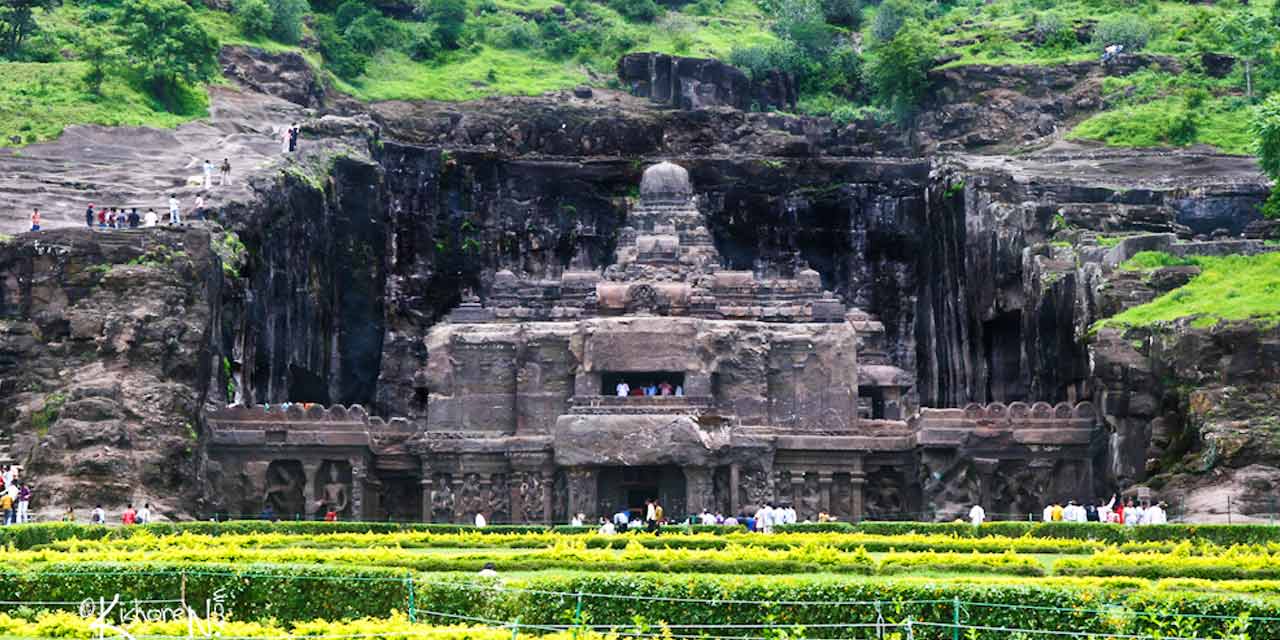
Ellora Caves Aurangabad Entry Fee
- 40 per person for Indians
- 40 per person for visitors from SAARC countries
- 600 per person for Foreign tourists
- 25 for Video Camera
- 30 Parking fee for Car
Ellora Caves Aurangabad Phone
0240 234 3169, 0240 233 1217.

Ellora Caves Aurangabad Address : Ellora Cave Road, Ellora , Aurangabad , Maharashtra , 431005 , India
Aurangabad Tour Packages

Ellora Caves Aurangabad Timings
Ellora Caves is a UNESCO World Heritage Site in India with a group of Hindu, Buddhist and Jain rock-cut caves. It’s a complex of around 100 caves with intricate carvings and sculptures. The most famous of the caves is a monument called the Kailasa Temple. It’s a massive monolithic structure carved out of a single rock.
The caves have always been a holy spot, generally under the name of Verul. They’ve attracted pilgrims throughout the centuries and continue to do so, even today. The inscriptions and carvings in Ellora Caves depict various aspects of Buddhism, Hinduism, and Jainism.
These caves are considered to be built when Buddhism was on the decline. The carving began about the same time the nearby Ajanta Caves were abandoned.
These caves are one of the most impressive examples of ancient Indian rock-cut architecture. Out of the 100 caves excavated, 34 are open to the public. These consist of 12 Buddhist caves (1–12), 17 Hindu caves (13–29) and 5 Jain caves (30–34). And these are a must-see for anyone interested in the history and culture of India.
Hinduism was beginning to establish its prominence during the period. And religious harmony existed across the region. The caves were built close to one another, depicting that harmony.
Where is Ellora Caves situated?
Ellora Caves is in Aurangabad, 29 km from the city. It’s one of the largest rock-cut cave temple complexes in the world. Many caves served as temples, while others were monasteries and rest stops. Ellora Caves Aurangabad was also an important commercial center in the region.
Image Gallery of Ellora Caves Aurangabad
Significance of ellora caves.
Ellora Caves is an impressive amalgam of Buddhist, Hindu, and Jain cave temples. The caves include Buddhist chaityas and viharas, Hindu temples and Jain shrines. Thus, Ellora Caves is a symbol of religious harmony, symphony and synchronicity of the period.
It illustrates the spirit of tolerance that was characteristic of ancient India. Ellora cave complex is also known for its unique artistic creation and technological wisdom. And thus, Ellora was declared a World Heritage Site in 1983 by UNESCO.
Ellora Caves Kailash Temple is the most celebrated feature here. But the site has many more caves and sculptures. A 15-meter-tall statue of Lord Buddha is another striking feature.
This uninterrupted sequence of cave monuments brings to life the civilization living between the 6th and the 10th centuries. Some texts also suggest that the caves were inhabited for a long time even afterwards.
Architecture of Ellora Caves
Ellora Caves architecture has a broad range of typologies and techniques. It has a significant influence on rock-cut practices at different places in Western Deccan, along with structural activities in southern India.
In general, caves in Ellora are a transition from the last phase in the rock-cut style to the emerging free-standing structural architecture. These play a significant role in the evolution of Indian temple architecture.
The earliest sanctuaries have simple layouts. They have small halls without columns in front of the shrine. And the door frames and columns are generally unadorned.
As the construction progressed, later caves had porches with sub-shrines. There also are circumambulatory passageways around the main sanctum. Also, the door frames and column shafts are seen to be ornate.
Then, the monolithic structures like Kailasa Temple, Chhota Kailasa and Indra Sabha seem to imitate constructed buildings. These were free-standing temples with open porches and enclosed mandapas, apart from shrines.
Kailasa Temple (Cave 16), carved out of a single rock, is designed to resemble Shiva’s abode: Mount Kailash. Most of the early Hindu caves were dedicated to Lord Shiva.
You’ll notice the typical features of a Hindu temple: the sanctum housing the lingam, a space for circumambulation, an assembly hall and a gateway.
The mandapa is supported by a Dravidian shikhara and 16 pillars. And a Nandi statue sits in front of the temple. Artisans from various regions of India appear to have worked here. Kailasa Temple is like an encyclopedia of Indian cave architecture.
Ellora Caves and Kailasa Temple synthesize the long tradition of cave carving in western India, Deccan and southern India.
The Buddhist caves on the premises feature monasteries and shrines. The Vishvakarma Cave (Cave 10) is the most notable. It’s a dedicated prayer house, and inside you’ll find a 15-foot statue of Buddha resting in a preaching pose.
The Jain caves in Ellora are smaller than the Hindu and Buddhist caves. These caves have architectural attributes such as mandapa and a pillared veranda.
Chhota Kailasa (Cave 30), designed like Kailasa Temple, is the most-visited Jain temple in Ellora Caves. Indra Sabha (Cave 32) is also well-known. It’s the largest and finest of all.
History of Ellora Caves
Ellora Caves' history is four centuries long. Although the timelines of cave excavations aren’t clear, it’s believed that a part of the Hindu caves and Buddhist caves were built during the Rashtrakuta dynasty. The Jain caves are considered to be built during the Yadava rule.
The caves were built over a period of 400 years, from the 6th to 10th centuries CE. The site has over 100 caves, but only 34 of them are open to the public. While the caves had religious importance, they also served as lodgings to the monks and traders.
The Buddhist caves (1 to 12) are said to be excavated between the 6th and 8th centuries. And the Jain caves (30 to 34) were excavated between the 9th and 12th centuries.
The Hindu caves were excavated in two phases. Some of these were excavated even before the Buddhist or Jain caves. Nine caves (17 to 25) were excavated early in the 6th century, followed by four more (26 to 29). The other Hindu caves (13 to 16) were built between the 7th and 10th centuries.
Things to do at Ellora Caves
1. Checking out Hindu temples – Among the Ellora Caves list, caves 13 to 29 are Hindu caves. The most prominent ones are Cave 15 (Dasavatara), Cave 16 (Kailasa Temple) and Cave 21 (Rameswara). Kailasa Temple is known for its rock-cut splendour, Dasavatara Cave mainly depicts Lord Shiva and Lord Vishnu in various forms, and Rameswara Cave is famous for its sculptural representations. Cave 29 (Dumar Lena) is also popular. It’s by the side of Sita-Ki-Nahani, a small pool created by a waterfall from River Elaganga.
2. Checking out Buddhist monasteries – Ellora Caves Buddhist monasteries are from caves 1 to 12. Amongst those caves, Cave 10 (Viswakarma), Cave 11 (Do Tal) and Cave 12 (Teen Tal) are the impressive ones. Viswakarma Cave is a shrine with a tall stupa of Buddha, Do Tal is a two-storey monastery, and Teen Tal is a three-storey monastery. All Buddhist caves are carved with paintings and sculptures of Buddha and symbols of Buddhist mythology.
3. Checking out Jain shrines – Jain caves in Ellora are caves 30 to 34. The most remarkable of the shrines are Cave 30 (Chhota Kailasa), Cave 32 (Indra Sabha) and Cave 33 (Jagannath Sabha). Chhota Kailasa is like an unfinished replica of the Hindu Kailasa Temple, Indra Shabha is a series of Jain shrines, and Jagannath Sabha has some well-preserved sculptures. All Jain caves are carved with fine and delicate sculptures and have paintings dedicated to the Digambara sect.
4. Exploring Kailasa Temple – Kailasa Temple is an ancient rock-cut temple complex with a shrine dedicated to Lord Shiva. It has a huge monolithic Shivalinga. The temple has sculptures depicting events from the Hindu epics Ramayana and Mahabharata. The entire temple base, walls and ceiling have been decorated with delicate and elaborate carvings. And like all Shiva temples, a Nandi statue sits on the porch in front of the central shrine. The entire work was done with just basic tools like chisels and hammers.
5. Visiting Grishneshwar Temple – Grishneshwar Temple is a Hindu temple dedicated to Lord Shiva. It’s a well-known jyotirlinga near Ajanta Ellora Caves. It’s a revered place of pilgrimage at Verul village, located at a distance of about a km from Ellora Caves. Many pilgrims gather at the temple during the Mahashivratri festival. The water that flows from inside the temple is also considered holy.
Ellora Caves Timings and Entry Fee
The opening time of Ellora Caves is from sunrise to sunset, from 6 AM to 6 PM. Except for Tuesdays, you can visit it any day of the week. It’s open throughout the year.
Ellora Caves’ entry fee for Indian nationals and visitors from the SAARC countries is ₹40. For tourists from other nations, the Ellora Caves entrance fee is ₹600. Kids (below 15 years of age) can get free entry to the caves.
The camera is also charged at ₹25.
Best time to visit Ellora Caves
You can visit Ajanta Ellora Caves at any time except for the peak summer months. It’s in May and June when the weather can be unbearable, especially in the daytime.
Winter is the best time to visit Ellora Caves. The temperature sees a moderate drop during the winter months, from November to February, and it’s charming. Monsoon (August and September) is also ideal for the visit. The region receives plenty of rain showers, and it’s a delight to check the intricate details of Ellora Caves in those times.
Time to explore Ellora Caves
The time required to see Ellora Caves is about 2 hours. It’s ample time to explore the must-see caves in Ellora. If you want to explore all the caves in detail, you might need an hour or two more.
Also, it takes an hour to reach Ellora Caves from Aurangabad, the nearest city. So, it’s best to have a half-day free for a visit.
Things to keep in mind while visiting Ellora Caves
- Ellora Caves is a religious place for local people.
- People with health conditions and disabilities should avoid visiting.
- Visit the caves early morning or late afternoon to avoid the crowd.
- Carry a bottle of water and some light snacks.
- Dress modestly while visiting the site.
- Take your hat and sunscreen.
- Wear light and comfortable clothing.
- Wear walking shoes ideal for uneven surfaces.
- Watch your steps, as the floors can be uneven.
- Photography may not be allowed inside some caves.
- Read up about the importance of Ellora Caves before you visit.
- Hire an Ellora Caves guide for an enjoyable tour.
- Behave appropriately, not disrespecting any culture.
- Be mindful not to damage any sculpture or structure.
- Keep an insect/mosquito repellent handy.
How to reach Ellora Caves?
Ellora Caves are situated in Aurangabad, about 29 km from the city. The nearest domestic airport, railway station and bus stop are in Aurangabad itself. The nearest international airport is in Mumbai, though, 426 km away.
And here’s how to reach Ellora Caves from different places:
Reach Ellora Caves from Aurangabad
Aurangabad is the nearest city to Ellora Caves’ world heritage site, 29 km away. And following are the different ways to reach Ellora Caves from Aurangabad:
By bus – You can find a bus from Aurangabad to Ellora Caves easily. State-run buses, as well as private buses, run from the central bus stand and CIDCO bus stand. They drop you close to the entrance of Ellora Caves.
By auto-rickshaws – Auto-rickshaws are available all over Aurangabad. You can hire one to take you to the Ellora Caves site, about 30 km away. However, they might not be available to hire for your return trip from the caves.
By cab/taxi – Cabs and taxis are the best way to get from Aurangabad to Ellora Caves. They take less than an hour to cover the 30 km distance. You can hire a cab from the top car rentals in Aurangabad and explore all the places to visit near Ellora Caves.
Reach Ellora Caves from Mumbai
Mumbai to Ellora Caves distance is 332 km. And following are the different ways to reach Ellora Caves from Mumbai:
By train – You can take a trip from Mumbai to Ajanta Ellora Caves by train easily. Aurangabad is the railway station near Ellora Caves. From the railway station, go to the government bus stand and take a bus to the caves.
By bus – Regular buses from Mumbai to Aurangabad are available. From Aurangabad, take a bus to Ellora Caves. Special buses for Mumbai to Ellora Caves tour for groups also run from time to time.
By cab/taxi – Mumbai to Ajanta Ellora Caves road trip is the best way to explore the caves. You can hire a cab from the top car rentals in Mumbai and explore all the places near Ellora Caves. The cabs take about 7 hours to cover the 330 km distance.
Reach Ellora Caves from Pune
The distance from Pune to Ellora Caves is 260 km. And following are the different ways to reach Ellora Caves from Pune:
By train – Pune to Ellora Caves trains run regularly to Aurangabad. From Aurangabad railway station, go to the government bus stand for a bus to Ellora Caves. They drop you at the entrance of the cave site.
By bus – Regular buses to Aurangabad are available from Pune. And from the Aurangabad bus stop, you can take a bus to Ellora Caves. Special group tour buses are also available for Ellora Caves from Pune sometimes.
By cab/taxi – The best way to visit Ellora caves from Pune is in a private car or taxi. They take about 6 hours for the 260 km distance. You can hire a cab from the top car rentals in Pune and explore nearby places.
FAQs about Ellora Caves
Make the best of your Aurangabad Tour by booking a Aurangabad Tour package with us. We at Aurangabad Tourism offer these packages at pocket friendly prices while covering all the popular places to visit in Aurangabad in the comfort of a private cab. Please fill the Contact Us form to know more about us.
Location Map for Ellora Caves Aurangabad
Excited About Aurangabad?
Request A Call Back!
Popular Tourist Places to Visit in Aurangabad
- Ellora Caves Aurangabad
- Ajanta Caves Aurangabad
- Aurangabad Caves
- Bhadra Maruti Temple Aurangabad
- Bibi Ka Maqbara Aurangabad
- Jain Temple Aurangabad
- Chand Minar Aurangabad
- Panchakki Aurangabad
- Salim Ali Lake Aurangabad
- Soneri Mahal Aurangabad
- Goga Baba Hill Aurangabad
- History Museum Aurangabad
- Jama Mosque Aurangabad
- Himayat Baugh Aurangabad
- Paithani Silk Weaving Center Aurangabad
- Shahi Sunheri Masjid Aurangabad
- Kala Darwaza Aurangabad
- Makai Gate Aurangabad
- Roshan Gate Aurangabad
- Shahganj Masjid T.T.S Aurangabad
- Ahilyabai Holkar Square Aurangabad
- Delhi Gate Aurangabad
- Rangeen Darwaza Aurangabad
- Pitalkhora Buddhist Caves Aurangabad
- Barapulla Gate Aurangabad
- Dargah of Pir Ismail Aurangabad
- Mhaismal Aurangabad
- Devagiri / Daulatabad Fort Aurangabad
- H2O Water Park Aurangabad
- Dargah Baba Shah Musafir Aurangabad
- Khuldabad Aurangabad
- Bhangshi Mata Gad Aurangabad
- Nipat Niranjan Temple Aurangabad
- Siddharth Garden and Zoo Aurangabad
- Siddhi Vinayak Ganpati Mandir Aurangabad
- Grishneshwar Jyotirlinga Temple Aurangabad
- Chatrapati Shivaji Maharaj Statue Aurangabad
- Chhatrapati Shivaji Maharaj Museum Aurangabad
Take advantage of the search to browse through the World Heritage Centre information.
Share on social media
Unesco social media, ellora caves.
- Description
These 34 monasteries and temples, extending over more than 2 km, were dug side by side in the wall of a high basalt cliff, not far from Aurangabad, in Maharashtra. Ellora, with its uninterrupted sequence of monuments dating from A.D. 600 to 1000, brings the civilization of ancient India to life. Not only is the Ellora complex a unique artistic creation and a technological exploit but, with its sanctuaries devoted to Buddhism, Hinduism and Jainism, it illustrates the spirit of tolerance that was characteristic of ancient India.
Description is available under license CC-BY-SA IGO 3.0
Grottes d'Ellora
Trente-quatre monastères et temples ont été creusés en succession serrée dans la paroi d'une haute falaise basaltique, non loin d'Aurangabad, contribuant à faire revivre une brillante civilisation ancienne dans une séquence ininterrompue de monuments datables de 600 à 1000. L'ensemble d'Ellora est une réalisation artistique unique et un tour de force technique. Avec ses sanctuaires consacrés respectivement au bouddhisme, au brahmanisme et au jaïnisme, il illustre l'esprit de tolérance caractéristique de l'Inde ancienne.
تمّ حفر أربعة وثلاثين ديراً ومعبداً تباعاً في جدار جُرف عال بزلتيّ لا يبعد عن أورانغباد، مما ساهم في إعادة إنعاش حضارة لامعة قديمة في تسلسل متواصل من النصب التذكارية العائدة لفترة تتراوح بين عامي600 و1000. وتشكّل مجموعة إلورا إنجازاً فنياً فريداً من نوعه وقوةً تقنيةً تتطلّب الجهد. ويجسد الكهف بمعابده المخصّصة على التوالي للبوذية والبرهمانية واليانية (إحدى الديانات الهندية القديمة) روح التسامح التي تميزت بها الهند القديمة.
source: UNESCO/CPE Description is available under license CC-BY-SA IGO 3.0
埃洛拉石窟群位于马哈拉施特拉邦(Maharashtra),离奥兰加巴德不远。高高的陡峭玄武岩壁上,34座洞穴庙宇被开凿出来,一座挨一座,延伸2000多米。这些保存完好、排列有序的遗迹可追溯到公元600年至1000年,它们生动完好地再现了古印度文明。埃洛拉石窟群不仅艺术造型独特,技术水准高超,而且作为佛教、婆罗门教和耆那教的圣殿,它们是古代印度容忍、宽恕特性的精神体现。
Grutas de Ellora
Situados cerca de Aurangabad (Estado de Maharashtra), los 34 monasterios y templos de este sitio se alinean, uno junto a otro, a lo largo de 2 km, en la pared del alto farallón basáltico en la que fueron excavados. El sitio hace revivir la antigua civilización de la India gracias a la secuencia ininterrumpida de sus monumentos, que datan de los siglos VII a XI. La realización de este conjunto monumental de calidad artística excepcional fue una verdadera proeza técnica. Con sus santuarios budistas, brahmánicos y jainistas, Ellora ilustra también el espíritu de tolerancia característico de la India antigua. Su ininterrumpida secuencia de creación, que se extiende desde el año 600 al 1000, es una brillante muestra de esa civilización.
source: NFUAJ
Grotten van Ellora
In een gebied niet ver van Aurangabad in de staat Maharashtra, zijn 34 kloosters en tempels uit een hoge basaltrots gehakt. Het gebied beslaat een lengte van iets meer dan 2 kilometer. Deze grotten van Ellora zijn het bewijs van unieke artistieke creaties en technische hoogstandjes. Daarnaast illustreren ze met hun heiligdommen gewijd aan het boeddhisme, hindoeïsme en jaïnisme ook de tolerantie die zo kenmerkend was voor het India van toen. Ellora brengt met haar ononderbroken opeenvolging van monumenten daterend van 600 tot 1.000 voor Christus, de beschaving van het klassieke India weer tot leven.
Source: unesco.nl
एलोरा की गुफाएं
महाराष्ट्र के औरंगाबाद से थोड़ी ही दूरी पर 2 किमी के क्षेत्र में फैले हुए, ये 34 मठ-मंदिर एक ऊंची बेसाल्ट चट्टान की दीवार को काटकर साथ-साथ ही बनाए गए हैं। 600 से लेकर 1000 ईस्वी काल के दौरान एक के बाद एक बने स्मारकों से समृद्ध एलोरा, प्राचीन भारत की सभ्यता को जीवंत करता है। एलोरा परिसर, न केवल एक अद्वितीय कलात्मक रचना और तकनीकी कार्य है, अपितु यह बौद्ध, हिंदू और जैन धर्म को समर्पित अपने मठ-मंदिरों के साथ सहिष्णुता की उस भावना को भी पूरी तरह से दर्शाता है, जो प्राचीन भारत की विशेषता थी।
Source: India
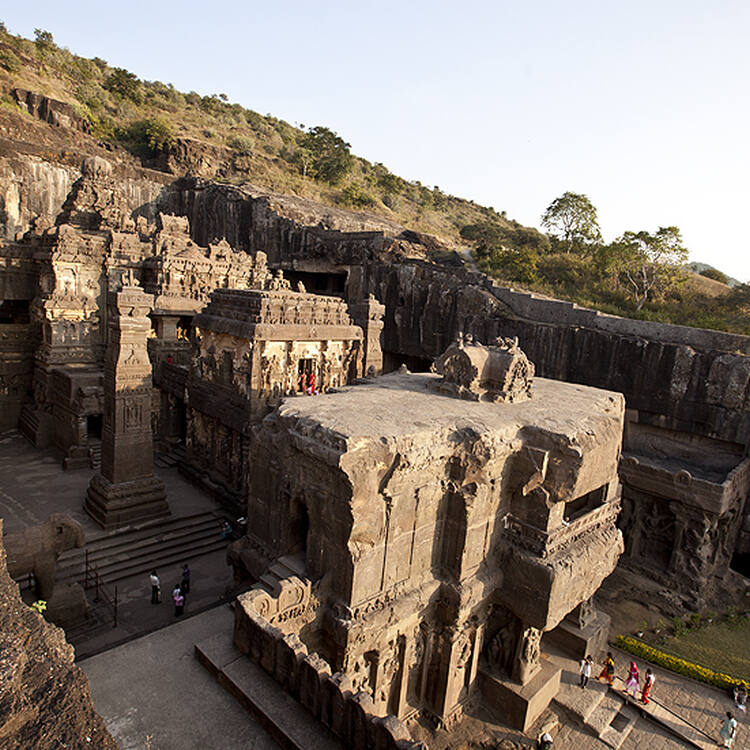
Outstanding Universal Value
Brief synthesis
The invaluable ensemble of 34 caves at Ellora in the Charanandri hills of western India’s Maharashtra State showcases a spirit of co-existence and religious tolerance through the outstanding architectural activities carried out by the followers of three prominent religions: Buddhism, Brahmanism, and Jainism. The rock-cut activity was carried out in three phases from the 6th century to the 12th century. The earliest caves (caves 1–12), excavated between the 5th and 8th centuries, reflect the Mahayana philosophy of Buddhism then prevalent in this region. The Brahmanical group of caves (caves 13–29), including the renowned Kailasa temple (cave 16), was excavated between the 7th and 10th centuries. The last phase, between the 9th and 12th centuries, saw the excavation of a group of caves (caves 30–34) reflecting Jaina philosophy.
Amongst the caves of the Buddhist group, Cave 10 (Visvakarma or Sutar-ki-jhopari, the Carpenter’s cave), Cave 11, and Cave 12 (Teen Tal, or three-storied monastery, the largest in this category) are particularly important. These caves mark the development of the Vajrayana form of Buddhism and represent a host of Buddhist deities. The prominent caves of the Brahmanical group are Cave 15 (Dasavatara, or Cave of Ten Incarnations), Cave 16 (Kailasa, the largest monolithic temple), Cave 21 (Ramesvara), and Cave 29 (Dumar Lena). Amongst these, Cave 16 is an excellent example of structural innovation, and marks the culmination of rock-cut architecture in India featuring elaborate workmanship and striking proportions. The temple is decorated with some of the boldest and finest sculptural compositions to be found in India. The sculpture depicting Ravana attempting to lift Mount Kailasa, the abode of Siva, is especially noteworthy. The remains of beautiful paintings belonging to different periods are preserved on the ceilings of the front mandapa (pillared hall) of this temple. The Jaina group of caves (caves 30 – 34) is exquisitely carved with fine, delicate sculptures, and includes fine paintings dedicated to the Digambara sect. Through their art and architecture, the Ellora Caves serve as a window to ancient India, including socio-cultural phenomena, material culture, politics, and lifestyles.
Criterion (i): The ensemble of Ellora is a unique artistic achievement, a masterpiece of human creative genius. If one considers only the work of excavating the rock, a monument such as the Kailasa Temple is a technological exploit without equal. However, this temple, which transposes models from “constructed” architecture, offers an extraordinary repertory of sculpted and painted forms of a very high plastic quality and an encyclopaedic program.
Criterion (iii): Ellora brings to life again the civilization of ancient India with its uninterrupted sequence of monuments from AD 600 to 1000.
Criterion (vi): The Ellora Caves not only bear witness to three great religions, i.e. Buddhism, Brahmanism, and Jainism, they illustrate the spirit of tolerance, characteristic of ancient India, which permitted these three religions to establish their sanctuaries and their communities in a single place, which thus served to reinforce its universal value.
Ellora Caves includes all the elements necessary to express its Outstanding Universal Value, including the architectural and sculptural elements that bear witness to Buddhism, Brahmanism, and Jainism in an uninterrupted sequence of monuments from AD 600 to 1000. The property, which encompasses the ensemble along with its natural setting, is of adequate size to ensure the complete representation of features and processes that convey the property’s significance, and does not suffer from adverse effects of development and/or neglect. Identified potential threats to the integrity of the property include visitor and environmental management, seepage and cracking in the caves, and the capacity of conservation staff at the property.
Authenticity
The authenticity of Ellora Caves is expressed through the architectural forms and designs such as the viharas (monasteries), chaityagriha (sanctuary), and monolithic temples belonging to three different faiths. The materials, locations, and natural setting also play significant roles in determining the authenticity of the property. The Ellora Caves are authentic in terms of the forms and designs, materials and substance, and locations and setting of paintings, rock-cut architecture, sculptures, and unfinished temples of three different faiths, i.e. Buddhism, Brahmanism, and Jainism.
Protection and management requirements
The management of the Ellora Caves is carried out by the Archaeological Survey of India (ASI), while the buffer zones are jointly managed by the ASI, the Forest Department, and the Government of Maharashtra. Various legislation, including the Ancient Monuments and Archaeological Sites and Remains Act (1958) and its Rules (1959), Ancient Monuments and Archaeological Sites and Remains (Amendment and Validation) Act (2010), Forest Act (1927), Forest Conservation Act (1980), Municipal Councils, Nagar Panchayats and Industrial Townships Act, Maharashtra (1965), and Regional and Town Planning Act, Maharashtra (1966), governs the overall administration of the property and its buffer zones. A detailed condition survey of all caves has been undertaken as a part of the Comprehensive Conservation Management Plan and implementation is underway.
Sustaining the Outstanding Universal Value of the property over time will require developing and implementing a framework to address issues such as visitor management as well as environment management; long-term monitoring for seepage and cracking patterns in all the caves; and capacity building of conservation staff at the property, with the objective of ensuring the long-term protection of attributes that sustain the Outstanding Universal Value, integrity and authenticity of the property.
- Ajanta and Ellora Caves
The Nomination files produced by the States Parties are published by the World Heritage Centre at its website and/or in working documents in order to ensure transparency, access to information and to facilitate the preparations of comparative analysis by other nominating States Parties.
The sole responsibility for the content of each Nomination file lies with the State Party concerned. The publication of the Nomination file, including the maps and names, does not imply the expression of any opinion whatsoever of the World Heritage Committee or of the Secretariat of UNESCO concerning the history or legal status of any country, territory, city or area or of its boundaries.
State of Conservation (SOC)

How to Visit Ellora Caves in Maharashtra
LAST UPDATED: 29th February 2024
The magnificent and spiritual Ellora Caves in Maharashtra is a monolithic collection of ornate caverns that have been carved into the towering volcanic basalt cliffs of the Charanandri Hills.
Let’s explore their enthralling history and how to visit Ellora Caves .
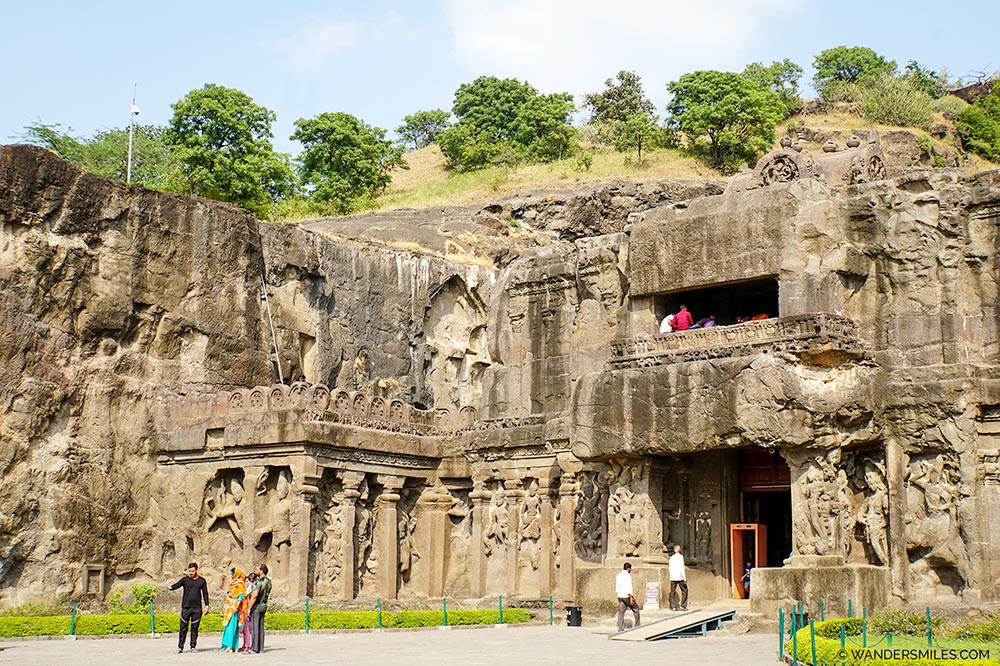
History Of Ellora Caves
Travellers visiting Maharashtra State, a stunning region of India, should make every effort to experience the wonder of these fascinating and beautiful examples of art, culture, religion and engineering. Located only 30km from Aurangabad, there are 34 cave temples to explore across a 2 km site at Ellora Caves.
Dating from between 600 and 1000 CE the caves are now a UNESCO world heritage site and they tell the story of the harmony between religious faiths during these times. Ellora’s rock-cut cave complex was the home and place of worship for Hindu, Buddhist, and Jain monks.
Excavated during the Rashtrakuta and Yadavas dynasties, the caves were an important site of devotional pilgrimage and a welcome resting stop for weary merchants travelling along the South Asian trade route.
The Monolithic Architecture Of Ellora Caves
The Ellora caves are an incredible example of how people of multiple faiths can live, worship and peacefully co-exist. Remarkably well preserved, in some places the original paint and plaster are visible, Ellora is full of jaw-dropping and thought-provoking ancient treasures.
Hindu Monuments
Archaeologists believe that some of Ellora’s Hindu caves are the most ancient examples on the site with construction beginning around 550 CE. There was also the second phase of Hindu monuments built between 730 and 950 CE.
The imposing Kailasa Temple is the most popular sight at Ellora and it is the biggest individual monolithic structure in the world. Hewn out of a single piece of rock the architecture is classic Dravidian (a style native to southern India and Sri Lanka) and is dedicated to the life of Lord Shiva.
The craftsmen and artists who created this temple will have needed to move 200,000 tonnes of rock to begin creating the intricate details and bold depictions of deities, idols and animals such as elephants.
Towering over awe-struck pilgrims this two-storey cave is an imaginative depiction of Shiva’s home, Mount Kailash. It’s a truly wonderful place where every inch of carved rock reveals another vivid moment in the story of this powerful Hindu God.

Buddhist Monuments
The southernmost caves are Buddhist. There are domestic quarters such as sleeping cells and kitchens for monks and shrines to Buddha and Bodhisattvas (important individuals on the path to Buddhahood).
Cave 10, Vishvakarma Cave is also known as the Carpenter’s Cave, a name given to celebrate the amazing way the rock has been expertly worked to make it look like curved wooden beams in the ceiling.
A splendid Stupa (shrine) to Buddha and his reincarnations dominates the top floor of Cave 12. It is simply mind-boggling to imagine that thousands of years ago, Indian Buddhists gathered in peaceful prayer exactly where you’re standing.
Tourists in the Buddhist part of Ellora Caves often report feeling calm, a serenity that would thrill the original architects as the stone edifices and beautifully carved friezes were designed with the transcendent state of blissful Nirvana in mind.

Jain Monuments
Five of the Ellora Caves are dedicated to the Jain faith, a religion with ‘self-help’ and non-violence at its core. Situated in the north of the area, these caves are smaller and newer than the rest having been built in the 9th and 10th centuries by the Digambara sect.
The Jainist religious philosophies are explained throughout the caves with intricate artworks, bold statues, and gorgeous, detailed carvings. Self-discipline and avoidance of indulgence may be a key part of the Jain lifestyle, but their caves are still exquisite!
Cave 30, the Chota Kailasha is a smaller version of the Hindu cave and is decorated with two huge wall reliefs of the god Indra dancing, each wild flail of his arms is pictured.
The Indra Sabha, Cave 32, has a ceiling adorned with a symbolic lotus flower and honours Indra Sabha, the most important deity of the Jain faith.
Evidence of active worship has also been found in this cave, which brings to life a realisation that these places we gaze in awe at, were once places where our ancestors went about their everyday lives.
FAQs To Visit Ellora Caves
How do you get to ellora caves.
Ellora Caves are in the state of Maharashtra in western India. The village of Ellora is close by and the city of Aurangabad is 30 km (19 miles) away.
Many tourists also explore the Ajanta Caves when they are in this area. The mere 80 km (50 miles) distance between the sites would allow for a fantastic two-day trip.
- FLIGHTS – There are regular flights to Aurangabad Airport from Mumbai, Delhi, and Hyderabad.
- PRIVATE TAXIS – The journey from Aurangabad to Ellora Caves will take an hour each way and cost around INR 1000.
- PUBLIC BUSES – A good option as they leave every 30 minutes from the Central Bus Station. However, some routes will only stop at Ellora Village so be ready for a short 2km walk to the caves. There are shuttle buses on hand to transport tourists around the site available for INR 22.
How Much Does Ellora Caves Cost?
If you haven’t booked a tour, the entry fee to visit Ellora Caves is INR 40 for locals and INR 600 for foreigners. Children under 15 are free.
Ellora Caves Tourist Information Centre sells tickets and an audio-visual guide in various languages. Do have rupees handy if this is your plan as the card machine is unreliable at best!
What Are The Opening Times Of Ellora Caves?
Officially, the Ellora Caves’ hours of opening are from sunrise to sunset but generally, this translates to mean 8 am until 5.30 pm. You can visit every day other than Tuesdays when the site is closed.
There is plenty to enjoy in these spectacular caverns. If you are keen to discover as much as possible there is quite a bit of walking to do, so arrive early and bring plenty of drinks and snacks.
TOP TIP: stay hydrated with peace of mind: Use a water purifying bottle so you can fill from any tap on your travels. Get your WATER-TO-GO Bottle with 15% OFF (Code WM15)
What Is The Best Time To Visit Ellora Caves?
Weekends are very busy so try and visit on a weekday.
We recommend a journey to Ellora Caves between November and March. This is when the weather is most favourable to an all-day outdoor exploration.
The Ellora Festival of Classical Dance and Music is an annual event in the third week of March. It’s an awesome feast for the ears and eyes and well worth planning your visit around.
What Facilities Are At Ellora Caves?
Ellora Caves is a great day out as there is a car park, shuttle buses (with no AC so be prepared to cook!) places to eat and drink, souvenir shops, and auditoriums where informational talks are held.
|| You May Also Like
- INCREDIBLE CAVE TEMPLES IN INDIA
- HOW TO VISIT AJANTA CAVES
- VISIT ELEPHANTA CAVES
- HOLI IN VARANASI
- CELEBRATING DIWALI IN JAIPUR
- UTTARAYAN KITE FESTIVAL IN JAIPUR
- TAJ MAHAL GUIDE
Useful Links For Your Ellora Caves Trip
Ready to get planning your trip to visit Ellora Caves? Here are some useful links to finding great places to stay, finding tours, and insurance. These are companies I have used and can recommend with confidence.
Accommodation For Ellora Caves
- Find the best hotel deals in Aurangabad on Booking.com
- Read Aurangabad hotel reviews on Tripadvisor
Transport For Ellora Caves
- Find amazing flight deals with Skyscanner
- Get your airport transfer booked from any Aurangabad airport
Best Tours For Ellora Caves
- Ellora and Ajanta Caves in 1 Day Guided Tour
- Aurangabad: Full-Day Tour of Ajanta and Ellora Caves
- 2-Days Ajanta & Ellora Caves Private Tour With Guide And Car
Best Insurance For Ellora Caves
Get 5% off your travel insurance with HeyMondo . Benefit from 24-hour medical assistance, 365
- GET 5% OFF with HeyMondo Travel Insurance
- GET 5% OFF with IATI Travel Insurance
- REMOTE WORKERS & NOMADS: SafetyWing
PIN FOR LATER – VISIT ELLORA CAVES

Disclosure : This post contains affiliate links, which means I may receive a small commission if you click a link and purchase something that I’ve recommended. It comes at no cost to you. Thank you for your support.

I'm a content creator for She Wanders Miles ♡ Digital marketer, photographer, hiker, and nature lover ♡ Passion for slow, sustainable and responsible travel ♡ Join me in discovering our beautiful world across 7 continents.
Similar Posts

Rove City Centre | Dubai’s Affordable Cool Hotel

3 Days in Dorset | Best Itinerary To Follow

Best Things To Do around Ullswater | Where to Stay & Eat

How To Spend One Day in Bogota Colombia

How To Plan a Sustainable + Ethical African Safari
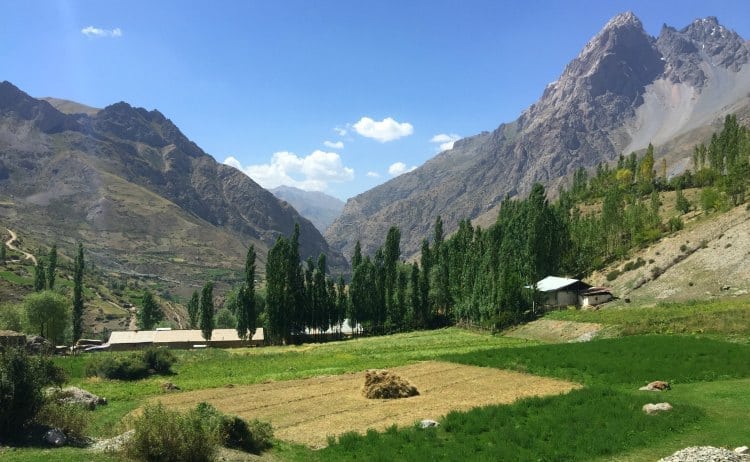
Hiking in Shirkent Valley & Yagnob | Tajikistan
Ellora Caves are are best place to visit in Aurangabad. Ellora Caves are dedicated to the Jain faith, and are fascinating.
Ellora Caves are a mist-visit!
Leave a Reply Cancel reply
Your email address will not be published. Required fields are marked *
Search Flights X
- Ellora Caves
Book Ellora Caves Tickets Online
- Information
- forenoon afternoon
- Monuments of India
- Monuments in Aurangabad
About Ellora Caves
A whiff of the antiquated mystery sits heavy in the air on the 2 km long stretch of what must have been an arduous task of carving these magnificent caves out of rocks. One of the largest ancient rock-cut cave temples in the world, Ellora Caves are a UNESCO World Heritage Site. A confluence of ideas and shared creative intensities gave shape to one of the most stupendous works of art in the ancient India.
Ellora Caves Information
Ellora caves history.
Built during 600 to 1000 CE, Ellora Caves lie in the Sahyadri hills in Aurangabad and is a 2-hour drive from the Ajanta Caves . The Ellora Caves comprise Hindu, Buddhist and Jain temples and over a 100 caves with only 34 open to the public excavated from the basalt cliffs in the Charanandari hills. Ellora Caves served as lodgings to the travelling Buddhist and Jain monks besides being a site for the trade route. There are 17 Hindu caves, 12 Buddhist and five Jain caves with deities, carvings and even monasteries depicting the mythology of each religion. These caves constructed near each other stand for the harmony and solidarity among all faiths and beliefs.
A part of the Hindu and Buddhist Caves were built during the Rashtrakuta dynasty, and the Jain Caves were built by the Yadav dynasty. It is not yet established as to which caves were built first - the Hindu or the Buddhist. Based on the archaeological evidence found at various sites it was deduced that there were essentially three major construction periods for the Ellora caves: early Hindu period from 550 to 600 CE, Buddhist period from 600 to 730 CE, and the final phase, the Jain and Hindu period lasting from 730 to 950 CE.
Ellora Caves Architecture
Although the deities and idols in the caves have been damaged, the paintings, carvings remain as it is. The inscriptions on the walls of the Ellora Caves date back to the 6th century and a famous one is the Rashtrakuta Dantidurga on the mandapa of Cave 15 inscribed during 753 to 757 AD. Out of all the excavations done, Cave 16 or Kailasha temple - a monument dedicated to Shiva is the largest single monolithic rock excavated in the world. It was built during 757-783 AD by Krishna I who was the uncle of Dantidurga.
Built during the 6th to 8th century in the Kalachuris period, the Hindu Caves were built in two phases. Caves 14, 15 , 16 were built in the Rashtrakuta period. The early Hindu caves were dedicated to Shiva with inscriptions depicting the mythology related to other gods as well. A typical attribute of these temples was the lingam-yoni placed in the centre of the shrine.
Kailasha Temple, Cave 16: Carved out of a single rock, this temple is one of its kind in the world. Dedicated to Shiva, the temple is based on Shiva’s abode - Mt Kailash. It comprises the typical features of a Hindu temple namely: the sanctum which houses the lingam-yoni, a space for circumambulation, an assembly hall, a gateway, shrines based on the square pattern. Other shrines in the temple carved out of the same rock are dedicated to Vishnu, Saraswati, Ganga, Vedic and non-Vedic gods. The mandapa is supported by a Dravidian shikhara and16 pillars with a Nandi sitting in front of the temple. It is believed that the artists had to move around 3 million cubic ft stone weighing 200,000 tonnes to excavate the temple. It was built by the Rashtrkuta king, Krishna I.
Situated in the south of the precinct, these caves are estimated to have been built during 600 to 730 CE. It was first believed that the Buddhist Caves were built before the Hindu Caves but this theory was debunked and with enough evidence to substantiate, it was established that the Hindu caves were constructed before the Buddhist came into being. The earliest Buddhist cave to be built was Cave 6, with Cave 11 and 12 being the last. These caves feature monasteries, shrines which include bodhisattvas, and carvings of Buddha.
Vishvakarma Cave, Cave 10: Built around 650 CE the cave is also known as the Carpenter’s Cave because of the finishing of the rock which looks like the wooden beam. Inside the stupa hall, lies the 15 ft statue of Buddha resting in a preaching pose. The cave is the dedicated prayer house among all the caves here and has eight cells and also a portico.
Designed on the same lines as that of the original Kailasha temple or Cave 16 the temple was built in the 9th century along with the Indra Sabha, Cave 32. The temple contains two gigantic statues of Indra, one an eight-armed and the other a 12-armed and in dancing pose. The number of arms depicts Indra’s poses during the dance. The cave also features other deities, and dancers.
Ellora Caves Timings
Ellora Caves opening hours are sunrise to sunset. The timings for Ellora Caves are 8 in the morning till 5.30 in the evening.
Ellora Caves Location
Situated in the northern Maharashtra, Ellora Caves are 400 km from Mumbai. The Ellora Caves address is Ellora Cave Road, Ellora, Aurangabad, Maharashtra 431005.
Ellora Caves Opening Days
Ellora Caves are closed on Tuesdays. The caves can be visited during rest of the week. The best time to visit Ellora Caves is during November to March.
How to Reach Ellora Caves
Situated almost 27 km from Aurangabad city, Ellora Caves can be reached easily via buses and taxis. There are private taxi stands in Aurangabad which offer a trip to the caves and back starting at Rs 1,000 depending on the car type. The drive will take you around an hour to reach the caves. The Maharashtra State Road Transport Corporation ( MSRTC ) operates bus tours to Ellora Caves in AC Volvo coaches. The guided tour buses depart the Central Bus Stand in Aurangabad in the morning and cover other attractions on the route. Alternatively, you can go for the regular state-run buses.
Central Bus Stand in Aurangabad is 27 km from the Ellora Caves.
Aurangabad Railway Station is 28 km from the Ellora Caves. The following are a few trains running to Aurangabad: Sachkhand Express 12716, Tapovan Express 17617, Ajanta express 17063.
Aurangabad Airport is 35 km from the Ellora Caves. It connects Mumbai, Delhi and Hyderabad.
Ellora Caves Online Ticket
The Ellora Caves entry fee for Indians is Rs 40 and even the SAARC and BIMSTEC nationals have to pay Rs 40 as entry ticket to Ellora Caves. The Caves entry ticket for foreigners is Rs 600. There is no Ellora Caves entry ticket price for children up to 15 years. Additionally, you can buy an audio-visual guide at the tourist information centre which also houses eateries, shops, auditoriums, and a parking space.
You can now make the online Ellora Caves ticket booking for yourself, family and friends by logging on to Yatra.com. Visit the website and book Ellora Caves tickets online and reserve your entry to the site from the comfort of your home or office. Not just Ellora Caves, you can book Ajanta Caves, Aurangabad Caves and other monuments in Aurangabad.
Outstanding Universal Value
The Ellora Caves is a historical site located in the Marathwada region of Maharashtra. The caves of this monument are excavations from the Charanandri Hills. These caves were excavated during the rule of Hindu dynasties such as Rashtrakutas and Yadavas. These caves were known to be a resting stop for pilgrims as well as a worshipping site because of its temples and monasteries. These caves were also popular as they were located on the South Asian trade route.
Monument Information
- Accommodation
Contact Details
Ellora Cave Road, Ellora, Aurangabad, Maharashtra 431005
How To Reach
- Nearest Airport : Aurangabad Airport
- Nearest Railway Station : Daulatabad Railway Station
- Nearest Bus Station : Ellora Caves Bus Stop
Opening Hours
- Opening Time : 06:00:00 am
- Closing Time : 06:00:00 pm
Monsoon : Maximum: 30 °C, Minimum: 20 °C
Summer : Maximum: 38°C, Minimum: 22 °C
Winter : Maximum: 22 °C, Minimum: 10 °C
Recommended Season to Visit : Winter Season (October to March)
Facilities available At the Monument
- Visitor circulation path
Accommodation near the monument
- MTDC Ajantra "T " Junction
- More Details ...
- Mr. M.S. Chauhan
- Phone: 91-240-2400620, 2400602
- E-mail: [email protected]
Museums near monument
- - Chhatrapati Shivaji Maharaj Museum
- View Museum Details
Ticket Information

Terms & Conditions
- The e-ticket is not transferable.
- Entry Fee is not refundable.
- E-ticket cancellations are not permitted.
- The Monument is open for visitors between sunrise and sunset.
- Visitor shall be required to show photo identity proof in original at the entry to the monument.
- Edibles are not allowed inside the monument.
- Inflammable/dangerous/explosive articles are not allowed.
Photo Gallery
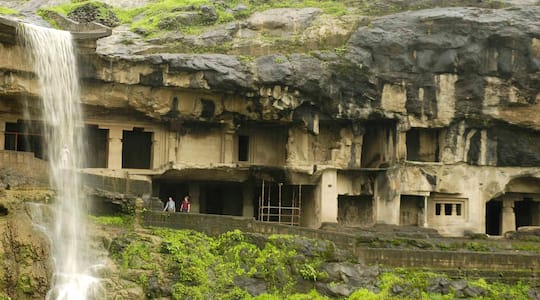
aurangabad Hotel Links
- Hotels in aurangabad
- Resorts in aurangabad
- Couple Hotels in aurangabad
- 5 Star Hotels in aurangabad
- Budget Hotels in aurangabad
- Safe Hotels in aurangabad
- More About Us |
- Leadership Team |
- Our Products |
- Awards Won |
- Customer Testimonials |
- Press Releases
- Company Overview |
- Quarterly Earnings |
- Press Releases |
- Reports & Presentations |
- SEC Filings |
- Corporate Governance |
- Social Media Disclosure |
- Investor FAQs
- Travel Agent Sign Up |
- Become a Cab Vendor |
- Register Your Hotel |
- Register Your Homestay |
- Sell Holiday Packages |
- Sell Your Activities |
- List Your Bus Inventory |
- Advertise With Us
- Support & FAQs |
- Terms & Conditions |
- Privacy Policy |
- User Agreement
- Domestic Airlines |
- Domestic Flights |
- International Airlines |
- SriLankan Airlines |
- Emirates Airlines |
- Saudi Airlines |
- Nepal Airlines |
- Singapore Airlines |
- Malaysia Airlines |
- Indigo Flights |
- Air India Airlines |
- Go Air Airlines |
- Spicejet Flights |
- Airasia Flights |
- International Flights |
- Flight Schedule |
- Airline Flight status |
- Cheap Air tickets |
- Web Checkin |
- Domestic Hotels (In India) |
- Homestays |
- Yatra for Business |
- Yatra for SMEs |
- India Tourism |
- International Tourism |
- Domestic Holiday Packages |
- International Holiday Packages |
- Trade Fairs 2020 |
- Activities |
- Domestic Activities |
- International Activities |
- Bus booking |
- Bus Ticket |
- Indian Railways |
- Check Train PNR Status |
- Monuments of India |
- Taj Mahal |
- Qutub Minar |
- Yatra Android Mobile App |
- Yatra iOS Mobile App |
- Gift Vouchers |
- Dubai Visa |
- Thailand Visa |
- Thailand Business Visa |
- Thailand Tourist Visa |
- Sri Lanka Visa |
- Sri Lanka Business Visa |
- Sri Lanka Tourist Visa |
- Turkey Visa |
- Turkey Business Visa |
- Turkey Tourist Visa |
- Malaysia Visa |
- Hong Kong Visa |
- Vietnam Visa |
- Visa At Your Doorstep |
- Uk Visa At Your Doorstep |
- Delhi to Mumbai Flight |
- Delhi to Patna Flight |
- Delhi to Goa Flight |
- Patna to Delhi Flight |
- Pune to Delhi Flight |
- Bangalore to Varanasi Flight
- Retail Offices |
- Bug Bounty |
- Darjeeling |
- Resorts Near Me |
- Oyo Rooms Near Me |
- Interpack 2020 |
- Drupa 2020 |
- Connect with us :
Copyright © 2022 Yatra Online Limited, India. All rights reserved

- Organisation
- Image Gallery
- Video Gallery
- English -->

Ellora Caves
The Ellora caves, locally known as ‘Verul Leni’ is located on the Aurangabad-Chalisgaon road at a distance of 30 km north-northwest of Aurangabad, the district headquarters. The name Ellora itself inspires everyone as it represents one of the largest rock-hewn monastic-temple complexes in the entire world. Ellora is also world famous for the largest single monolithic excavation in the world, the great Kailasa (Cave 16). The visit to these caves is enjoyed maximum during monsoon, when every stream is filled with rainwater, and the entire environ is lush green. The monsoon is not only a season of rains in this part, the local visitors are attracted to visit these ideal locations to have a glimpse of the mother nature in full bloom.
The caves are hewn out of the volcanic basaltic formation of Maharasthra, known as ‘Deccan Trap’, the term trap being of Scandinavian origin representing the step like formation of the volcanic deposits. The rock formation, on weathering has given rise to the appearance of terraces with flat summits. At Ellora, one can also have a glimpse of the channels (near Cave 32) through which the volcanic lava once flowed. These channels, due to overheating, have a characteristic brownish red colour. Similar rock was used in the construction of the Grishneshwar Temple nearby and also utilised for the flooring of the pathways at Bibi-ka-Maqbara.
The hills in which the caves are hewn, forms part of the Sahyadri ranges of the Deccan and dated to the Cretaceous era of the Geological time scale (about 65 million years ago). The hills rise abruptly from the surrounding plains on the south and west, the western surface being extensively utilised for hewing the cave complexes. The hill also supports several streams, the prominent among them being the Elaganga, which drains into the Shiv, a stream of the Godavari river system. The Elaganga is in its full vigour during the monsoon, when the overflowing waters of a barrage in the upstream near Mahismati allows the gushing waters to land at “Sita-ki-nahani” near Cave 29 as a crashing waterfall.
The volcanic lava flowed during different periods, gave rise to extensive horizontal flows alternating with vesicular trap beds. The vesicular traps formed the upper portion of each of the massive trap beds. The different lava flows also gave rise to vertical as well as horizontal joints in the rock formation. Depending upon the nature and mineralogical content of the lava flow, the rock formations also varied in character and texture, giving rise to various qualities like coarse grained, fine grained formations. The ancient builders at Ellora, like other places, particularly chose the fine grained formations of the Deccan trap, ideal for sculpting and rock hewing. In addition to this, the ancient builders also traced the horizontal and vertical joints in the rock formation to minimise the labour and time during excavation and rock splitting. The basaltic rock is also ideal for rock hewing, as they are soft during the initial excavation and hardens on exposure to environment.
The basaltic formation of the Deccan is ideal for rock hewing, the technique widely understood during ancient times. This induced the religious followers of various creeds to establish their settlements in them. By a rough estimate, there are nearly 1200 caves of varying sizes in the entire Maharashtra, out of which nearly 900 alone belong to Buddhism.
The region is also famous for its antiquity. It has been inhabited since time immemorial, the stone tools belonging to the Upper Palaeolithic (around 10,000 to 20,000 years ago), Mesolithic (less than 10,000 years ago) bearing testimony to this fact. The Chalcolithic remains (2500-1000 BC) in the vicinity also indicates the continuity of human occupation in this region.
The importance of Ellora during the early centuries of the Christian era is also understood by the findings of coins of Satavahanas, the ruling dynasty during the period. The Satavahanas had their capital at Pratishtana (modern Paithan) and ruled the entire area between the Arabian Sea and Bay of Bengal and bordered by the Narmada River on the north. Ellora being located on the ancient trade route connecting the western ports on the Arabian sea like Sopara (Surparaka, the Supara of Greek; Subara of Arab writers; the ancient capital of northern Konkan), Kalyan a thriving port; Chemula, the Samylla of Greek geographers, Chemula of Silaharas, on the island of Trombay and the inland cities like Paithan (Pratishtana), Ter (Tagara), Bhokardan (Bhogavardhana) etc. The fact that Satavahanas traversed this region is attested by their inscriptions at Nasik caves and donor inscriptions of their times at Pital Khora caves, located at a distance of 40 km west of Ellora. Ellora is located directly on the ancient trade route which traversed from Pratishtana via Aurangabad, Ellora, Pital Khora, Patne, Nasika (modern Nasik). Nasik is at the crossroads of an ancient trade route connecting centres on the west to east and those on the north to south.
The location on the ancient trade route did not induce any activities at Ellora during the Satavahana rule. Brisk activities were already on at nearby Pital Khora, Nasik, Ajanta, etc., and this could have been a diversion of the ancient builders to support any activity here. However, as the multiplication of the religious establishments took place in every nook and corner of Maharashtra, the ideal location of Ellora was unavoidable.
Thus grew one of the largest cave excavations at Ellora, that too of three different religious creeds, viz., Buddhism, Brahmanism and Jainism. The caves are datable from circa 6th – 7th century A.D. to 11th – 12th century A.D. In total, there are nearly 100 caves in the hill range out of which 34 caves are famous and visited by many tourists, out of which Caves 1 to 12 are Buddhist; Caves 13 to 29 are Brahmanical and Caves 30 to 34 are Jaina. Two more groups of caves are noticed on the Elaganga and on an upper terrace, namely, the Ganesh Leni and Jogeshwari Leni.
These religious establishments could have received royal patronage from various dynasties, even though inscriptional evidences are lacking for most of them. The only definite inscriptional evidence is that of Rashtrakuta Dantidurga (c. 753-57 A.D.) on the back wall of the front mandapa of Cave 15. The Great Kailasa (Cave 16) is attributed to Krishna I (c. 757-83 A.D.), the successor and uncle of Dantidurga. A copper plate grant from Baroda of the period of Karka II (c. 812-13 A.D.) speaks about the greatness of this edifice. The inscription tells us that this great edifice was built on a hill by Krishnaraja at Elapura (Ellora) and even the celestial beings moving in the sky were struck by its magnificence, as though it was self-existent, not created by mortals, and, even the architect who caused it was wonder struck that he could build it. Apart from the above two inscriptions, the entire cave complexes lack inscriptions of the nature found at other cave sites like that of Ajanta, Nasik, Karle, Kanheri, etc.
In the absence of concrete inscriptional evidence, we can deduce the royal dynasties that could have extended their patronage to the religious establishments. The initiation of religious establishments at Ellora coincides with the departure of the tradition at Ajanta. It is well known that the excavations started here before the Rashtrakutas arrived on the scene and the Caves 1 to 10 and Cave 21 (Ramesvara) were definitely constructed before them. These excavations are generally attributed to the Kalachuris of Mahismati, appeared to have gained control of the region around Nasik and parts of ancient Asmaka (region around Aurangabad) including Bhogavardana (modern Bhokardan) and the Chalukyas of Badami who held their sway in this region for a brief period before their feudatories, the Rashtrakutas took over.
The majority of the Brahmanical establishments and the remaining Buddhist ones can be attributed to the Rashtrakuta times which indicate the religious tolerance of the contemporary period. The Jaina caves definitely post-date the Rashtrakutas as indicated by the style of execution and fragmentary inscriptions. This region was under the control of Kalyani Chalukyas and Yadavas of Deogiri (Daulatabad) during this period. The patronage towards Jainism under the Yadavas is also known by the findings of several sculptures of Jaina faith from Daulatabad. Thus, we have the greatest religious conglomeration at a single place, signifying the religious tolerance and solidarity of different faiths.
The Ellora caves, unlike Ajanta, have a distinction that they were never lost to oblivion, due to their close proximity to the trade route. There have been numerous written records to indicate that these caves were visited regularly by enthused travellers and royal personages as well. The earliest is that of an Arab geographer Al-Mas‘udi of the 10th century A.D. In 1352 A.D. the approach roads to the caves were repaired on the ensuing visit of Sultan Hasan Gangu Bahmani, who also camped at the site and visited the caves. The other important accounts of these caves are by Firishta, Thevenot (1633-67), Niccolao Manucci (1653-1708), Charles Warre Malet (1794), Seely (1824). During the 19th century A.D. these caves were owned by the Holkars of Indore who auctioned for the right of worship and leasing them for religious as well as a form of entrance fee. After the Holkars, these caves passed into the control of Nizams of Hyderabad, who through their Archaeology Department carried out extensive repairs and maintenance of the caves under the guidance of Archaeological Survey of India. The caves are under the maintenance of the Archaeological Survey of India after the reorganisation of states and the dominions of erstwhile Nizams merged into the state of Maharashtra.
A brief account on the architectural splendour and artistic expressions of various caves is given here for enabling one to understand the real character and importance of this wonderful place.
A tourist can plan the visit of these caves according to the time available and depending upon the interest in ancient art. If a visitor has at his disposal three to four hours, then the Cave nos. 10 (Visvakarma Cave), 16 (Kailasa), 21 (Ramesvara) and 32 & 34 (Jaina group of caves) should not be missed. Thus, by visiting these caves, one can have a glimpse of the representative art of Buddhism, Brahmanism and Jainism. If a visitor has an entire day at his disposal, the Cave nos. 2, 5, 10 & 12 of the Buddhist group; Cave nos. 14, 15, 16, 21 & 29 of the Brahmanical group and Caves 32 to 34 of the Jaina group should be visited.
The caves are excavated in the scarp of a large plateau, running in a north-south direction for nearly 2 km, the scarp being in the form of a semi-circle, the Buddhist group at the right arc on the south, while the Jaina group at the left arc on the north and the Brahmanical group at the centre.
- OPENING HOURS -Open from sunrise to sunset(Closed on Tuesday)
Entry Fee: Indian, SAARC and BIMSTEC Countries – Rs. 40 per head. Rs.35/- (Online Payment)
Other Foreign Visitor: Total Rs.600/- Rs. 550/-(Online Payment)

Sorry, we couldn't find anything that matches your search.
Destination

Famous Places to Explore in Hyderabad
A vibrant city with the imposing...

Raipur Tourist Places | Best Place to Visit
The stronghold of several erstwhile...

Declared as India's first UNESCO World...

Ananthagiri
The verdant Ananthagiri Hills is...

Located on the banks of River Godavari,...

Situated around 40 km from Raipur,...

Boasting the famous Chand Baori...

Albert Hall Museum
A magnificent building built in...

2023. The year of India’s G20...
- Ellora Caves
- Destinations
Ellora, considered the finest examples of rock-cut architecture, comprises Hindu, Buddhist and Jain caves that were chiselled between the 4th and the 9th century. Of the 34 caves, 12 are Buddhist, 17 Hindu and 5 Jain, and date back to the Rashtrakuta dynasty, about 1,500 years ago. They were declared a World Heritage Site in 1983, and are now maintained by the Archaeological Survey of India (ASI).
Buddhist Caves
Carved between the 6th and 7th century BCE, these structures are mostly viharas or monasteries. Some of these include shrines carved with images of Lord Buddha and bodhisattvas. Cave 5 is considered the most important. It consists of a long hall with two benches longer than 18 m in the centre. This cave was probably where group recitations of Buddhist sutras took place. The intricately carved Cave 10, popularly known as Vishvakarma (the architect of gods), contains a huge Buddha image in front of the stupa. It also features a rock-cut balcony. Caves 11 and 12, are known as Don Taal and Teen Taal respectively, and are quite striking. They are three-storeyed and beautifully showcase esoteric monastic Buddhist architecture.
Hindu Caves
Excavated during the rule of the Kalachuri, Chalukya and Rashtrakuta rulers, these caves are home to numerous noteworthy sculptures and contain traces of plaster suggesting that the sculptures were painted. Prominent caves include 14, 15, 16, 21 and 29. Cave 14 contains sculptural panels adorned with Hindu deities. Cave 16, known as the Kailasa, is the piece de resistance. A monolithic rock-cut structure, it looks like a multi-storeyed temple complex. The spectacular courtyard houses two life-size elephant statues as well as two victory pillars. The side walls are decorated with sculpted panels.
Cave 21, or the Rameshwar cave, is adorned with images of Ganga and Yamuna. Cave 29, locally famous as Sita ki Nahani, is unique in elevation and plan, and resembles the great cave at Elephanta. It has a number of impressive statues as well.
Jain Caves
These are caves number 30 to 34. Cave 32 or the Indra Sabha, though unfinished, is the most spectacular here. The upper storey of the cave is one of the largest and the most elaborate with beautiful pillars, large sculptural panels and paintings on its ceiling. Among all the Ellora caves, the Jain caves have the largest number of wall paintings on extant ceilings.
Explore More

Ellora-The pinnacle of-rock-cut architecture

Ellora Caves Walkthrough
Other attractions in aurangabad.

Aurangabad Caves
Nestled in the lap of verdant hills, Aurangabad Caves are a...

Matsyodari Devi Temple, Ambad
The Matsyodari Devi Temple of Ambad, situated on a hill that...

Nanded Huzur Saheb
This gurudwara was constructed by Maharaja Ranjit Singh, the leader...
We use cookies to ensure that you have the best experience on our website. Continued use of the website would be assumed to be an acceptance of these conditions.
Sign up to our newsletter to receive exciting content about the tourism destinations in India.
Thank you for subscribing! Explore India with us.
- Tour Enquiry
- Sign up | Login
- My Bookings
- New User? Sign-up
- Domestic Tours
- South India
- Maharashtra
- Golden Triangle
- North India
- North East India
- International
- Maldives (Discontinued)
- All Domestic Tours
- All International Tours
- Offbeat Tours
- Domestic Cruise Tours
- Jungle Lodges by JLR
- Kabini River Lodge
- Bandipur Safari Lodge
- JLR Kings Sanctuary
- River Tern Lodge
- Kali Adventure Camp
- Hampi Heritage & Wilderness Resort
- K Gudi Wilderness Camp
- Car Rentals
- Destinations
- Tourist Places on Drive
- Driving Directions
- * Workation
- * Tour Plans
- List Property
- Ellora Caves
- Places to Visit in Ellora Caves
21 Top Tourist Places to Visit in Ellora Caves
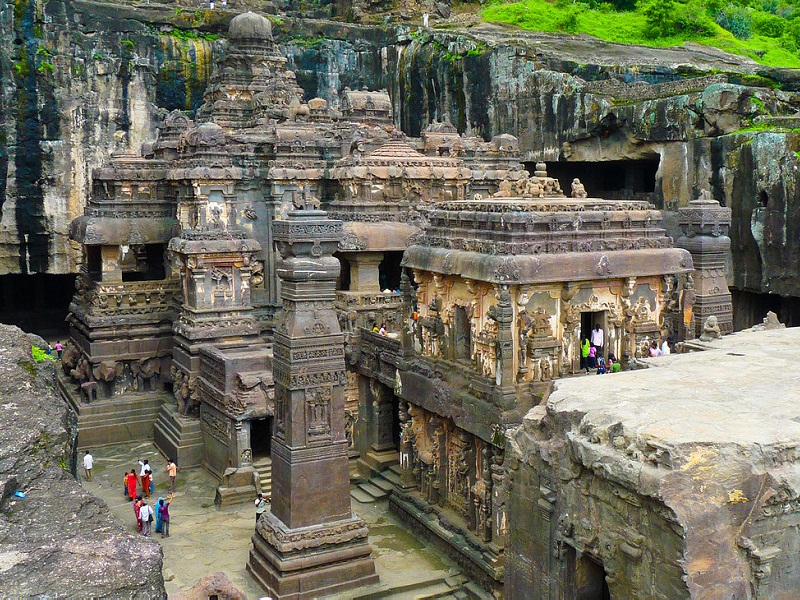
- Ellora Caves Overview
- Top 21 Places to Visit in Ellora Caves
- 23 Best Ellora Caves Tour Packages
- Top Resorts in Ellora Caves
- Best Time to Visit Ellora Caves
- How to Reach Ellora Caves
- Driving Directions to Ellora Caves
- within 1 km
- within 5 km
- within 10 km
- within 20 km
- within 30 km
- within 40 km
- within 50 km
Kailasa Temple / Kailasanath Temple / Cave 16

#1 of 21 Places to Visit in Ellora Caves
At a distance of 300 m from Ellora Caves Bus Stop, Kailasa Temple is the largest rock-cut ancient Hindu temple in Ellora, Maharashtra. It is the prime attraction of Ellora tour packages . Dedicated to Lord Shiva, the Kailasa Temple (Cave 16) is one of the 34 Cave temples and monasteries are known collectively as the Ellora Caves. Its construction is generally attributed to the 8th-century Rashtrakuta king Krishna I based on inscriptions in Kannada. Among the top places to visit in Ellora . It is a sculpture made by cutting down rocks by sculpturing it rather than building up the temple by an architectural design. The construction was a feat of human genius - it entailed the removal of 250,000 tons of rock, took 100 years to complete, and covers an area double the size of Parthenon in Athens. It is considered one of the most remarkable cave .....
...read more
Cave 14 / Ravana Ka Khai
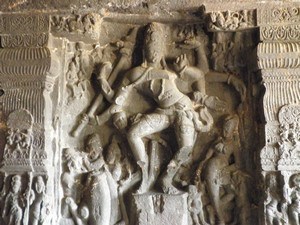
#2 of 21 Places to Visit in Ellora Caves
At a distance of 350 m from Kailasa Temple and 400 m from Ellora Caves Bus Stop, Cave 14, also known as Ravana Ka Khai or Abode of Ravana, is a Hindu cave situated beside Cave 12 in Ellora. There are 17 Hindu caves in all numbered 13 to 29, excavated out of the west face of the hill and datable from around 650 AD and 900 AD. The main examples of this group are Cave 14, Cave 15, Cave 16, Cave 21 and Cave 29. These caves occupy the center of the cave complex, grouped around either side of the famous Kailasa Temple in Ellora. These excavations immediately follow the Buddhist caves and hence the earliest Brahmanical excavations are very much similar to the Buddhist ones. The walls of the Hindu caves are covered in lively bas-reliefs depicting events from the Hindu scriptures. All of the caves are dedicated to Lord Shiva, but there are also some images of Vishnu and his various incarnations. Cave 14, a modest cave known as Ravana Ka Khai, dates from the early 7th century AD and .....
Cave 10 / Viswakarma Cave

#3 of 21 Places to Visit in Ellora Caves
At a distance of 600 m from Ellora Caves Bus Stop and 500 m from Kailasa Temple, Cave 10, also known as Viswakarma Cave is situated beside Cave 9 and is the most famous of all the Buddhist Caves in Ellora. The Viswakarma Cave is also locally known as the Sutar-ka-jhopra (Carpenter's hut). The local carpenters visit the cave frequently and worship Buddha as Viswakarma, the patron of their craft. This is the only chaitya in these series of caves, constructed around 7th century AD. This cave is one of the most magnificent caves in Ellora. The cave is entered through a gate, cut in the natural rock, which leads into a courtyard, with cells on both sides arranged in two storeys. Through the courtyard, one reaches the shrine of Lord Buddha, a typical chaityagriha. The chaitya once had a high screen wall, which is ruined at present. The shrine is 81 feet long 43 feet wide and 34 feet high. The hall is divided into a nave with side aisles by 28 octagonal pillars, each 14 feet high. At .....
Cave 32 / Indra Sabha
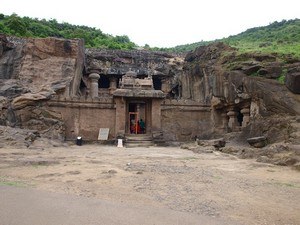
#4 of 21 Places to Visit in Ellora Caves
At a distance of 1.4 km from Kailasa Temple and 1.5 km from Ellora Caves Bus Stop, Cave 32 is a Jain cave situated to the north of Kailasa Temple in Ellora. Known as the Indra Sabha, it is the largest and finest of all Jain temples in Ellora. There are five Jain Caves at Ellora belong to the 9th and 10th centuries AD. They all belong to the Digambara sect. Jain Caves reveal specific dimensions of Jain philosophy and tradition. These caves reflect a strict sense of asceticism - they are not relatively large as compared to others, but they present exceptionally detailed art works. The most remarkable Jain shrines are the Chhota Kailash (Cave 30), the Indra Sabha (Cave 32) and the Jagannath Sabha (Cave 33). Cave 31 is an unfinished four-pillared hall and a shrine. Cave 34 is a small cave, which can be approached through an opening on the left side of Cave 33. Cave 32 is actually a series of shrines dedicated to Mahavira and other Jaina divinities aesthetically arranged in double .....
Cave 33 & Cave 34
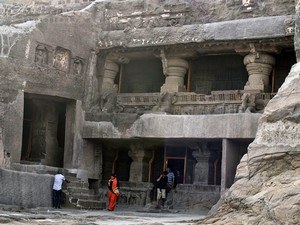
#5 of 21 Places to Visit in Ellora Caves
At a distance of 1.4 km from Kailasanath Temple and 1.5 km from Ellora Caves Bus Stop, Cave 33 is also a Jain cave situated just beside the Indra Sabha (Cave 32) in Ellora. Cave 33 is one of the popular Jain Caves in Ellora. There are five Jain Caves at Ellora belong to the 9th and 10th centuries AD. They all belong to the Digambara sect. Jain Caves reveal specific dimensions of Jain philosophy and tradition. These caves reflect a strict sense of asceticism - they are not relatively large as compared to others, but they present exceptionally detailed art works. The most remarkable Jain shrines are the Chhota Kailash (Cave 30), the Indra Sabha (Cave 32) and the Jagannath Sabha (Cave 33). Cave 31 is an unfinished four-pillared hall and a shrine. Cave 34 is a small cave, which can be approached through an opening on the left side of Cave 33. Cave 33, also known as Jagannatha Sabha, is the second largest in the Jain group of caves at Ellora. The court of the cave is much smaller .....
Cave 11 / Dho Tal
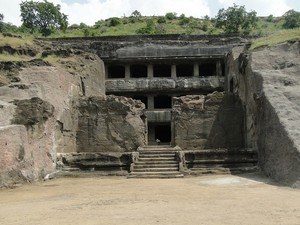
#6 of 21 Places to Visit in Ellora Caves
At a distance of 600 m from Ellora Caves Bus Stop and 500 m from Kailasa Temple, Cave 11 is situated just beside Cave 10 and is one of the 12 Buddhist Caves in Ellora. Cave 11 has two levels and is therefore known as Dho Tal or Two Floors earlier. A basement level has been discovered in 1876 AD and it brings the total floors to three. Even after this the name Do Tal remained and is called so till date. This was partially excavated in 1877 AD, and revealed a verandah 102 feet in length and 9 feet wide with two cells and a shrine in which is Buddha with Padmapani and Vajrapani as his attendants. A staircase leads to a similar verandah above, with eight square pillars in front, the back wall pierced with five doors. The first door is only the commencement of a cell. The second leads into a shrine with a colossal Buddha, his right hand on his knee and the left in his lap. In front of the throne is a small female figure holding up a water jar and to the right another sitting on .....
Cave 12 / Teen Tal
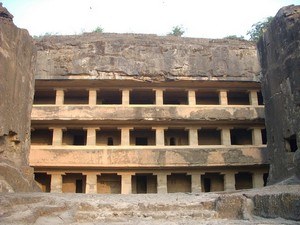
#7 of 21 Places to Visit in Ellora Caves
At a distance of 500 m from Ellora Caves Bus Stop and 400 m from Kailasa Temple, Cave 12 is situated beside Cave 11 and is one of the 12 Buddhist Caves in Ellora. Cave 12, also known as Teen Tal is the largest monastic complex at Ellora, or even in the entire Maharashtra. The complex is in three storeys, hence the name Teen Tal locally. The huge complex is entered through a huge entrance carved out of natural rock, which leads into a large courtyard. A staircase leads to the first storey which has a shrine at the rear end. There are 9 cells arranged on the side walls of the first storey. Various sculptural representations of Buddha and subsidiary deities adorn the walls. A staircase leads to the second storey which is a huge hall measuring 118 feet long and 34 feet in width. The upper floor of the Teen Tal is the most striking among the Buddhist Caves in Ellora. The hall is divided into three aisles by rows of 8 square pillars. This floor has 13 cells pierced on the end of .....
Cave 29 / Dumar Lena
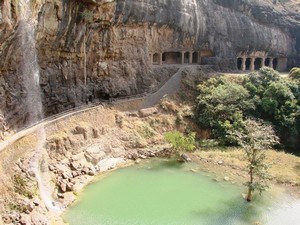
#8 of 21 Places to Visit in Ellora Caves
At a distance of 850 m from Kailasa Temple and 900 m from Ellora Caves Bus Stop, Cave 29 is also a Hindu Cave situated to the north of Kailasa Temple in Ellora. This is the earliest and last Hindu excavations to be completed at Ellora. Also Known as Dumar Lena, Cave 29 is another important excavation at Ellora by the side of Sita-Ki-Nahani, a pool created by a waterfall in the Elaganga River. Dated to late 6th century AD, Cave 29 is said to be influenced by the pattern of the Elephanta Caves near Mumbai. This cave is compared with the ones at Elephanta and Jogeswari Caves but this one is larger, finer and of a later age. This is the best preserved and largest of all the three, which were executed on the same plan. The Dumar Lena consists of an isolated shrine located within a group of halls arranged on a cruciform plan. The entire excavation extends to almost 250 feet. The shrine houses a huge linga entered through four entrances flanked by huge dwarapalas. Two large lions .....
Cave 21 / Rameshwara Cave
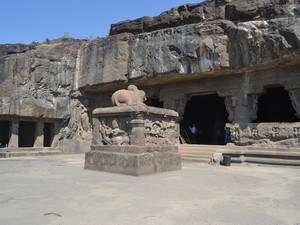
#9 of 21 Places to Visit in Ellora Caves
At a distance of 400 m from Kailasa Temple and 500 m from Ellora Caves Bus Stop, Cave 21, also known as Rameshwara Cave, is located midway between Cave 16 and 29. The Rameshwara Cave was excavated in the late 6th century AD and is supposed to be the earliest among the Hindu Caves at Ellora and also one of the noteworthy caves in Ellora. This cave is famous for the sculptural representations and its unique beauty. This cave is also dedicated to Lord Siva who was worshipped in the form of linga. A Nandi is placed just in front of the cave over a raised platform. The cave consists of a rectangular mandapa and the sanctum. The mandapa is provided with a dwarf wall which is fully sculpted on the exterior in vertical and horizontal bands. The entrance to the mandapa is flanked by sculptures of River goddesses Ganga and Yamuna. Pillars emerge at regular intervals from the dwarf wall with very beautiful and elegant salabhanjikas. The mandapa is 16 feet in height and measures 69 feet .....
Ghrushneshwar / Grishneshwar Jyotirlinga Temple
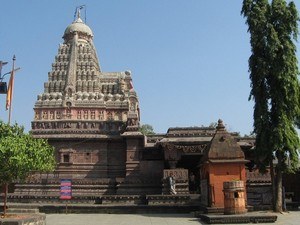
#10 of 21 Places to Visit in Ellora Caves
At a distance of 1 km from Ellora Caves, and 29 km from Aurangabad, Grishneshwar or Ghrushneshwar Jyotirlinga Temple is a famous Hindu temple located at Verul village in the Aurangabad district of Maharashtra. It is one of the famous places of pilgrimage in Maharashtra , among the must-visit places as part of Ellora tour packages . Dedicated to Lord Shiva, Grishneshwar Temple is believed to be the last or 12th Jyotirlinga on the earth. This is one of the top places to visit in Ellora , and among the prominent pilgrimage places to visit near Aurangabad . The presiding deity, in the form of Jyotirlinga, is known by several names like Kusumeswarar, Ghushmeswara, Ghrushmeswara, and Grishneswara. The Grishneshwar temple was .....

#11 of 21 Places to Visit in Ellora Caves
At a distance of 108 km from Shirdi, 181 km from Nashik, 232 km from Pune, 350 km from Mumbai, 482 km from Nagpur, and 534 km from Hyderabad, Aurangabad is a historical city and the administrative headquarters of the Aurangabad Division or Marathwada region in Maharashtra. In 2010, the Maharashtra Tourism Minister declared Aurangabad to be the tourism capital of Maharashtra. It is one of the top places to visit as part of Maharashtra tour packages . Popularly known as the City of Gates, Aurangabad is among the prominent historical places to visit near Pune . The city was founded in 1610 AD by Malik Ambar, the Prime Minister of Murtaza Nizam Shah of Ahmadnagar and his son Fateh Khan changed the original name Khadki to Fatehnagar. The areas around Aurangabad were under the control of Delhi Sultanates, Bahamani Sultans, Nizam Shahis, Mughals, and Hyderabad Nizams. With the capture ..... Distance (From Ellora Bus Station): 28 Kms Trip Duration (From Ellora Bus Station - Including Travel): Full Day .....
Devagiri / Daulatabad Fort, Near Aurangabad
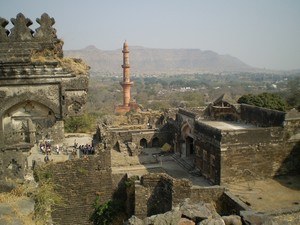
#12 of 21 Places to Visit in Ellora Caves
At a distance of 16 km from Aurangabad Railway Station, Daulatabad is an ancient hill fort situated on the way to Ellora Caves from Aurangabad in Maharashtra. It is one of the best-preserved places of heritage in Maharashtra , and also one of the best Aurangabad tourist places . The historical triangular fort of Daulatabad was built by Yadava king Bhillama V in 1187 AD. It is one of the best historical places near Pune . The city was then called 'Deogiri', meaning the hill of gods. Daulatabad or 'the abode of wealth' was the name given by Muhammad-bin-Tughlaq when he made his capital here in 1327 AD. The region and the fort passed on into the hands of Bahamani rulers under Hasan Gangu in 1347 AD and Nizam Shahis of Ahmednagar in 1499 AD. Daulatabad became the capital of the Nizam Shahi dynasty ..... Distance (From Ellora Bus Station): 13 Kms Trip Duration (From Ellora Bus Station - Including Travel): 4 Hours/Half Day .....
Cave 15 / Dashavatara Cave

#13 of 21 Places to Visit in Ellora Caves
At a distance of 350 m from Kailasa Temple and 400 m from Ellora Caves Bus Stop, Cave 15, also known as Dashavatara Cave, is a Hindu cave situated just beside Cave 14 in Ellora. This is one of the finest and popular caves in Ellora. There are 17 Hindu caves in all numbered 13 to 29, excavated out of the west face of the hill and datable from around 650 AD and 900 AD. The main examples of this group are Cave 14, Cave 15, Cave 16, Cave 21 and Cave 29. These caves occupy the center of the cave complex, grouped around either side of the famous Kailasa Temple in Ellora. Cave 15 is known as Dashavatara Cave belongs to the period of Rashtrakuta king, Dantidurga. This cave mainly depicts Lord Shiva & Lord Vishnu in various forms. This two-storeyed structure has a large courtyard in which stands a monolithic Nandi mandapa. River goddesses flank the entrance. Earlier it was a Buddhist monastery but it was converted into a Shiva temple in the 8th century AD. Here, one can see some Buddha .....
Cave 1 To 5

#14 of 21 Places to Visit in Ellora Caves
At a distance of 600 m from Ellora Caves Bus Stop and 1 km from Kailasanath Temple, Cave 1 to 5 are the Buddhist Caves situated at Ellora. At Ellora, the Buddhists were the first to start excavation of caves. Their period of excavation can be dated between circa 450 AD and 700 AD. During this period, 12 caves were excavated by the followers of Buddhism. These 12 caves can be sub-divided into two groups based on the date of its excavation. Caves 1 to Cave 5 are the earlier among the twelve and are placed in a separate group from Caves 6 to 12 which are later in date. These structures mostly consist of viharas or monasteries. The viharas are multi-storied and include rooms like living quarters, sleeping quarters, kitchens and other rooms. Some of these monastery caves have shrines including carvings of Gautama Buddha, bodhisattvas and saints. Cave 1 is a plain vihara with eight small monastic cells. It may have served as a granary for the larger halls. Cave 2 .....
Cave 6 To 9
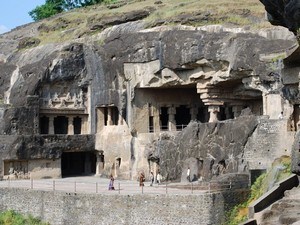
#15 of 21 Places to Visit in Ellora Caves
At a distance of 600 m from Ellora Caves Bus Stop and 500 m from Kailasanath Temple, Cave 6 to 9 are the Buddhist Caves (circa 450 AD and 700 AD) of later period situated at Ellora. These structures mostly consist of viharas or monasteries. They are nothing but large multi-storeyed buildings carved into the mountain face, including living quarters, sleeping quarters, kitchens, and other rooms. Some of these monastery caves have shrines including carvings of Gautama Buddha, bodhisattvas and saints. Cave 6 was carved in the 7th century AD and is home to two of the finest sculptures at Ellora. On the left is the goddess Tara, with an intense but kind expression. Opposite her on the right is Mahamayuri, the Buddhist goddess of learning, shown with her attribute, the peacock. A diligent student sits at his desk below. Significantly, Mahamayuri has a very similar Hindu counterpart, Saraswati. Cave 7 is a large plain vihara which is about 51 feet wide by 43 feet deep and the .....
Cave 17 To 20
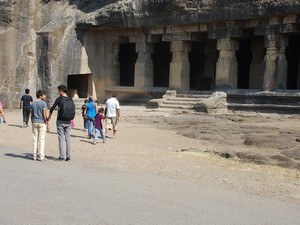
#16 of 21 Places to Visit in Ellora Caves
At a distance of 400 m from Kailasa Temple and 500 m from Ellora Caves Bus Stop, Cave 17 to 20 are situated to the north of Kailasa Cave Temple across a deep ravine in Ellora. These caves are part of 17 Hindu Caves at Ellora. Cave 17 is the next large cave to the north of Kailasa Temple and is dedicated to Lord Shiva. The cave is noteworthy for its decorated doorway and pillars. It has three rows of four pillars from side to side; the front and the back aisles. It is entered through a projecting porch. This leads to columned hall and a linga sanctuary with a surrounding passageway. The extreme pillars of the front are plain square ones with bracket capitals; the inner pair has deep brackets and carved with female figures and dwarf attendants. The middle pair in the next row has cushion capitals with female figures. The middle pillars of the next row are unlike any others, the base is of the broken square pattern with female figures carved on the principal faces and attendant .....
Cave 22 To 28

#17 of 21 Places to Visit in Ellora Caves
At a distance of 400 m from Kailasa Temple and 500 m from Ellora Caves Bus Stop, Cave 22 to 28 are the Hindu Caves situated to the north of Kailasa Temple in Ellora. Cave 22, also known as Nilkantha. This is notable for the free standing damaged Nandi shrine, and separate shrines for the Matrikas. It has four pillars in front and two on each of the other three sides of the hall. On the walls of this hall have sculptures of Ganesha, the three Devis and a four armed Vishnu. There is a pedestal and a highly polished linga in the sanctum. The locals smear blue streaks upon the linga, so the name Nilkantha. Cave 23 consisting of a partly double verandah with five doors entering into small cells, one of them containing a round pedestal and linga, with a Trimurthi on the back wall. Cave 24 is a series of five low cells called Teli-Ka-Gana, the Oilman's Mill. It contains some small sculptures of no special interest. Cave 25, also known as Kunbharwada, depicts Surya, .....
Cave 30 / Chhota Kailash

#18 of 21 Places to Visit in Ellora Caves
At a distance of 1.5 km from Kailasanath Temple and 1.7 km from Ellora Caves Bus Stop, Cave 30 is a Jain Cave situated to the north of Kailasanath Temple in Ellora. This is one of the most remarkable Jain Caves in Ellora. There are five Jain Caves at Ellora belong to the 9th and 10th centuries AD. They all belong to the Digambara sect. Jain Caves reveal specific dimensions of Jain philosophy and tradition. These caves reflect a strict sense of asceticism - they are not relatively large as compared to others, but they present exceptionally detailed art works. The most remarkable Jain shrines are the Chhota Kailash (Cave 30), the Indra Sabha (Cave 32) and the Jagannath Sabha (Cave 33). Cave 31 is an unfinished four-pillared hall and a shrine. Cave 34 is a small cave, which can be approached through an opening on the left side of Cave 33. Cave 30 is the first in the series of Jain Caves known as Chhota Kailasa as it is an unfinished version of the stupendous Hindu Kailasa Temple. .....
Tomb Of Aurangzeb

#19 of 21 Places to Visit in Ellora Caves
At a distance of 4 km from Ellora Caves, 9 km from Daulatabad Fort and 25 km from Aurangabad, the Tomb of Aurangzeb is located at the complex of the dargah or shrine of Sheikh Zainuddin in Khuldabad on Aurangabad - Ellora Road. It is one of the must include places in Ellora tour packages . Aurangzeb (1618 - 1707AD), the sixth Mughal Emperor who ruled most of the Indian subcontinent for nearly half a century and passed away on Friday, 20th February 1707 at the age of 88 at Bhingar in Ahmednagar. As per the last wish of the emperor, the coffin of Aurangzeb was brought by his son Muhammad Azam Shah and he was buried close to his spiritual guru Saint Sayyad Zainuddin here. After his burial here, Aurangzeb was given a posthumous title 'Khuld-makan' (He whose abode is in eternity). The tomb of Aurangzeb is situated at the southeastern corner of the tomb of Zainuddin complex, who died in 1370 AD. It is among the famous places to visit in Ellora . The .....
Sri Bhadra Maruti Temple

#20 of 21 Places to Visit in Ellora Caves
At a distance of 3.5 km from Ellora Caves and 26 km from Aurangabad Railway Station, Sri Bhadra Maruti Temple is a Hindu temple located near Aurangzeb Tomb in Khuldabad. Bhadra Maruti Temple is dedicated to Lord Hanuman. The idol of the presiding deity Hanuman is portrayed in a reclining or sleeping posture. It is among the three temples where Lord Hanuman can be seen in a resting position. The other two temples are the temple in Allahabad, Uttar Pradesh and the temple in Jam Sawali, Madhya Pradesh. According to the legend, in ancient times the Khuldabad was known as Bhadravati and the ruler was a noble king named Bhadrasena, who was an ardent devotee of Rama and used to sing songs in his praise. One day Hanuman descended in the place, listening to the devotional songs sung in praise of Rama. He was mesmerized and without his knowledge took a reclining posture - called 'Bhava-Samadhi' (a yogic posture). King Bhadrasena, when he had finished his song, was astonished to find .....

#21 of 21 Places to Visit in Ellora Caves
At a distance of 3 km from Ellora Caves and 25 km from Aurangabad Railway Station, Khuldabad also known as Khultabad is a municipal council and a taluka of Aurangabad district of Maharashtra. Initially it was known as Rauzaa as meaning garden of paradise. Khuldabad is known as the Valley of Saints, or the Abode of Eternity, because in the 14th century, several Sufi saints chose to reside here. The Dargah of Zar Zari Zar Baksh, Shaikh Burhan ud-din Gharib Chisti and Shaikh Zainuddin Shirazi are situated here. Its historical significance is attested by the ruins of the city wall constructed by Aurangzeb (1658-1707 AD). It has seven gates namely, Nagarkhana, Pangra, Langda, Mangalpeth, Kunbi Ali, Hamdadi and a wicket gate called Azam Shahi. The important structures in and around Khuldabad are Bhadra Maruti Temple, Aurangzeb's Tomb, Tombs of Azam Shah and his wife, Zain-ud-din's Dargah, Burhan-ud-din's mausoleum, Tombs of Asaf Jah and Nasir Jang, Bani Begum's Maqbara, Khan Jahan's .....
Most Asked Questions on Ellora Caves
Post Monsoon and Winter are the best time to visit Ellora Caves to explore western ghats in lush greenery with waters flowing from various streams are at their full glory. Winter is the busiest season in Ellora Caves and hotel prices are also very high during this season.
Ellora Caves usually takes full day to visit the most important attractions. Several tourists usually prefer visiting Ellora Caves along with Aurangabad or Ajanta Caves which requires additional one day for each place. Ellora Caves can be mixed with near by wonderful destination like Aurangabad, Shirdi and Nashik by adding few additional days to your trip.
Budget of Ellora trip depends on the trip duration and category of hotel you choose for your stay along with the kind of vehicle you prefer. Ellora Caves tour packages offered by Trawell.in start from as low as INR 6850 per person for a 2D/1N trip and from INR 8700 per person for 3D/2N vacation.
The guide is a must for Ellora Cave visiting as you won't be able to find the story about the caves on your own. A guide can only explain you the complete details about the architecture, history and valuable information about the founders of the caves.
Usually, it takes 4-5 hours to visit all the caves in Ellora. Additional 2 hours is required to visit Daulatabad Fort.
Top 5 Ellora Caves Packages
Ellora caves blogs, ellora caves related packages, ellora caves related pages.
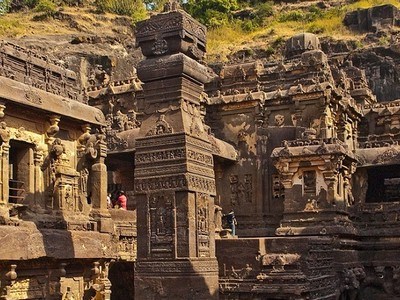
Places to Visit in Popular Sites in India
- Coorg Tourist Places
- Ooty Tourist Places
- Munnar Tourist Places
- Shimla Tourist Places
- Mahabaleshwar Tourist Places
- Chikmagalur Tourist Places
- Wayanad Tourist Places
- Pondicherry Tourist Places
- Goa Tourist Places
- Andaman Tourist Places
- Hampi Tourist Places
- Ajanta Ellora Tourist Places
- Lonavala Tourist Places
- Nainital Tourist Places
- Agra Tourist Places
- Jaipur Tourist Places
- Kodaikanal Tourist Places
- Darjeeling Tourist Places
- Ratnagiri Tourist Places
- Murudeshwar Tourist Places
- Varanasi Tourist Places
- Ayodhya Tourist Places
- Madurai Tourist Places
- Rameswaram Tourist Places
- Shirdi Tourist Places
- Dwarka Tourist Places
- Somnath Tourist Places
- Yercaud Tourist Places
- Dandeli Tourist Places
- Thekkady Tourist Places
- Mussoorie Tourist Places
- Kerala Tourist Places
- Tamilnadu Tourist Places
- Karnataka Tourist Places
- Maharashtra Tourist Places
- Orissa Tourist Places
- Sikkim Tourist Places
- Kashmir Tourist Places
Near By Places
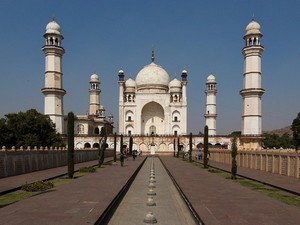
Similar Places
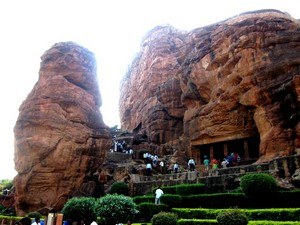
100% SECURE PAYMENTS
Domestic & international cards accepted.

Our WhatsApp Numbers
International tours, +91-8217845740, south india tours, +91-7995649483, goa, maharashtra, gujarat tours, +91-7032828835, north india tours, +91-9535139583, rest of india, +91-7799591230, request quote, travellers #.
Explore Tour Packages
Planning a Trip?
Discover affordable tour packages, need customized tour request quote, login / sign-up, your sign in was successful itinerary will be downloaded shortly., sign up with trawell.in.
Already Created Account? Login Here
Sign in with Trawell.in Account
Forgot Password?
New User? Sign Up Here
Activate Your Trawell.in Account
Your account is activated successfully. Login Here
Reset Your Trawell.in Password
Your password has been reset successfully. Login Here
Booking Policy
- Terms & Conditions

- Destination Guide
Explore Ellora Caves: History, Facts, Best Time and How To Reach

Situated in the Aurangabad district of Maharashtra, Ellora Caves is a series of 34 splendid rock-cut temples and monasteries, dug side-by-side. These caves were cut from basaltic cliffs during the 5th to 10th centuries. Representing, perhaps, the most exemplary rock-cut architecture of India, Ellora Caves are UNESCO World Heritage Sites .
Spread over 1.2 miles, the series of temples and monasteries in Ellora Caves comprise 12 Buddhist temples in the south direction, 17 Hindu Temples in the center, and 5 Jain temples in the north direction.
Whether you are planning a trip to Ellora caves and looking for scholarly articles on Ellora Caves, read along this post to explore Ellora Caves , also spelled as Elura Caves. In this tourist guide, we will talk about Ellora Caves history, facts describe the 1-34 Ellora Caves in detail, the best time to visit Ellora Caves, and uncover the years-old Ellora Caves Mystery.
Let’s finish the warm-up and move to the actual exercise. Read along this post to get a broader and more precise picture of Ellora Caves.
Ellora Caves History
Dates back to AD 600 to 1,000, The Ellora Caves is a series of rock-cut temples and monasteries. The whole complex has over 100 caves, featuring and preserving a multi-faith collection of Buddhist, Hindu, and Jain sculptures and monuments.
Overview: Ellora Caves
- Buddhist Caves (1-12)
- Hindu Temples & Caves (13-29)
- Jain Sculptures (30-34)
India has the most prosperous culture in the world. India, earlier known as ‘ Aryavart ’, has witnessed many kingdoms and dynasties reach inscrutable heights and fall. All of these kingdoms and dynasties, excluding the Mughal Empire, which includes the Mamluk, Khalji, Tughlak, Sayyid, and Lodi Dynasty, have together contributed to shaping the heritage treasure of India. As architecture and monuments remain the prominent remnants of Indian heritage, Ellora Caves is regarded as the pinnacle of Indian culture.
Famous Places To Visit in Ellora Caves (1-34)

Among the 34 Ellora Caves given access to the general public, most caves have just sculptures and paintings. However, a group of 7-8 caves between 13-29 have impressive architecture. Read along to know the famous places to visit in Ellora Caves.
The Rameshwar Temple (Cave 21)

Perhaps the most significant entry among the other famous places to visit in Ellora Caves, The Rameshwar Temple’s construction began during the Kalachuri Dynasty . The cave’s construction was completed before the Rashtrakuta Dynasty reached the heights, which later caused the expansion of Ellora Caves.
Although the cave features similar characteristics to the other temples in the Ellora Caves series, the Rameshwar cave features several unique pieces. It sports a wall depicting the story of Goddess Parwati’s pursuit of Shiva, Parwati’s wedding to Shiva, Shiva in dancing mudra can be found in other Ellora Caves.
You May Be Interested : Most Visited Places From Ramayana
The kailasa temple (cave 16).

The Kailasa Temple in Cave 16 is the most famous among other Ellora Caves. With a Cromlech (megalith) carved out of a huge stone (cliff face), the Kailasa Temple is considered the most remarkable cave temple because of its awe-inspiring size, architecture and sculpture treatment. Being seated among the Oldest Hindu Temples in the Ellora Caves, the temple’s architecture is traced back to Pallava and Chalukya styles.
The Dashavatara (Cave 15)
Occupying the centre of the Ellora Caves, cave number 15 in Ellora Caves is called Dashavatara Temple. It belongs to the era of the Rastrakuta king, Dantidurga. The sculptures in the cave mainly depict Lord Shiva and Lord Vishnu in different forms.
Though the cave has a similar layout and structure to the Buddhist caves 11 and 12, it presents the non-Buddhist features, Natya Mandap, at its entrance, primarily found in Kailasa and other caves dedicated to Lord Shiva.
The Vishwakarma (Cave 10)

The most notable entry in the Buddhist Caves among the 100 Ellora Caves, cave number 10, also called the Vishwakarma cave is a worship hall built around 650 CE. Because the rock has been given a finish that brings the wooden appearance to the beams, this multi-storeyed architecture is known as ‘ Chaitya Grah ’.
The entry of the Vishwakarma prayer hall has a rock-cut court, accessible via a few steps. The Varadha stand on pillars has small shrines at both ends and a single cell in the middle for meditation. Each cave in the Ellora Caves series has its significance and preserves the Indian heritage at its best.
Chota Kailash (Cave 30)

Though it comes in the Jain caves in the series of Ellora Caves, Chota Kailasa or Little Kailasha, due to the architectural similarities to the Kailasha Temple of cave number 16. The cave was likely to be dug in the early 9th Century, beginning the construction of the lower level in Indra Sabha, following the completion of the Kailasha Temple.
The complex features two large-sized sculptures of dancing Indra, one with eight arms and another with twelve, both with the complete ornaments and crown. It is considered the most visited among the other famous places to visit in the Ellora Caves.
The Indra Sabha (Cave 32)

The Indra Sabha was cut out in Cave number 32 in the 9th century. It is a two-storey cave with many monolithic shrines in its complex. Since Indra is the main deity in all three religions (Hindu, Jain and Buddhism), the historians misname this as “Indra Sabha.”
As with other Ellora Caves, many carvings adorn the Indra Sabha, including rock-cut Lotus on the ceiling and other flora on the floor.
The Jagannath Sabha (Cave 33)

The Jagannath Sabha is the second largest and most crucial cave among other Ellora Caves after the Kailasa Temple. The architectural marvel imitates Ajanta Caves and traces back to the 9th century.
A double-storey cave with 12 massive pillars to support and Elephant heads projected towards the porch, Jagannath Sabha has the most beautiful pillar carving and ceiling art among other famous places to visit in the Ellora Caves.
Difference Between Ellora and Ajanta Caves?
What is the difference between Ajanta and Ellora Caves? This is the question that hits almost everyone before heading to the Ellora Caves, Maharashtra. While both Ajanta and Ellora Caves preserve the ancient Indian Heritage, they differ significantly in architecture and preservation.
Want to jump straight on the answer? Here you go!
Ajanta Caves are primarily popular for their paintings carved out on the cave walls. Moreover, the Ajanta Caves are built on the theme of Buddhist and Jainism. On the other hand, the Ellora Caves preserve the ancient heritage of Buddhism, Jainism and Hindu religion. Ellora Caves are the epitome of Indian Architecture, while the Ajanta caves number 1, 2, 9, 10, 17, and 19 are famous, as far as the painting is concerned.
If you have doubts about exploring Ajanta or Ellora Caves, this will help you make a better decision.
What Is The Best Time To Visit Ellora Caves?
Each season has its own significance, but the winter and monsoon touch the Indian heritages at their best. While most people travel in the cosy winters, others love to explore in the monsoon or spring. Therefore, the best time to visit Ellora Caves ultimately depends on your preferences.
Winter is considered the best season to explore the Ellora Caves if you prefer to go by our side. Here are the other details regarding ticket costs and opening timings of Ellora Caves.
Ellora Caves Ticket Cost
Opening Days
How to Reach Ellora Caves?
Situated on a 27 km drive from the Aurangabad district of Maharashtra, Ellora Caves are easily accessible via road, rail and air. You can reach Aurangabad, take a taxi, which usually offers a round trip for INR 1,000 (the cost may vary depending on the car type). The Maharashtra State Road Transport Corporation also provides bus tours to Ellora Caves. Here is a detailed itinerary to reach Ellora Caves.
Nearest Bus Stand To Ellora Caves : Central Bus Stand in Aurangabad is just 27 km from Ellora Caves.
Nearest Railway Station To Ellora Caves : Aurangabad railway station is just 28 km away from Ellora Caves.
Nearest Airport To Ellora Caves : You can drive to Ellora Caves from Aurangabad Airport, which is just 35 km away.
Hopefully, this post has cleared your doubts about the Ellora Caves. If you have more questions in mind, feel free to share your thoughts in the comments below.

Best Countries To Visit In December For Winter Vacation
These countries are open for fully vaccinated indians, related posts, aapravasi ghat: slide into world heritage site, explore vythiri: see the beauty of heaven on earth, best forts of rajasthan to visit in 2024: discovering heritage gems, leave a comment cancel reply.
You must be logged in to post a comment.
You will be redirected to your dashboard shortly. We will also call you back in 24 hrs .
- Ajanta Ellora Caves: All You Need To Know Before You Take A Trip In 2024
23 Jan 2023
Ajanta Ellora Caves have always been recognized as the gems that represent Indian history and the impressive artistry that existed in the foregone era. These tourist attractions consist of 64 rock-cut caves, located in close proximity from the city of Aurangabad.
Today, Ajanta and Ellora Caves are a UNESCO World Heritage Site and exist in the wishlist of many travelers. Since we didn’t want your research to be exhausting, we decided to jot down all you need to know before you plan a trip to Ajanta Ellora Caves.
This is your complete Ajanta Ellora Caves Tour Guide that covers history, the best time to visit, timings and fee, how to reach, map, main attractions of the caves, things to do, and places to stay.
Quick Links To Explore Ajanta Ellora Caves
Here’s a list of relevant links, encompassing all the required details about the surreal Ajanta Ellora Caves. Make sure to check them out before planning your Ajanta Ellora trip.
History Of Ajanta Ellora Caves
Best time to visit ajanta ellora caves, ajanta ellora caves timings and fee, difference between ajanta and ellora caves, key attractions of ajanta ellora caves, things to do at ajanta and ellora caves, interesting facts about ajanta and ellora caves, how to reach ajanta ellora caves.

Ajanta Caves date back to the time between 2nd century BCE to 480 or 650 CE. Walter M. Spink, the famous history scholar, have stated that the caves were built in two phases (Satavahana Period and Vākāṭaka Period) . Some of the caves were not completed and some only had their construction begun for a short time.
On the other hand, Ellora Caves happen to be younger and have its history dating back to 5th and 10 century CE. The Ellora caves are divided into three parts – Hindu Caves, Jain Caves, and Buddhist Caves.
The site of Ajanta Caves was later abandoned and got covered in thick forest, until 1819 when a British officer rediscovered it . However, Ellora Caves have always had the attention it deserves. Today, the Ajanta and Ellora Caves combine to form a UNESCO World Heritage Site, as announced on 1983.
Must Read: 25 Spectacular Caves In India That Should Be Explored At Least Once
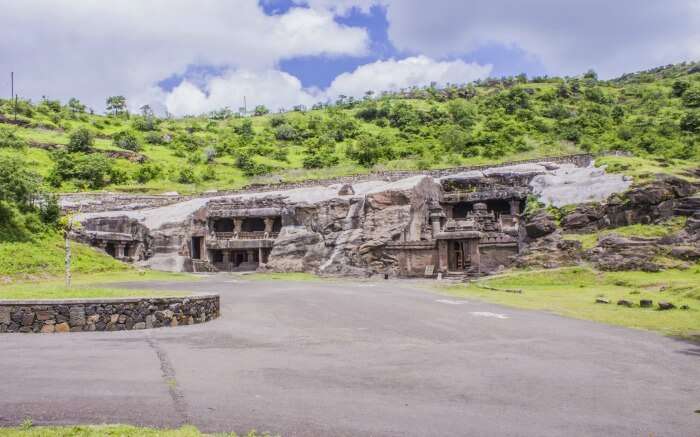
June to March is the best time to visit Ajanta Ellora Caves due to pleasant weather. From June to September (monsoon) the region receives average to plenty of rain showers, which make the exploration experience a delight. While during months of November to February the temperature drops moderately . Summer months (March to May) can actually get hot especially in the daytime. So, try to avoid this season if you’re planning a visit to Ajanta and Ellora caves.
Suggested Read: 5 Beautiful Islands In Maharashtra One Must Visit To Enjoy A Tropical Vacation!
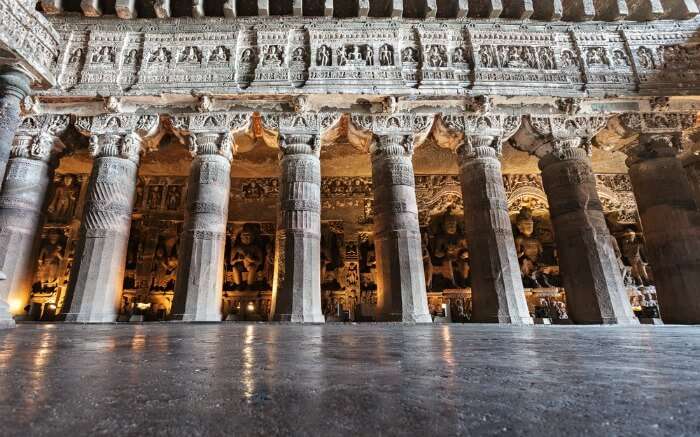
Ajanta Ellora caves timings are as follows:
Ajanta Caves Timings : 9 am to 9:30 pm (Mondays closed) Entry fee : INR 40 per head (Indians) | INR 600 per head (foreign tourists) | INR 25 per camera | INR 0 for children below 15 years old
Ellora Caves Timings : From sunrise to sunset Entry fee : INR 40 per head (Indians) | INR 600 per head (foreign tourists) | INR 25 per camera
Suggested Read: Neemrana Fort Palace: A Brief Guide For Your Weekend Trip

Ajanta and Ellora Caves, though are often addressed as one, have some differences:
1. Distance : Both the caves are 100 km away from each other. Ajanta Caves is 104 km from Aurangabad, while Ellora Caves is 29 km away from Aurangabad
2. Shape : Ajanta Caves are carved in a horse-shoe shaped rock. Ellora Caves are scattered randomly
3. Construction period : Ajanta Caves were built in the period between 200 BCE and 680 CE. On the other hand, Ellora Caves are way younger and were built between 5th and 10th century
4. Purpose of creation : Ajanta Caves has viharas and Buddhist monasteries. Ellora Caves consists of religious centers for Hindu, Buddhist, and Jain
5. Sponsored by : Funds for the construction of Ajanta Caves were provided by various rulers, mainly Vakataka Dynasty and Satvahana Dynasty. Ellora Caves were majorly built under the rule of Chalukya, Kalachuri and Rashtrakuta rulers.
Suggested Read: A Guide To Bibi Ka Maqbara: The Replica Of Taj Mahal
Ajanta and Ellora caves are architectural marvels that are inspiring and have a historic sentiments that cannot be dismissed. These caves are a treat to witness and are one of the most famous historical places in India. Here are the major attractions or places to visit at the Ajanta And Ellora Caves.
Ajanta Caves

Ajanta Caves consist of 30 rock-cut caves, showcasing some of the finest paintings and sculptures ever recorded in the Indian history. When exploring this archeological gemstone, don’t miss to visit Cave 1, Cave 2, Cave 4 and Cave 17.
The vantage point across the river allows a lovely view of the surrounding, along with this horse-shaped historical region.
Cave 1 : This is one of the most popular caves in Ajanta, as all the paintings are authentic. The grand doorway is adorned with Bodhisattva murals and the sidewalls depict two important phases of Buddha’s life (moment before his enlightenment and when he turned himself into many images)
Cave 2 : This cave’s main highlight is its ceiling, which has intricate abstract designs of devils, birds, fruits, and flowers.
Cave 4 : This is one of the largest monasteries in Ajanta and still sparks the magic, in spite of being an incomplete creation.
Ellora Caves
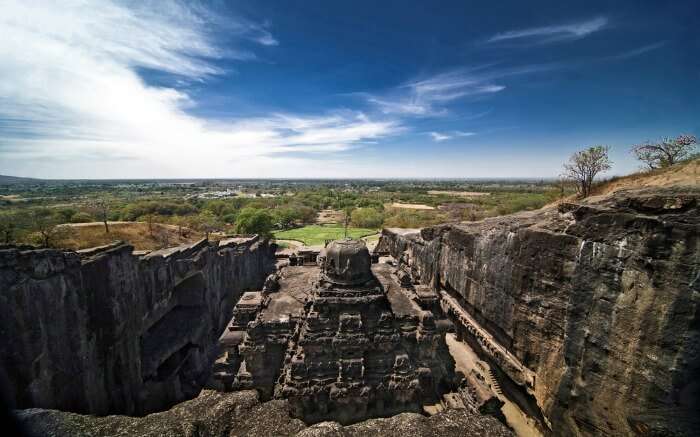
It is apparent that back in the past, there was harmony between Hindus, Buddhists, and Jains, considering close proximity of their religious buildings. Ellora Caves has 34 caves, each of which has its own specialty. If time is a constraint, then you must make it a point to visit at least Cave 1, Cave 2 and Cave 16 .
Cave 1 : The cave is a simple vihara and features 8 monastic cells
Cave 2 : Cave 2 has 12 ornate square pillars. Lord Buddha seated on a lion is yet another attraction. The doorway features an impressive carving of Maitreya Buddha, along with Padmapani holding a lotus.
Cave 16 : One of the highlights of Ellora Caves, Cave 16 or Kailash Temple also happens to be an important pilgrimage spot for the followers of Lord Shiva. The gopurams of this architectural marvel signify Mount Kailash, the abode of Lord Shiva.
Suggested Read: 12 Jyotirlingas In India To Visit: See The Spiritual Side Of The Country
Here are some of the interesting things to do at Ajanta and Ellora Caves for best experiences:
1. Ajanta Ellora Festival – Attend In October

Image Source
The Ajanta and Ellora Festival (by Maharashtra Tourism Development Corporation) is organized annually in November and attracts travelers from across the world. The dance and music festival escalates the charm of Sonehri Mahal, which was built back in the 17th century.
Ajanta Ellora Dance Festival showcases the talent of young folk and classical artists, along with the craftsmanship and architectural brilliance of the monuments in Aurangabad.
Highlights of Ajanta and Ellora Festival : Folk and cultural performances, handicrafts in Kalagram (shopping arcade) and competitions for rangoli Mehendi.
Suggested Read: The Sandhan Valley Trek: Your Pocket-guide To The Best Trek In Maharashtra
2. Shopping – Buy Cave Paintings

There are many open-air markets where you’d love to shop to your heart’s desire after glancing at Ajanta and Ellora Caves paintings.
Shopping is undoubtedly one of the best things to do in Ajanta and Ellora Caves. Here, you’ll come across some beautiful Buddha sculptures handcrafted by the local artisans, along with semi-precious stones and silver ornaments, footwear, clothing, Buddhist and Jain paintings; all of which combine to make this one of the best shopping destinations in India .
Must-pick: Handcrafted sculpture of Buddha and paintings
Suggested Read: Bhandardara Camping: Take A Break And Plan A Vacation To This Place In Maharashtra Amidst The Woods!
3. Staycation – Spend Quality Time With Family
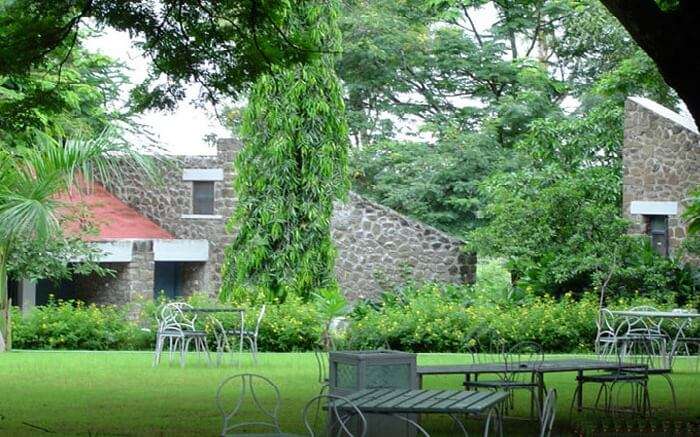
Ajanta Ellora Caves offers plenty of options in terms of accommodation as well, that too for different budgets. If you’re looking for places to stay in Ajanta and Ellora Caves region, then we recommend – Ajanta T Junction Guest House, Hotel Kailas, and Ajanta Tourist Resort.
Please note most of the accommodation options come with basic necessities and range between INR 2000 to INR 4000 per night.
Suggested Read: 18 Best Places To Visit In Ratnagiri: Explore The Green Marvel Of Maharashtra!
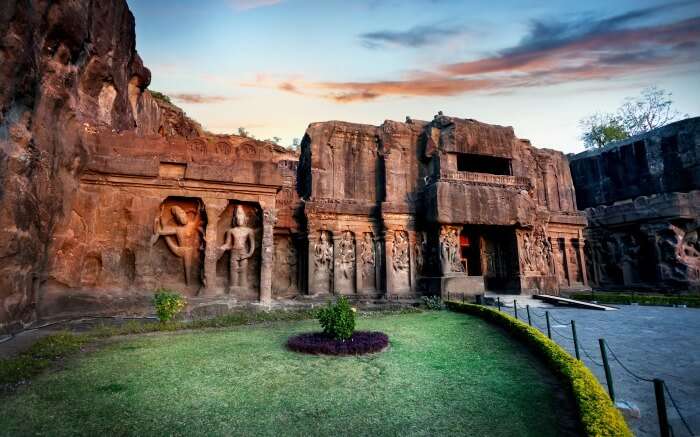
- Ellora Caves were carved on the volcanic basaltic formation, which is also known as Deccan Trap.
- Cave 15 (Dashavatara) in Ellora depicts the ten avatars of Lord Vishnu
- Cave 29 (Dhumar Lena) has similar design as Elephanta Caves
- The painting style found in Ajanta Caves is believed to have inspired painting style in Tibet and Sri Lanka
- The carvings of the caves are done in such a way that they somehow look like wooden construction
- The main subjects of the paintings found in the caves are Jataka tales and incidences from the life of Lord Buddha
- Ajanta Caves were excavated in a rock surface that looks like horse-shoe shape
- The caves are more than two-thousand-year-old, but the statues are about 600 years younger, as they were added later
- Ajanta Caves were abandoned post the end of Harisena’s reign. The sign was later covered in dense forest.
- Buddha has always been against painting or carving his images, as he preached the lesson to rise above materialistic wishes. But after he died, his followers realized the need of his sculptures and paintings, so that they had something to look up to.
Suggested Read: 43 Famous Historical Places In India To Visit
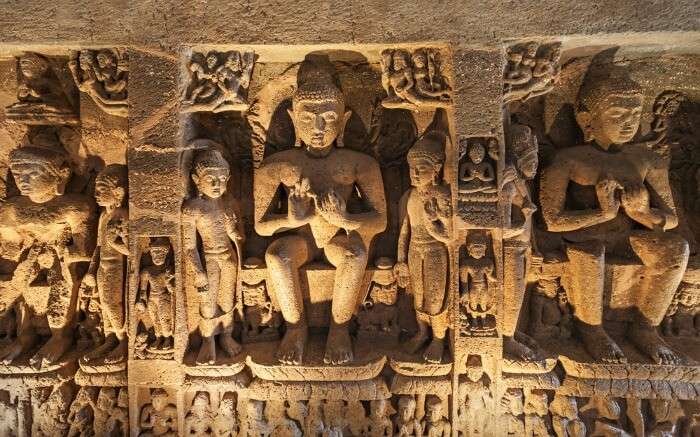
Being a popular attraction of India and one of the best places to visit in Aurangabad, Ajanta Ellora Caves are easily accessible through various modes of transportation.
By air : The caves are about 100 km away from Aurangabad Airport, which is well-connected with major cities in India.
By train : Jalgaon Railway Station is the nearest railway station, located at a distance of 60 km. If you’re wondering how to reach Ajanta Ellora Caves from Mumbai, and other cities of the country then you’ve found your answer, owing to easy connectivity.
By road : Aurangabad is easily reachable via road from different neighboring places like Mumbai, Hyderabad, Aurangabad, and Ahmedabad.
Further Read: 7 Super Luxury Trains In India That Are Worth Spending A Fortune
Now that you know it all, who will you be taking Ajanta Ellora Caves tour with? We’d love to know! Why not explore the caves like royalty? Board the luxury trains in India and indulge in sheer opulence, delight, and warmest of hospitality while unfolding the legends of this gem, along with the other popular tourist destinations of India.
Disclaimer: TravelTriangle claims no credit for images featured on our blog site unless otherwise noted. All visual content is copyrighted to its respectful owners. We try to link back to original sources whenever possible. If you own the rights to any of the images, and do not wish them to appear on TravelTriangle, please contact us and they will be promptly removed. We believe in providing proper attribution to the original author, artist or photographer.
Frequently Asked Questions About Ajanta And Ellora Caves
Is it safe to travel to Ajanta and Ellora Caves during COVID times?
You need to follow all the mandatory guidelines mentioned by the government such as maintaining social distance, wearing a mask at public places, washing or sanitizing hands after entry & exit, etc.
Who built Ajanta and Ellora Caves?
Ajanta and Ellora Caves have been built over several years. Different parts of the cave were built by different dynasties including the Satavahana Dynasty, the Mauryan Empire, Rashtrakuta Dynasty, and Yadava Dynasty.
Which caves are better, Ellora or Ajanta?
Both Ajanta and Ellora Caves have their own beauty, style, and significance. Ajanta Caves are much closer to each other and are known for their paintings. They are dedicated to Buddhism. On the other hand, Ellora caves are comparatively scattered. They are known for their mythological sculptures. They are dedicated to Buddhism, Hinduism, and Jainism.
How far is Ajanta Caves from Ellora Caves?
The distance between Ajanta Caves and Ellora Caves is about 100 km, which can be covered in roughly 3 hours.
Can Ajanta and Ellora Caves be covered in one day?
Yes, you can cover Ajanta and Ellora Caves in one day but you will be rushing through the sites. It takes 2 to 3 hours to tour each group of caves. And there’s also 3 hours distance between them both. So, it is a good idea to keep 1 day for each, Ajanta and Ellora Caves.
Are Ajanta and Ellora caves the same?
No, Ajanta and Ellora are two different group caves, located about 100 kilometers away from each other.
People Also Read:
Petra Caves Kedarnath Cave Cango Caves
Recent Posts

Offbeat Places In Maharashtra To Discover Its Hidden Gems

Explore The Scenic Beauty And Heritage Of Kolhapur By Visiting Rankala Lake

Exploring Korlai Beach As The Perfect Blend Of History And Nature

Grishneshwar Mandir In Aurangabad Is A Paradise For Travellers And Devotees

Top 5 Scenic Spots To Trek Near Lonavala For Nature Lovers
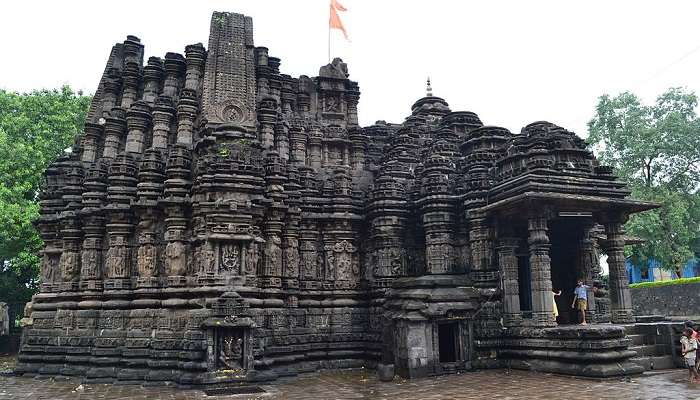
A Closer Look at The Rich History Of Ambernath Shiv Mandir
Trending Blogs

20 Mysterious Places In India To Visit In 2024 More Bizarre Than The Bermuda Triangle

10 Scariest Roads In India That Are A Driver’s Nightmare

101 Places To Visit In India Before You Turn 30 in 2024

35 Exotic Places To Visit In December In India 2024 To Enjoy A Surreal Vacation

60 Best Honeymoon Destinations In India In 2024

95 Best Honeymoon Destinations In The World In 2023 For A Romantic Escape!
Best Places To Visit In India By Month
Best places to visit outside india by month.
- TravelTriangle
- Maharashtra »
- Tour Packages
- Honeymoon Packages
- Family Packages
- Budget Tour Packages
- Luxury Tour Packages
- Adventure Tour Packages
- Group Tour Packages
- Kerala Tour Packages
- Goa Tour Packages
- Andaman Tour Packages
- Sikkim Tour Packages
- Himachal Tour Packages
- Uttarakhand Tour Packages
- Rajasthan Tour Packages
- Tour Packages From Delhi
- Tour Packages From Mumbai
- Tour Packages From Bangalore
- Tour Packages From Chennai
- Tour Packages From Kolkata
- Tour Packages From Hyderabad
- Tour Packages From Ahmedabad
- Kerala Tourism
- Goa Tourism
- Sikkim Tourism
- Andaman Tourism
- Himachal Tourism
- Uttarakhand Tourism
- Rajasthan Tourism
- Hotels in Kerala
- Hotels in Goa
- Hotels in Sikkim
- Hotels in Andaman
- Hotels in Himachal
- Hotels in Uttarakhand
- Hotels in Rajasthan

Ellora Caves – Famous tourist attraction
Introduction to ellora caves, aurangabad.
The Ellora Caves, located near Aurangabad, India, are a series of 34 rock-cut caves that have been carved out of the cliffs along the Charanandri hills. These caves, which date back to the 6th to 10th centuries AD, are an important religious and architectural landmark in India, and a popular tourist destination.
Ajanta and Ellora Caves are two of the most famous tourist attractions near Aurangabad city , located in the Indian state of Maharashtra. Both of these sites are UNESCO World Heritage sites and are known for their intricate carvings and paintings that showcase the rich history and culture of India.
Ajanta Caves, which were discovered in the 19th century, are a series of 29 rock-cut Buddhist monasteries and temples. These caves were built between the 2nd century BCE and the 6th century CE, and are considered to be one of the finest examples of Buddhist rock-cut architecture in the world. The caves are also known for their intricate murals, which depict scenes from Buddhist mythology, as well as daily life in ancient India.
Ellora Caves, on the other hand, are a series of 34 rock-cut temples and monasteries that were built between the 6th and 10th centuries. These caves are unique because they showcase the coexistence of Buddhism, Hinduism, and Jainism in ancient India. The caves are famous for their intricate carvings and sculptures, including the famous Kailasa Temple, which is considered to be one of the largest rock-cut structures in the world.
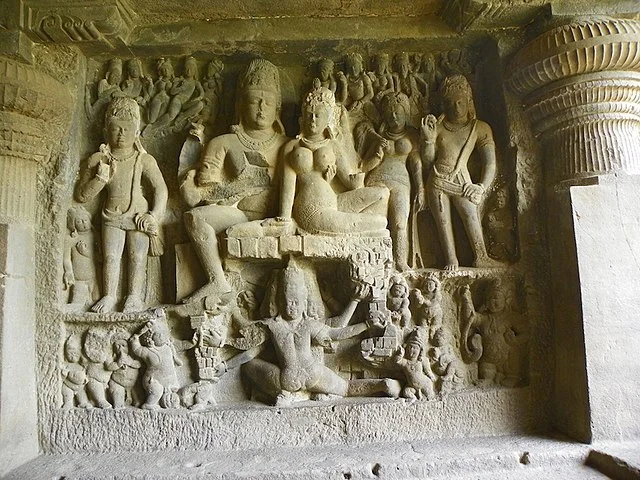
The Ellora Caves are believed to have been built by various Hindu, Buddhist, and Jain dynasties between the 6th and 10th centuries AD. During this period, Aurangabad was a major center of Buddhism and Hinduism, and the caves were used as places of worship, meditation, and learning.
What Makes Ellora Caves, Aurangabad a Tourist Destination
The Ellora Caves are considered one of the most important tourist destinations in India, and for good reason. The caves are a unique blend of religion, art, and architecture, and showcase the skill and creativity of the ancient Indian artisans who created them. They are also a testament to the religious tolerance that existed in ancient India, as the caves feature both Hindu and Buddhist sculptures and carvings.
How to Reach Ellora Caves from Aurangabad
Aurangabad is well-connected by road, rail, and air, and reaching the Ellora Caves is easy from the city. The caves are located approximately 30 km from Aurangabad, and visitors can reach them by hiring a taxi, taking a local bus, or taking a train to the nearby Ellora railway station. You can hire private cab from Aurangabad to Ellora cab one day Trip
Major Attractions
There are 34 caves at Ellora, each with its own unique history and architecture. Some of the most popular attractions include the Kailasa Temple, which is considered one of the largest rock-cut temples in the world, and the Buddhist Viharas, which feature elaborate carvings and sculptures.
Timings and Entry Fees
The Caves are open to visitors from 6:00 AM to 6:00 PM every day, and the entry fee is INR 30 for Indian nationals and INR 500 for foreign tourists. Visitors should also note that there is an additional fee for still and video cameras.
Conclusion and FAQs
The Caves are an important historical and architectural landmark in India, and a must-visit destination for anyone traveling to Aurangabad. Whether you’re interested in religion, art, or history, the Ellora Caves are sure to leave a lasting impression.
- When are the Ellora Caves open to visitors? The Ellora Caves are open to visitors from 6:00 AM to 6:00 PM every day.
- How much does it cost to visit the Ellora Caves? The entry fee is INR 30 for Indian nationals and INR 500 for foreign tourists.
- How can I reach the Ellora Caves from Aurangabad? You can reach the Ellora Caves from Aurangabad by hiring a taxi, taking a local bus, or taking a train to the nearby Ellora railway station.
Comments are closed.
शिवजयंती ऑफर

Happy Diwali
“may the lamps of diwali brighten your life & rangoli add more hues to your life., have a happy diwali.”.

- Off-Beat Experiences
- Top Destinations
- Western India
Ellora Caves: The Ultimate Guide to Visiting This Iconic UNESCO Site
This guide features helpful insights for planning your trip to Ellora Caves! Find out how to plan your visit, what to expect, trip highlights, and nearby attractions, including the Ajanta Caves.

The Ellora Caves are an amazing place to visit! This is also a UNESCO World Heritage Site and a place full of experiences that you can’t find anywhere else in the world. The architecture is incredible and you’ll get an impressive peak into the cultures and religions that peacefully coexisted there!
This article is meant to help travelers in planning a trip to the Ellora Caves, including a little about what makes them special, how to get there, and a few trip-planning tips. You’ll also learn which caves are the absolute must-sees and what to expect while you are there.
The Ajanta and Ellora Caves were places I had never even heard of before coming to Mumbai. It really feels like some secret destination. But I don’t know why it’s not more famous! I’d highly recommend visiting the caves and it’s easily one of my favorite places to travel in Maharashtra.
Whether you are a history lover, an art enthusiast, or just a traveler who loves to have off-the-beaten-path experiences, the Ellora Caves are an absolute must-visit!
This post is all about Ellora Caves.
You Might Also Like:
11 Unique Travel Destinations in India
Golden Triangle, India: Planning, Tips, and Inspirations for the Perfect Trip
15 Unique Things to Do in Mumbai for an Unforgettable Experience
Ellora Caves: Why it’s an iconic UNESCO site in India
The Ellora Caves are located in Maharashtra, India, near a city called Aurangabad. They are one of the largest rock-cut monastery-temple complexes in the world with 34 caves. The Ellora Caves are recognized as a UNESCO World Heritage Site and are really a hidden gem for travelers to experience in India!
The caves were built in two different phases from 550-750 CE and represent various religions and cultures. The oldest caves are Buddhist which feature monasteries. There are also Hindu caves that showcase various gods, like Shiva and Vishnu. There’s also the Kailasa temple which is the largest monolithic structure in the world! You’ll see a few caves that are Jain as well.
What makes the Ellora Caves so famous are not only the architectural wonders! While it’s truly stunning and beautiful to explore, it’s also fascinating to understand about the culture of the past. The Ellora Caves are an example of three major religions coexisting in a single complex. While the layout of the caves still keeps each faith together, they are side by side, which is rare to see!
The Ellora Caves have been continuously visited by people for centuries. There are also the famous Ajanta Caves nearby which were abandoned and re-discovered in the 1800s. Many people visit the Ajanta and Ellora Caves in one trip and it’s well worth it.

Planning Your Visit to Ellora Caves
Best time to visit ellora caves.
coolest time of the year. Generally, during the day, it will be around 25°C to 30°C (75°F to 86°F), but cooler at night and in the mornings.
Monsoon season is June through September, so I wouldn’t recommend traveling at that time. It generally rains every day, and if there’s some really heavy rain, it can make getting to and from the caves very difficult. If you do go then, you need to be fully prepared with umbrellas and rain gear, otherwise expect to get soaked!
I would also avoid going in the summer months between March-June. It starts getting very terribly hot and sunny in late March, April, and May. Then the monsoon comes in June. I’m rather good with the heat, but it’s really not at all pleasant this time of year and can affect the experience.
No matter at which time of the year you do end up there, I would suggest trying to go in the mornings and on weekdays if possible to avoid the major tourist crowds.
How to Reach Ellora Caves
One important thing to mention is that most people stay in Aurangabad and then take a day trip to Ellora Caves which is about 45 minutes away by car. Aurangabad is the closest nearby city with many options for hotels and food, and it’s very easy to arrange a taxi to the caves once you’re there (it’s about 1500 INR or $15-20 USD one way).
I would highly recommend that once you get to Aurangabad, you hire a taxi. It’s also common to combine the trip with Ajanta Caves which is about 1.5-2 hours away by car (a little over 2 hours directly from Aurangabad), so having a driver makes it easy to visit whatever places you want and go on your own schedule.
The nearest airport to the Ellora Caves is the Aurangabad Airport. It is well-connected to major cities in India like Delhi, Mumbai, and Hyderabad. Once in Aurangabad, you can get a taxi to drive there.
You can take trains from major cities like Mumbai and Delhi to Arungabad. This is way cheaper than flying if you are coming from a nearby area. You’ll still need to get a cab from Arungabad to get to the caves.
There are frequent buses that run between Aurungabad and Ellora Caves. The bus ride is about 1 hour long. It’s a much cheaper option than hiring a taxi, although as someone who isn’t an expert in navigating the bus systems in India, it’s a little confusing to figure out. It’s also a cheaper way of traveling!
Ellora Caves Timings & Entry Fee
The Ellora Caves are open from 7:00am-5:00pm. For Indians, it’s 40 INR and for foreigners travelers its 600 INR ($7 USD). Any child under 15 can enter for free. You can just arrive and get a ticket at the entrance.
They also list extra charges for cameras, but you don’t actually have to pay that. Just don’t mention it and you can freely take photos with your phone or camera. Maybe if you have a full professional set up with tripods it would be different, but I’m not totally sure!
Ellora Caves are closed on Tuesdays, but open the rest of the week. If you are planning a trip to Ajanta Caves as well, keep in mind that the Ajanta Caves are closed on Mondays.
Ellora Caves Hotels
In Aurangabad, you can find all kinds of stays. They have cheap options for budget travelers and really nice resorts for people who want to have a more luxurious stay. Basically, it’s all about how much money you want to spend!
You can also find super budget options in some of the small towns outside of Aurangabad, especially towards Ajanta. But the options are limited and will be super basic accommodations. If you’re a really low-maintenance traveler looking to save money, then it’d be fine for you!
What to Wear to Ellora Caves (and Packing Tips!)
There is no particular dress code when going to visit the Ellora Caves. I would say, the best way of dressing could be according to the weather. When you visit, it’s likely going to be hot, so light breathable clothing would be ideal. You can also take along sunglasses or hats, and you definitely want to have good shoes to walk in.
Like anywhere you travel in India, you’ll want to dress a bit more modest than in Western countries. I don’t advise short shorts and a low-cut shirt for ladies, but some pants and a tank top are totally fine, or a longer dress. Check out What to Wear in India: A Comprehensive Guide for Travelers for more detailed insights!
I’d recommend bringing a small backpack for water and money, plus some small accessories that you might want. You’ll be outside, so you may want sunscreen. I would suggest getting some snacks—I always have some for the drive.

Exploring Ellora Caves
There’s a map at the entrance of the caves (or you could just Google), but the caves are numbered 1-34 and situated along a path that’s easy to follow. Caves 1-12 are Buddhist caves, 13-19 are Hindu caves and 30-34 are Jain caves. There’s a well-paved path to walk along and a waterfall too! Expect to spend about 2-3 hours exploring.
Guided Tours
If you’re very interested in the history and culture of the Ellora Caves, you might want to arrange to have a guide take you around. There are quite a few private tour companies , so if you are staying in Aurangabad, I would say ask at your hotel as they will often have a connection and it is easy to plan from there. There’s also guides at the entrance of the caves by ticketing.
I never paid for a guided tour while I was there, but I did look up different caves as I was walking through so that I got to know a bit. I’m generally someone who likes exploring at my own pace so didn’t want to be attached to someone else. Of course it’s personal preference and what you would like to get out of the experience. I’m sure you would learn a lot more with a guide!
Highlights of Ellora Caves
The most impressive aspects of the Ellora Caves are the architecture and structures. The caves are interconnected with walkways and terraces. It’s an incredible insight into the skills they had back in that time and that the various religions were coexisting peacefully.
This is a Buddhist cave that is one of the largest in the complex. It’s famous for its architecture and intricate details.
It’s also known as “Vishvakarma Cave” and is another Buddhist cave. It’s a chaitya hall (prayer hall) and has beautiful carvings of Buddha and followers. This one was my favorite of the Buddhist Caves!
This is a Hindu cave known as “Dashavatara Cave.” It has various sculptures of Hindu deities, including the 10 avatars or incarnations of Vishnu, one of the major Gods in Hinduism.
Cave 16 (Kailasa Temple)
Cave 16 is probably the most famous part of Ellora Caves. It’s the largest single monolithic rock excavation in the world! Like the name suggests, it’s modeled after Mount Kailasa and has elaborate carvings. It’s a multistoried temple complex and even has life-sized elephant statues. This is by the entrance of Ellora Caves.
This is a Hindu cave which has beautiful carvings of various deities. It has figurines of the river goddesses Ganga and Yamuna at the entrance.
This is the largest Jain cave which is known as the Indra Sabha (Assembly of Indra, the god of rain). It’s a two-storied cave with carvings of Jain deities, including Mahavira and Parshvanatha. The lower part is also covered with carvings of lotus flowers and other decorative designs.
Cave 34 is a small Jain cave but it has detailed carvings of the Tirthankaras, or spiritual teachers, which are quite impressive. There’s also a seated figure of Mahavira, who was the last Tirthankara and preached Jainism in ancient India.
Recommended Itinerary for Ellora Caves (and Ajanta Caves)
I recommend staying in Aurangabad for at least 2 full days. You can spend one day on a trip to the Ellora Caves, which is about 45 minutes away. On the other day, you can visit the Ajanta Caves which is a 1.5-2 hour drive from Aurangabad.
Ajanta and Ellora Caves can be done in a day, and you can get tours with that included, but I feel it’s better to break them up. There’s quite a bit of walking, so it’s just a much better experience to go at a leisurely pace. That’s my personal preference at least!

Nearby Places to Visit
Ajanta caves – this is a must.
The Ajanta Caves are another UNESCO World Heritage Site near the Ellora Caves. They are actually more famous and popular, but most travelers will visit both sites if they are in the area because they are so near each other.
The Ajanta Caves are also ancient rock-cut caves. They are most famous for their incredible paintings, while Ellora Caves are more known for their architecture. There are colorful and detailed murals and it’s really impressive how well you can still see some of them even hundreds of years later! There’s also a viewpoint that overlooks the caves along a river which is a nice stop.
These are other nearby attractions that are worth mentioning if you have the extra time in Aurangabad.
Daulatabad Fort
The Daulatabad Fort, dating back to the 14th century, is quite interesting to look around. It’s a nice view into history and a good way to spend a couple of extra hours in Aurangabad.
Bibi Ka Maqbara
The Bibi Ka Maqbara in Aurangabad is also known as the “Mini Taj Mahal.” It was built in the 17th century by Aurangzeb’s son in memory of his mother and is one of the beautiful examples of Mughal architecture.
Panchakki (Water Mill)
This is an ingeniously designed water mill from the medieval period. It’s known for its underground water channel which powers the mill and was made to grind grain for pilgrims. It could be a quick place to visit and see while in Aurangabad if you’re interested.
Aurangabad Caves
If you’ve seen the Ajanta and Ellora caves, then the Aurangabad Caves won’t be too impressive. There are 12 caves with the similar rock-cut style used by Buddhists. But, if you have the time and are interested, check it out!
Grishneshwar Jyotirlinga Temple
Grishneshwar Temple is located near the Ellora Caves. According to a sacred Hindu book, Shiva Purana, it is one of the twelve very important Jyotirlingas of Lord Shiva who is one of the major deities in Hinduism. The temple is famous for its architecture and many people go for pilgrimages there.
Also Check Out:
Ajanta Caves: A Comprehensive Guide to India’s Ancient Wonders
50+ Travel Journal Ideas: Prompts, Scrapbook & Bullet Journal Inspiration
What to Wear in India: A Comprehensive Guide for Travelers
This post was all about Ellora Caves.
You may also like

8 Incredible Indian Honeymoon Destinations

6 Indian Holidays in March and How to Celebrate Them

Travel to Goa: A Complete Guide for First-Timers
Leave a comment cancel reply.
Your email address will not be published. Required fields are marked *
Save my name, email, and website in this browser for the next time I comment.
Previous Post

- Destinations
- Ellora-caves
"ELLORA CAVES"
Witness the UNESCO World Heritage Site with one of the luxury trains in India, Deccan Odyssey. Experience the locale and the timeless traditions of Ellora Caves, located near Aurangabad, Maharashtra. They are the epitome of ancient Indian rock-cut architecture and are the most stunning architectural marvels in the world. Composed of volcanic Basalt rock and witness to 35 caves and rock-cut temples, Ellora caves were largely carved during the reign of the Kalachuri dynasty in the 6th and 7th centuries CE. Come to Ellora Caves and explore the celebrated cave temples of Hinduism, Buddhism, and Jainism.
Take a look at the marvellous attractions at Ellora Caves. Hindu Caves
The Hindu caves are categorized from Caves 13 to 29. The stunning carvings inside these caves are going to leave you thrilled. Cut from top to bottom, Hindu caves are truly mesmerizing and the highlights of these caves are Cave 14, Cave 15. Cave 16, Cave 21, and Cave 29.
Cave 13 is comparatively simple and almost seems like a storehouse. The Ravan-ki-Khai, Cave 14, is a Buddhist vihara transformed into a temple, which was dedicated to Shiva in the 7th century. Cave 15 is one of the finest at Ellora. It is a two-storey temple with the Dashavatara Cave or Ten Incarnations of Vishnu and Shiva Nataraja, Shiva emerging from a lingam while Brahma and Vishnu honour them.
Caves 17 to 20 and Caves 22 to 28 are just monasteries that visitors can explore. Cave 21 also called the Ramesvara cave displays the interpretations of Shaivite scenes carved in the old temples. Goddess Ganga’s figure can be seen standing on her mythical sea creature or Makara. Last but not least is the Dhumar Lena cave (no. 29). It looks similar to the famous cave at Elephanta denoting a connection between Ellora and the Kalachuris. Also, the figure brackets present in cave 21 are evidence of a cultural connection between the two locations.
Kailasa Temple
The largest rock-cut monument in the world, Kailasa Temple is the prime attraction of Ellora Caves. A five-shrine temple it resembles the Kailasanatha at Kanchipuram. Come to witness the grandeur of Ellora at Kailasa Temple, which is the perfect northern example of the southern Dravida Temple.
It is a 32-meter high temple and was built in the 8th century CE by Krishna of the Rashtrakuta dynasty to celebrate his victory over the Pallavas. Visit here to see the intricately carved panels describing the scenes from the Hindu epics Ramayana, the Mahabharata, and the adventures of Lord Krishna. Do not forget to see the southeastern gallery that has 10 giant panels depicting the several avatars (incarnations) of Lord Vishnu.
Buddhist Caves
Home to 12 Buddhist caves, they are a stretch to the south of Kailasa. All Buddhist monasteries or viharas are used for studying and worship, but these multi-storeyed caves also include living, sleeping, and cooking. However, Cave 10 is an exception with an assembly hall or chaitya.
Cave 1 is the simplest one and Cave 2 is recognised for its ornate pillars. Cave 3 and 4 are unfinished and unkempt. Visit the largest vihara of Buddhist caves at Cave 5. It is 18m wide and 36m long and has stone benches with an assembly hall. Cave 6 is a vihara with beautiful images of the Tara, the mate of the Bodhisattva Avalokitesvara and Mahamayuri, the Buddhist goddess of learning.
Explore the hall of Cave 7 and see Cave 8, the first cave where sanctum is detached from the wall at the back. Cave 10 is the single chaitya in the Buddhist caves but has beautifully carved ceilings with stonework and grooves fitted into the wooden panels. There is also a decorative window that has a large figure of teaching Buddha.
Lastly, the Do Thal (two-storey cave), Cave 11 can be entered from the third level of basement and interestingly, was not excavated until 1879. And the Cave 12, the Tin Thal or three-storey cave is entered through a courtyard and has an enormous Buddha figure with his seven previous incarnations.
Explore the last caves created at Ellora. These five Jain caves might not be of the same size as the Hindu ones but are exceptionally beautiful and have remarkable carvings and paintings. The Chhota Kailasa or the Little Kailasa is a not-so-good imitation of the rock-cut monument, Kailasa Temple and stands separate from other Jain temples.
The Indra Sabha or the Assembly Hall of Indra, Cave 32 is the most stunning among Jain Temples. It contains the images of the Jain Tirthankaras (great teachers) – Parasnath and Gomateshvara surrounded by the wildlife. Inside the temple is a seated figure of Mahavira, the founder of the Jain religion and also the last Tirthankara.
Visit Cave 31, which is an extended part of Cave 32. Also, the Jagannath Sabha, Cave 33 is a look-alike of Cave 32 and has some well-preserved sculptures one cannot miss. And finally, Cave 34 is the last temple and is rather small. It contains some impressive carvings. Interestingly, on the hilltop over the Jain Temples, there is a 5m high image of Parasnath gazing down on Ellora.
So, if the history of ancient sites and architectural marvels interest you, do visit the Ellora Caves in Maharashtra once in your lifetime.
Explore all Destinations
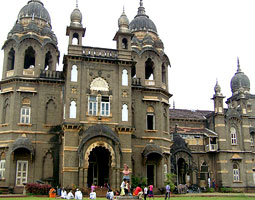
or continue with
Enter the e-mail address associated with the account. We'll e-mail a link to reset your password.
Ajanta and Ellora Caves – The Essential Guide

It has been more than a year since I posted on the blog , so I thought I should remedy that. And what better way to start than with one of my most recent trips. In January this year, I visited Aurangabad and obviously went to Ajanta and Ellora Caves. My last trip to these UNESCO World Heritage Sites was many (many) years ago, when I was still in school, so I was excited to revisit. Here’s everything you need to know if you’re planning a trip.

Ajanta Caves

These include both monasteries (chaityas) and worship-halls (viharas). They are adorned with rock-cut sculptures and paintings that represent some of the finest examples of ancient Indian art.
Cave 1 is the most beautifully decorated and contains many of the iconic Ajanta artworks like the Padmapani mural (top right). Amongst the oldest in the complex, cave 10 contains a massive prayer hall with rows of octagonal pillars on either side and a stupa at the end. Caves 16 and 17 have some of the best-preserved and well-known paintings of all the Ajanta caves, depicting elaborate narratives from the Jataka tales.

One of my favourites is Cave 26, which has intricate sculptures including that of the reclining Buddha (below) and the legend of “Temptations by Mara”.
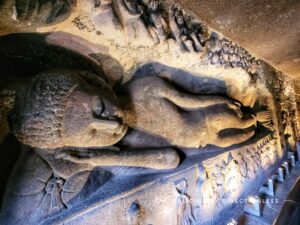
Ellora Caves
Unlike Ajanta, Ellora comprises Buddhist, Hindu, and Jain religious centres spread over 34 caves dating between the 6th and 11th centuries AD. Of these, cave 16 is the most spectacular, featuring the Kailasa temple. This chariot-shaped monument dedicated to Shiva is the largest single monolithic rock excavation in the world.

Apparently, 10 generations of artisans worked on it and it took more than 200 years to complete over many reigns of the Rastrakuta kings. It has all the main temple elements such as gateway, main shrine, nandi shrine, etc. It is richly carved with niches, pilasters, windows, and corniches. One of the highlights are the friezes on the plinth that illustrate the two great epics — Ramayana and Mahabharata.
You will need at least two hours to explore the entire temple, and believe me, it’s worth it! I would also recommend climbing up a pathway that skirts the cave for an aerial view of the temple. You will get a better idea of its sheer size and grandeur (see below).

Other than cave 16, you should also check out two Buddhist caves. Cave 5 has a uniquely designed hall with a pair of parallel refectory benches in the centre and a Buddha statue in the rear. Cave 10 has a cathedral-like stupa hall and a 15-foot statue of Buddha seated in a preaching pose.
The Jain caves (nos. 30-34) are some distance away and we skipped them as we had to return to the city.
How to visit Ajanta and Ellora Caves

Where to eat
Since both the caves are a day trip from Aurangabad, you will need to grab lunch nearby. There’s an MTDC canteen of sorts at Ajanta but I’d suggest you head to Hotel Ajanta Green (also run by MTDC), which is located a couple of kilometres from the caves. Near Ellora caves, your best bet is the restaurant Kailasa, which is just outside the cave complex.
When to visit

November to March is the best time to visit the caves when it is (relatively) cool and dry. The summer months can be scorching and also crowded because of school holidays. The caves are open during the monsoon but I would imagine the paths would be slippery, particularly at Ajanta where you have to climb up and down some steep rock-cut stairs. However, our guide said that the rains make the setting quite spectacular with greenery and waterfalls (the pic on the left was taken in Jan 2023).
How to travel to Aurangabad

Where to stay in Aurangabad
There are several hotels in the city, but since I was travelling with family (and we were staying for four nights), we opted for an apartment. We found this lovely two-bedroom apartment on Booking.com , which was clean, well-appointed, and reasonably priced. Its location was also quite convenient, just over 3km from the railway station (and under 1okm from the airport).
Have you visited Ajanta and Ellora Caves? If not, I hope this post inspires you to go soon!
This Mumbai Walking Tour Is An Architectural ...
Guide to aurangabad (chhatrapati sambhaji nagar), related posts.

This Mumbai Walking Tour Is An Architectural Treat

In Photos: The Doors (& Windows) of Pondicherry
Leave a reply cancel reply.
Your email address will not be published. Required fields are marked *
Yes, add me to your mailing list.
This site uses Akismet to reduce spam. Learn how your comment data is processed .

- PHILIPPINES
- SOUTH KOREA
- NEW ZEELAND
Which are the Best Caves at Ellora Caves?
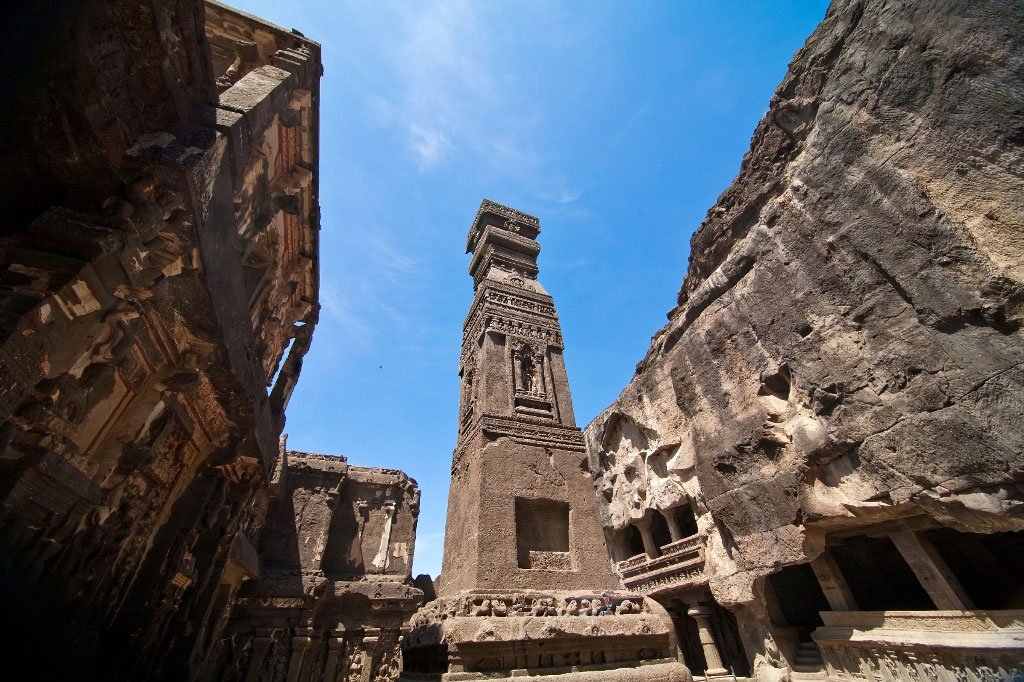
- Features: Cave temple complex featuring Hiindu, Jain and Buddhist rock cut temples
- Opening Times: dawn to dusk, Wednesday to Monday
- Best Time to Visit: Late October to early March
- Duration: All day
- Travelled By: Bus
- Cost: Indian/foreigner Rs 10/250
- Address: Ellora, Maharashtra, India
- Type: Historic site
Author Reviews
What We Liked
What we disliked.
Heading to the Ajanta and Ellora Caves? Did you know that there are 34 caves at Ellora? Before you go, read this article to find out the best caves to visit at Ellora Caves, as well as interesting facts, best time to visit and other important information about the caves.
H eading to the Ajanta and Ellora Caves? Did you know that there are 34 caves at Ellora? Before you go, read this article to find out the best caves to visit at Ellora Caves, as well as interesting facts, best time to visit and other important information about the caves.
[singlepic id=2138 w=720 h=560 float=center]
10 Interesting Facts About Ellora Caves
- Together with the Ajanta Caves, the World Heritage Site-listed Ellora cave temples is the epitome of ancient Indian rock-cut architecture
- Lying near an important ancient trade route between Ujjain in Madhya Pradesh and the west coast, the Ellora Caves are thought to be the work of priests and pilgrims who used the route
- Dating back to the 6 th century A.D., these cave temples were built over five centuries by generations of Buddhist, Hindu and Jain monks
- These caves were primarily monasteries, chapels and temples for the monks
- Unlike the caves at Ajanta, which are carved into a sheer rock face, the Ellora Caves line a 2km-long escarpment, the gentle slope of which allowed architects to build elaborate courtyards in front of the shrines, and render them with sculptures of a surreal quality
- Like the caves at Ajanta, Ellora’s caves were also abandoned and forgotten over time
- Ellora has 34 caves in total: 12 are Buddhist (600-800 A.D.), 17 are Hindu (600-900 A.D.) and five are Jain (800-1100 A.D.)
- The grandest of the Ellora Caves is the awesome Kailasa Temple (Cave 16), the world’s largest monolithic sculpture, hewn top to bottom against a rocky slope by 7,000 labourers over a 150-year period
- Historically, the site represents the renaissance of Hinduism under the Chalukya and Rashtrakuta dynasties, the subsequent decline of Indian Buddhism and a brief resurgence of Jainism under official patronage
- The increasing influence of Tantric elements in India’s three great religions can also be seen in the way the sculptures are executed, and their coexistence at one site indicates a lengthy period of religious tolerance
Best Time to Visit Ellora Caves India
The Ellora caves face west and therefore are best seen in the afternoon. The best way to see the caves is to start at the south end and visit the Buddhist viharas first (Nos 1-12), followed by the Jain caves at the north end (Nos 29-34) and finally ending with the Hindu caves (Nos 13-28). This allows the Hindu Kailasnatha temple to be seen towards the end.
Official guides can be hired at the ticket office in front of the Kailasa Temple for Rs 700 and upwards. Most guides have an extensive knowledge of the cave architecture at Ellora.
Ellora Caves Information
Buddhist caves (nos 1-12).
[singlepic id=2050 w=720 h=560 float=center]
Located on the south side of the complex, these caves belong to the Vajrayana sect of the Mahayana (Greater Vehicle) School. The caves include viharas (monasteries) and chaityas (chapels) where the monks worshipped. It has been suggested that the stone-cut structures were ideally suited to the climate which experienced monsoons, and rapidly became the preferred medium over more flimsy and less durable wood.
While the earliest caves are simple, Caves 11 and 12 are more ambitious, and on par with the more impressive Hindu temples.
Ellora Cave 1
Dating back to circa 6 th century A.D., this Buddhist monastery is austerely plain and devoid of any sculptural representations. It consists of an astylar with eight cells. It is possible that the excavation was done for the residence of the stonecutters but was later on used by the Buddhist monks.
Ellora Cave 2
[singlepic id=2060 w=720 h=560 float=center]
Dedicated to Lord Buddha, this Buddhist monastery dating back to circa 8 th century A.D. consists of a broken veranda, a hypostylar hall with lateral galleries and a sanctum flanked by cells. The monastery is reached through a flight of steps, and consists of a twelve-pillared mandapa with side galleries and a shrine at the rear end.
This cave is notable for its ornate pillars and the imposing seated Buddha, which faces the setting sun.
The monastery is decorated both internally and externally with sculptures of Lord Buddha in different postures and deities of Buddhist pantheon. The side galleries have images of Buddha in the sunken niches, many of them unfinished.
The pillars are adorned with cushion brackets and some are decorated with the pot and foliage motif. The sculptures are massive, particularly, the dvarapalas (door-keepers) which guard the door of the hall and sanctum. The lateral galleries and the walls are decorated with the images of Buddhist pantheon.
The sanctum in the centre of the back wall houses a 3-m-high seated Buddha on a Lion-throne in preaching posture attended by two standing Buddhas while along each of the side walls are five Buddhas accompanied by Bodhisattvas and apsaras (celestial nymphs).
Ellora Cave 3
Similar to Cave 2, this Buddhist monastery has a square central chamber with an image of Buddha on a Lotus-throne. Around the walls are 12 meditation cells.
Ellora Cave 4
This Buddhist monastery is two-storeyed and contains a Buddha sitting under the Bo (pipal) tree.
Ellora Cave 5
[singlepic id=2064 w=720 h=560 float=center]
Dating back to circa 7 th century A.D., this is a very big and impressive Buddhist monastery and the largest of the single storeyed caves in this group. Known locally as “Maharvada” this Buddhist cave measures 117 feet deep and 59 feet wide. The oblong hall, the two side chapels with cells, an antechamber and a sanctum are the chief architectural components.
The most striking feature of this monastery is two long and low stone benches placed at the centre which stretches throughout its length, flanked by rows of 24 pillars, 12 on each side. The massive pillars in the hall are decorated with paintings. There are attractive carvings on the first pillar on the left.
The monastery has a shrine for Buddha at the rear end and twenty cells for the monks. The sanctum houses Lord Buddha in preaching posture and is guarded by two huge Bodhisattvas. On the left is Padmapani, a symbol of purity; on the right is Vajrapani holding a thunderbolt, the symbol of esoteric knowledge and the popular deity of the sect responsible for creating the caves.
The Buddha here is seated, not cross-legged on the floor as is usual, but on a chair or stool. He demonstrates some of the 32 distinctive marks: three folds in the neck, long ear lobes and the third eye. The mudra here signifies the Buddha’s first sermon at the Deer Park.
The hall seems to have been used for monks as an assembly hall, dining room and also for ritualistic purposes. This cave could have been a place for preaching and learning of the Buddhist principles and teaching, the stone benches being the seats for the mendicant disciples.
E llora Caves 6-9
These four caves can be bypassed as they contain nothing new.
E llora Cave 10 (Top Pick)
[singlepic id=2070 w=720 h=560 float=center]
Popularly known as “Viswakarma” (the celestial architect) and also as Sutar-ka-jhopra (Carpenter’s hut), this is the only chaitya (chapel) cave in the group. The local carpenters visit the cave frequently and worship Buddha as Viswakarma, the patron of their craft.
The cave is entered through a gate, cut into the natural rock, into a courtyard open to the sky, with cells to the right and left arranged in two storeys. The cells around the courtyard have square-based pillars at the foot of which was a lion facing outwards. The monastery was on the ground floor, and above are what are presumed to have been the monks’ living quarters.
[singlepic id=2069 w=720 h=560 float=center]
Through the courtyard, one reaches the elaborately carved chapel of Lord Buddha, a typical chaityagriha. The exterior decoration gives the impression that instead of stone, wood was the building material, hence ‘Viswakarma’. The façade has a trefoil window with apsara groups for ornamentation. The main hall is large (26 m by 13 m, 10 m high). The curved fluted ‘beams’ suggest to some the upturned hull of a ship. The chamber has 28 octagonal pillars, each with a vase and foliage capital, dividing it up into a nave and side aisles. The aisle runs round the decorated stupa (dagoba) with a colossal 4.5-m ‘Preaching Buddha’ carved in front of it.
The visitor is filled with awe at the sight of Lord Buddha seated in dharmacakra pravartanamudra, nearly 11 feet in height, visible by the natural light entering through the entrance door and chaitya window in the balcony. Here, the Buddha image is placed on the front part of a large stupa, nearly 27 feet in height.
The roof is a huge arch with imitations of wooden ribs neatly reproduced in stone. The flat portion in between the pillars and the bottom of the stone ribs, known as triforium, is decorated with a series of seated Buddha images flanked by attendant figures.
The huge chaitya arch in front of the chaityagriha has attained the form of a trefoil decoration, unlike the huge pointed horse-shoe arch of earlier chaityas. The arch has three portions, the central one decorated with an attic window at its centre, which also lightens the interior of the cave. Below the other two portions are sunken niches with an image of Avalokiteshwara on the south side and Manjushri on the north side. The niches represent miniature temple shrines and adorned with extremely beautiful decorations imitating a sikhara of contemporary times. The chaitya arch and the balcony decorations are complete with precision and also imitation of wooden architecture. Even the wooden pins at the joints of beams and lintels are imitated in stone.
[singlepic id=2071 w=720 h=560 float=center]
The upper gallery, reached by an internal flight of steps, was supposed to have subsidiary shrines at either end but the left hand one was not finished. Decorating the walls are loving couples, indicating how much Buddhism had changed from its early ascetic days. You can get a view of the friezes above the pillars which show Naga queens, symbolic precursors of the monsoon, and dwarfs as entertainers, dancing and playing musical instruments. Sunlight pouring through the circular window at the entrance to the cave gives the cave a truly ethereal quality.
The upper gallery is usually closed to public so you will have to give a small bribe to the guard who will then open the door for you to go up to view the upper gallery.
Ellora Cave 11
This two-storeyed Buddhist monastery was found to have a third storey in 1876 when the basement was discovered. The lowest level is a veranda with a shrine and two cells at the back. The middle level has eight front pillars and five rear cells of which only the central three are completed and decorated. The upper level has a porch opening into a long colonnaded hall with a Buddha shrine at the rear. Images of Durga and Ganesh suggest that the cave was later used by Hindus. Cave 11 and 12 illustrate the use of the upper levels of these caves as a residence for monks and pilgrim hostels.
Ellora Cave 12
[singlepic id=2072 w=720 h=560 float=center]
This is the largest monastic complex at Ellora, or even in entire Maharashtra. The complex is built in three storeys, hence its local name of “Teen Thal”. The huge complex is entered through a huge entrance carved out of natural rock, which leads into a huge courtyard. Steps on the right lead to the first storey which has a shrine in the middle of the rear end. There are nine cells arranged along the side walls of the first storey. It is believed these cells were used for sleeping (note the stone benches). Various sculptural representations of Buddha and subsidiary deities adorn the walls.
A staircase leads to the second storey which is a huge hall divided into three aisles in rows of 8 square pillars. This floor has 13 cells pierced into the side walls and on the back wall. The shrine at the eastern side has a huge Buddha image in bhumisparsa mudra position. The Buddha image is Sujata offering payasa, reminiscent of the events just before the enlightenment of Siddhartha before he became Buddha. On each side of the seated Buddha image is a row of five Bodhisattvas.
The top floor is reached by a flight of steps on the north side. The top storey is a huge hall with nearly equal dimensions to the lower one; there is a shrine and a huge antechamber on the east. The back wall of the hall contains 14 representations of Buddha, seven on the north side and seven on the south side. The seven images on the north side are in bhumisparsa mudra and are of Vipasyi, Sikhi, Vishvabahu, Krakuchhanda, Kanakamuni, Kashyapa and Sakyasimha – all are manusi Buddhas. The seven on the south side are representations of divine Buddha. The rows of seven Buddhas are symbolic of the belief that he appears on earth every 5000 years and has already visited it seven times.
The side walls of the antechamber are adorned with three images of female deities, three on each side. The shrine is adorned with a colossal image of Lord Buddha flanked by Padmapani and Vajrapani.
Ganesh Group Of Caves – Hindu Caves (Nos 13-29)
[singlepic id=2053 w=720 h=560 float=center]
Where calm and contemplation infuse the Buddhist caves, drama and excitement characterise the Hindu group (Caves 13-29). In terms of scale, creative vision and skill of execution, these caves are in a league of their own. These caves lie in the centre of the group and are the most numerous.
The group of caves located on the top of the hill on the right bank of the stream is known as Ganesha group because of a beautiful and massive image of Ganesha (Elephant God). This is a group of 17 caves, most of them dedicated to Shiva. The excavation belongs to the 8 th -9 th century A.D. All these temples were cut from the top down, so it was never necessary to use scaffolding – the builders began with the roof and moved down to the floor.
Most of the cave temples have a simple ground plan with a sanctum, antechamber and hall but rarely with a pillared hall. Some of them are painted with Hindu mythological themes. The main colours are white, green and blue. A number of caves contain a Siva-linga and the sculpture of Maheshmurti on the rear wall. Doorkeepers guard the cave entrances.
Ellora Cave 13
This cave is a plain room; it could have been a granary.
Ellora Cave 14
[singlepic id=2074 w=720 h=560 float=center]
Belonging to the 7 th century, this cave is is single storeyed and the last of the collection from the early period. It is locally known as “Ravan-ki-Khai” because of the sculpture of Ravana shaking the Kailasha, a popular theme at Ellora. This cave temple was probably dedicated to the Sakti cult. The sidewalls on the hall are scooped into several compartments containing the sculptural compositions of Hindu mythology. The sanctum is separated from the back wall by a circumambulatory passage, opening into a hypostylar hall. The sanctum door is flanked by flywhisk bearers, gigantic guards and River Goddesses respectively.
The figurative panels show a Vaishnava (Lord Vishnu) theme on one side and a Saiva (Lord Shiva) theme on the other, depicting religious harmony.
The wall of the hall also contains a panel of seven-divine-mothers. The emphasis on female divinities suggests prevalence of Sakti worship.
Ellora Cave 15
[singlepic id=2078 w=720 h=560 float=center]
Belonging to the 8 th century A.D., this cave temple is locally known as “Das Avatara Cave” because of the ten incarnations of Vishnu depicted here. The entire temple is planned on a grand scale, executed on an elevated platform and entered through a rock-cut gateway which leads to a courtyard. In the middle of the courtyard is a small raised square hall called Natya Mandapa (Hall of Dance) containing the famous inscription of Dantidurga, a Rastrakut ruler (758-756 A.D.).
The main structure is double storied. The ground floor has massive square sectioned pillars with four cells, and is plain and devoid of any sculpture. The upper floor is dedicated to Lord Siva. The sanctum door is beautifully carved and is guarded by two huge doorkeepers.
In the huge pillared hall is Nandi the bull (Vehicle of Siva) seated majestically. The sidewalls are divided into several compartments and sculptured panels have been brought in bold relief. The Northern side sculptures belong to Shaivite theme while those on the Southern side belong to Vaishnavism.
The two-storey temple contains a mesmerising Shiva Nataraja, and Shiva emerging from a lingam (phallic image) while Vishnu and Brahma pay homage.
Kailasa Temple in Ellora Caves (Cave 16) (Star Attraction)
[singlepic id=2090 w=720 h=560 float=center]
The Kailasa Temple is the most magnificent of all the rock-cut structures at Ellora, and is completely open to the elements. It is the only building that was begun from the top. Carved out of 85,000 cubic metres of rock, the design and execution of the full temple plan is an extraordinary triumph of imagination and craftsmanship. Excavating three deep trenches into the rock carving started from the top of the cliff and worked down to the base. Enormous blocks were left intact from which the porch, the free standing pillars and other shrines were subsequently carved. The main shrine was carved on what became the upper storey, as the lower floor was cut out below.
It is said that ten generations worked on it and it took more than 200 years for its completion. The temple was planned and begun under the Rastrakuta king Dantidurga (735-757 A.D.) and the major work went on in the reign of Krishna I (757-773 A.D.). The artistic activities of Kailasa were carried out in several phases and spread over many reigns of the Rastrakuta rulers.
This cave is locally known as Kailasa or Kailasanatha, the abode of Shiva, the patron deity of the temple. Mount Kailasa (6700 m), the home of Siva, is a real mountain on the Tibetan plateau beyond the Himalaya. Its distinctive pyramidal shape, its isolation from other mountains, and the appearance to the discerning eye of a swastika etched by snow and ice on its rock face, imbued the mountain with great religious significance to Hindus and Buddhists alike. Kailasa was seen as the centre of the universe, and Siva is Lord of Kailasa, Kailasanatha. To imitate the real snow-covered peaks, the sikharas here were once covered with white plaster.
[singlepic id=2137 w=720 h=560 float=center]
Kailasanatha is a temple complex with all essential elements of a temple, including a main shrine, Nandi shrine, gateway, surrounding cloisters and subsidiary shrines. The temple is richly carved with niches, pilasters, windows and cornices. The entire temple is decorated with gigantic images of deities, amorous couples, freizes of epic scenes along with faunal, floral and geometric designs. After completion of the temple, there is evidence of renewed plaster and painting between the 9 th and 11 th century A.D.
The temple is 50 m long and 33 m wide and the tower rises 29 m above the level of the court. At the entrance gate, the threshold between the profane and sacred worlds, the goddesses Ganga and Yamuna form the door jambs. Just inside are two seated sages: Vyasa, the legendary author of the Mahabharata, and Valmiki to whom the Ramayana has been ascribed. In the porch four columns carry the North Indian vase and foliage motif, a symbol of fertility and well-being. On each side of the doorway there are images of Kubera, the god of wealth, with other symbols of well-being such as the conch shell and the lotus. Two more figures complete the welcoming party. They are Ganesh (left), the elephant headed son of Siva, bringer of good fortune, and Durga (right), Siva’s wife who fought the demons.
[singlepic id=2097 w=720 h=560 float=center]
In the antechamber opposite is Lakshmi, the goddess of wealth. In the courtyard, to your right and left are free-standing elephants. On the left round the corner is a panel depicting Kama, the god of desire, carrying his bow and five arrows, one for each of the senses. On the far wall to your left of the entrance, behind the pillars, is the shrine of the Three River Goddesses – Ganga (centre), Yamuna (left) and Saraswati (right). Symbolically they stand for purity, devotion and wisdom respectively. This is a good place to photograph the central shrine. The two carved monolithic pillars are probably stylized flagstaffs indicating royal patronage – a practice that Asoka popularized in the third century BC.
[singlepic id=2095 w=720 h=560 float=center]
The main temple is called Rang-Mahal (Painted Palace) because after its completion the temple was plastered and painted. Rang-Mahal is rectangular in plan. The seven-metre high plinth is decorated with life-size elephants and mythical animals and friezes illustrating two great epics, Ramayana and Mahabharata.
The main temple has a Vadya, Mandapa, Nandi Mandapa, a pillared hall, an antechamber and a small sanctum surrounded by five subsidiary shrines (Panchayatana). The ceilings of the sanctuma, antechamber and the hall have pendentive rosettes, goddess Anna-Purna and Dancing Siva respectively. The entire temple is also decorated with beautiful paintings.
Lankeshwara temple carved in the Northern corridor is dedicated to Lord Shiva. The temple consists of a pillared hall, antechamber, sanctum, and Nandi shrine. On the parapet wall outside is a freize of amorous couples carved in brass relief. The pillars and walls are decorated with a number of interesting panels. The sanctum houses a linga and the back wall is carved with the Maheshmurthi in low relief.
There are two distinct levels taking the worshipper from the courtyard by two staircases flanking the central hall, to the lower level with its processional path and then rising even higher to the upper level of the mandapa.
Around the central shrine is a colonnaded Central Assembly Hall gouged from the rock, which in places overhangs menacingly. Inside this cloister is a series of panels portraying Siva and Vishnu myths. The whole can be viewed as a sort of instructional picture gallery, a purpose it served for worshippers from ancient times who could not read.
The south facing wall has Ramayana stories – Ravana offering his heads; Siva and Parvati with Nandi the bull and the lingam (creative power); Siva playing the vina; Siva and Parvati playing dice in a spirit of harmony; the marriage of Siva and Parvati; the origin of the lingam, the symbol of Siva and creative (male) energy; Siva dancing and Siva tricking Parvati. The panel on the south of the mandapa of Ravana shaking Mount Kailasa, attempting to carry it off, disturbing Parvati and her attendants, one of whom is seen frightened and fleeing, and Siva restoring order with the movement of his toe.
Along the north-facing wall are stories from the Mahabharata above and Krishna legends below. The panels include Krishna stealing buttermilk; Vishnu as Narasimha, half man, half lion; Vishnu reclining on Ananda the serpent inbetween incarnations; Vishnu the Preserver. Finally there is Annapurna, Goddess of Plenty.
The inner porch contains two panels, Siva as Lord of Knowledge and Siva as Bhairava killing the Elephant Demon.
[singlepic id=2098 w=720 h=560 float=center]
Steps lead to the upper floor which contains a mandapa (central hall) of 16 stout pillars arranged in groups of four, with aisles that correspond to the cardinal points leading to an open central area. At the far end is the garbhagriha (shrine) with Ganga and Yamuna as door guardians. Inside is the yoni lingam, symbol of Siva’s creative power. Running around the back is a passageway with five small shrine rooms off it, each with a replica of the main temple. There is a Nataraja painting on the mandapa ceiling. There are remnants of paintings on the porch ceilings (particularly to the west) where you will see apsaras, dwarfs and animals. The temple rises in a pyramid, heavier and more squat looking than later towers in the north. The shape suggests enormous strength. As you leave, the path to the left leads up and around the temple giving an interesting bird’s-eye view of the magnificent complex.
Various sculptures carved here in the temple are not here by accident but by deliberate design. Every sculpture has a meaning and a purpose. The two elephants and the free standing Pillars of Victory in the courtyard reflect Rashtrakuta’s supremacy and power. The figures of Sankha-Nidhi, Padma-Nidhi and the panel of Gajalaxmi in the courtyard symbolise their prosperity. The enormous animals supporting the superstructure of Kailasanatha show the great importance given to the animal world in Hindu mythology. The entire temple complex is surrounded by a raised pillar corridor decorated with huge panels of mythological stories.
Ellora Cave 21
[singlepic id=2102 w=720 h=560 float=center]
This cave temple locally known as “Rameshwara” is dedicated to Lord Shiva. Excavated in the 7 th century A.D., it has a courtyard with a raised platform and a hall consisting of sculptured pillars on both sides. The sanctum at the back of the hall contains a Siva-linga inside.
The Nandi platform, which is in the middle of the courtyard, is massive and decorated with figures of Gods and Goddesses. The richly carved pillars and pilasters support the beautiful façade.
On the outside of the parapet wall a long freize of elephants and amorous couples are carved with great beauty and rich imagination. A panel of River Goddess executed outside the cave is a masterpiece of Ellora art.
Elaborately carved doorframe with floral decoration, guarded by massive figures and sculptured chapels is the main attraction of this cave. The sculptured chapels consisting of a number of figures of Gods and Goddesses in Hindu mythology reveal religious and social aspects of ancient India.
Ellora Cave 29
[singlepic id=2109 w=720 h=560 float=center]
This cave temple locally known as “Dhumar-lena” or “Sita-ki-nihani” after a beautiful cut figure of river goddess Yamuna mistakenly named as Sita. It is dedicated to Siva and impresses the visitor by its sheer massiveness and enormous figure sculptures.
Dating back to the 8 th century A.D., the temple has a unique ground plan. The 26 fluted pillars with the corresponding pilasters support the entire structure. The main hall is divided into a central nave with two aisles on either side. The hall is entered through three porticos in the South, North and West respectively. The sanctum containing a Siva-linga in the back wing of the cave has four entrances in the cardinal directions. Huge doorkeepers accompanied by female attendants guard each side. The doorkeepers are very tall reaching almost to the roof of the cave.
The walls of the portico and veranda are carved with beautiful sculptures. The artist has chiselled out the sculptures with beautiful compositions and great imagination and skill. The proportionate figures have beautiful hairdo, fine thin drapery and striking ornaments.
During the monsoon, the stream becomes active and water cascades down on the eastern side of the cave, offering a fantastic view of the waterfall from the eastern balcony.
Jain Caves (Nos 30-34)
[singlepic id=2054 w=720 h=560 float=center]
The Jain caves are an anticlimax after the Hindu ones, but they have an aura of peace and simplicity. They lack the artistic vigour and ambitious size of the best Hindu temples, but they are exceptionally detailed. The caves are 1km north of the last Hindu temple (Cave 29) at the end of the bitumen road.
Ellora Cave 30
Locally known as “Chhota Kailasa” (Little Kailasa), this Jain cave belongs to the early 9 th century. It was intended as a smaller scale replica of the Kailasanatha Temple but never completed. The columned shrine has 22 tirthankaras with Mahavira in the sanctuary.
Ellora Cave 31
[singlepic id=2112 w=720 h=560 float=center]
This Jain cave has beautiful aesthetics on the facade as well as in front of the entrance. There are lovely rock pools in front of the entrance which provides a wonderful setting to the cave. Elephants busts jut out from the facade of the cave facing in all four directions.
Ellora Cave 32 (Top Pick)
[singlepic id=2114 w=720 h=560 float=center]
This a double storied cave temple dedicated to the Digambar sect of Jainism and dates back to the 10 th -11 th century A.D. It is the finest of the Jain series and is dedicated to Mahavir. The temple is locally known as “Indra Sabha” (Assembly Hall of Indra) because of the Matanga figure mistakenly identified with Indra. The gateway leads to an open courtyard, having a monolithic elephant and a huge monolithic pillar. The pillar has quadruple images on the top which represents the glory of Jain religion facing all four directions.
The small hall has an entrance on all four sides and houses a quadruple image of Lord Mahavira. The façade wall is also decorated with sculptures. The walls are covered with Suparswanath, Gomteshvara, Matang and Siddhaika sculptures.
The main temple is two storeyed. The ground floor contains a veranda flanked by chapels, a big hall, an antechamber, and a sanctum. The chapels in the veranda house Lord Mahavira and the walls are decorated with the sculptures of Jain deities. The walls of the hall are decorated with a number of panels of Jain deities. Inside the small sanctum there is an image of Lord Mahavira seated on a Lion-throne, with fly whisk-bearers on both sides and umbrellas over his head.
The upper floor consists of a big veranda, pillared hall, and a sanctum. The side walls of the veranda have huge and beautiful sculptures of Matanga (God of Wealth) and Ambika (God of Prosperity). The entire upper floor represents a sculptural picture gallery. The walls are decorated with sculptures and the entire cave was also painted at one time. The sanctum houses Lord Mahavira and guardians of earlier Jain tirthankaras guard the door. The most notable feature of the upper floor is the varied and variegated designs of the pillars. The ceiling is richly carved with a massive lotus at the centre and you can see signs of painted figures among the clouds.
Ellora Cave 33
[singlepic id=2126 w=720 h=560 float=center]
This cave temple is known as Jagganatha sabha or court of Jagannatha (Lord of the World). Dedicated to the Digambara sect of Jainism, this cave dates back to the 10 th -11 th century A.D. The main temple is double storied.
The lower floor consists of a veranda, a pillared hall, an antechamber, and a sanctum. The veranda is decorated with a sculpture of Matanga (God of Wealth) and Siddhaika (Goddess of Prosperity). While the walls of the hall are sculptured with Jain deities, the sanctum houses Lord Mahavira on a lion throne in meditation pose. A low door cell on the rear wall and a square hole in the floor were perhaps for concealing objects of value. The pillar designs are striking and are distinguished by their perfect finish and meticulous precision.
The upper floor consists of a veranda flanked by chapels, a big pillared hall, and a sanctum on the rear wall. The upper floor is very beautifully carved and painted. The hall consists of 12 decorative pillars decorated with Tirthankara panels and paintings on the walls.
Gardens and Surrounding Area of Ellora Caves Aurangabad
The Ellora cave complex is situated in beautiful grounds. The area in front of Cave 16 is particularly picturesque and is covered with green grass and yellow flowers. This is a great spot to take photos of the cave complex as well as photo shots of the exterior facade of Cave 16.
If you happen to be around in the evening around the time of closing a band of monkeys make their way down to the grounds in front of Cave 16. They are a bunch of langurs (black-faced Indian monkeys) who are rather aggressive so keep your distance. It’s fun watching them run around and create a nuisance of themselves.
Canteen within Ellora Caves Complex
[singlepic id=2051 w=720 h=560 float=center]
If you plan to spend the entire day at the Ellora caves, there is a lovely cafeteria in the centre of the complex near the Kailasha temple. Steps lead down to the courtyard from where you can order delicious vegetarian thalis for lunch, as well as chips, ice creams or drinks.
[singlepic id=2134 w=720 h=560 float=center]
FAQs About Ellora Caves India
Below are the answers to some frequently asked questions about Ellora Caves. If you have any other questions, please leave them in the ‘Comments’ section below.
Who Built Ellora Caves?
The Ellora Caves lies near an important ancient trade route between Ujjain in Madhya Pradesh and the west coast. For this reason, the caves are thought to be the work of priests and pilgrims who used the route. Dating back to the 6 th century A.D., the Ellora cave temples were built over five centuries by generations of Buddhist, Hindu and Jain monks.
How to Reach Ellora Caves?
The easiest and most affordable way to get here is to take the government bus from the Central Bus Stop in Aurangabad town. It takes about 30 minutes and drops you in front of the entrance gate for Ellora Caves. If you plan to take a bus, it is advisable to hire an auto rickshaw inside the cave complex to transfer you between the different sections of the caves. For example, the Jain caves are located a fair distance from the Hindu caves. Instead of taking a long walk between the two sets of caves, there are auto rickshaws who will take you for a small sum from the Jain caves to the Hindu caves. You can take a public auto rickshaw (share with other people) or a private one just for yourself.
Other transport options include auto rickshaws and taxis from Aurangabad town. Of course, you can also organise a private car with chauffeur from your hotel or any travel agency in Aurangabad.
Distance from Aurangabad to Ellora Caves
Ellora Caves is located 30 kms northwest from Aurangabad.
Distance between Ajanta and Ellora Caves
The distance between Ajanta and Ellora Caves is 107km. Ellora Caves is located closer to Aurangabad.
Ellora Caves Timings
Ellora Caves is open from dawn to dusk, Wednesday to Monday. It is closed on Tuesday.
Ellora Caves Location
Ellora Caves,
Aurangabad,
Maharashtra,
Tell us what you think. Are you planning to visit Ellora Caves? If you’ve been here before, what were your favourite caves and why?
We love to hear from you so please leave your comments below.
[wpgmza id=”138″]
Share This Story, Choose Your Platform!
Related posts.
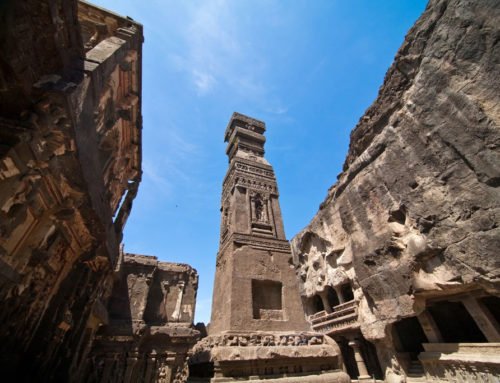
Aurangabad: Our Experience
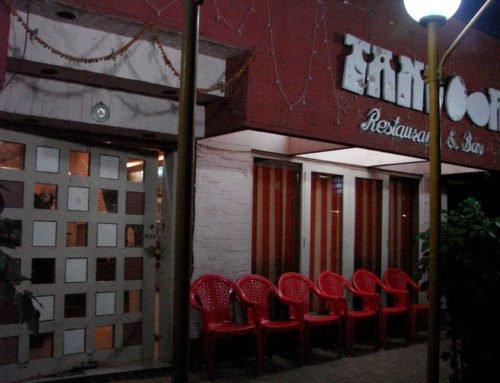
Tandoor Restaurant Aurangabad
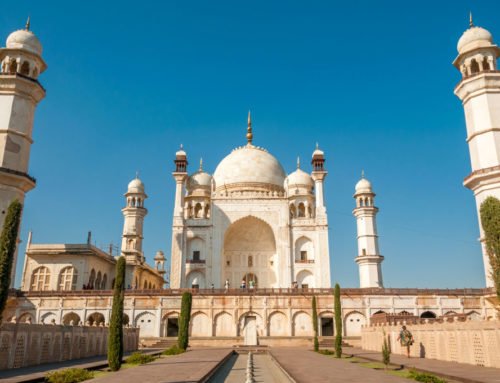
Bibi ka Maqbara Aurangabad
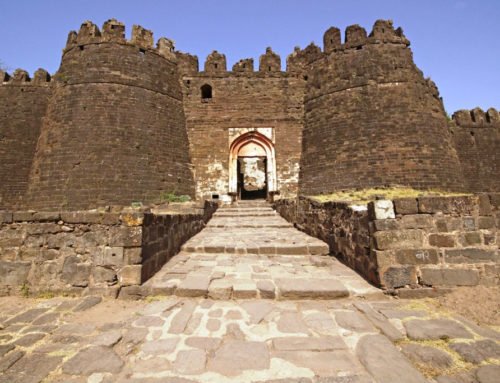
Daulatabad Fort Aurangabad
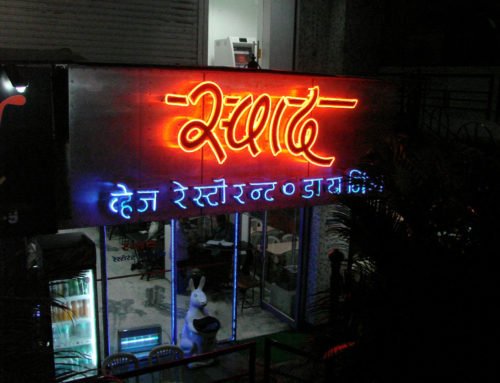
Swad Restaurant Aurangabad
My wife is not very mobile, is there a way for her to be able to see some of these caves? Do some have wheel chair access?
Hi Reece, There are Palanquins available for the less mobile visitors. There are attendants ready to carry your wife around, both up and down the many stair cases. This is one of those attractions where she will be well looked after.
Just wanted to let you know that the information on this page is so detailed and thorough. I will be reading this page when I go to Ellora Caves. Thank you.
Enjoy your trip to Ellora Caves. 🙂
I enjoy what you guys tend to be up too. This kind of clever work and coverage! Keep up the wonderful works guys.
Comments are closed.
Ajanta and Ellora Caves
View hotels for your date, ajanta and ellora caves travel essentials.
Ideal duration: 1-2 days
Best Time: June to March Read More
Planning a Trip? Ask Your Question
"World Heritage Ancient Rock-Cut Caves"
Ajanta and ellora caves tourism.
Ajanta and Ellora caves, considered to be one of the finest examples of ancient rock-cut caves, are located near Aurangabad in Maharashtra, India. Ajanta and Ellora caves complex is adorned with beautiful sculptures, paintings, and frescoes and include Buddhist monasteries, Hindu and Jain temples. The Ajanta caves are 29 in number and were built between the 2nd century BC and 6th century AD, whereas the Ellora Caves are more spread out and 34 in number and dates to the period between 6th and 11th Century AD.
Ajanta and Ellora caves are designated as UNESCO World Heritage Sites and are quite popular among travelers worldwide. Ajanta Caves, located around 99km north of Aurangabad, are mostly Buddhist sites and were used as a retreat by Buddhist Monks. Ellora is just 15 km west of Aurangabad and has a better mix of Hindu, Jain, and Buddhist sites. These hand-carved caves were built and sponsored by the Indian rulers of those periods and almost buried by thick forests. One of the most famous places in the entire Ajanta and Ellora Caves is the Kailash Temple, which is also the single most massive monolithic structure globally. These rock-cut caves containing carvings are some of the best examples of ancient Indian architecture and sculpture.
Things to do in Ajanta and Ellora Caves
1. ajanta caves.

2. Grishneshwar Temple, Ellora

3. The Buddhist Caves, Ellora

4. Bibi Ka Makbara, Aurangabad

5. Jain Caves, Ellora

6. Khuldabad

7. Daualatabad fort, Daulatabad

8. Aurangabad caves, Aurangabad

9. Shopping In Aurangabad

10. Panchakki, Aurangabad

11. The shopping plaza

12. Shopping in Ajanta and Ellora

Top Hotels In Ajanta and Ellora Caves
7.7 (182 reviews)
₽ 3,107 onwards
7.6 (202 reviews)
₽ 1,997 onwards
8.4 (20 reviews)
₽ 2,497 onwards
7.8 (6 reviews)
₽ 3,416 onwards
5.2 (4 reviews)
₽ 1,664 onwards
3.0 (3 reviews)
₽ 1,412 onwards
More on Ajanta and Ellora Caves Travel
A walk through the history, restaurants and local food in ajanta and ellora caves, suggested itinerary for ajanta and ellora caves, best time to visit ajanta and ellora caves, top stories about ajanta and ellora caves tourism.

Art & Culture
5 Ajanta Caves Paintings You Need To See
Ajanta Caves History : A Walk Into the Past of Rock-Cut Caves
Nearby Places

Ajanta and Ellora Caves Photos

+ 41 photos
How To Reach Ajanta and Ellora Caves
Faqs on ajanta and ellora caves, what is the best time to visit ajanta and ellora caves, what are the places near ajanta and ellora caves, what are the things to do in ajanta and ellora caves, what is the best way to reach ajanta and ellora caves, what is the local food in ajanta and ellora caves, who should visit ajanta and ellora caves, what is not so good about ajanta and ellora caves, what is famous about ajanta and ellora caves, have a question on ajanta and ellora caves.

Popular Questions And Answers on Ajanta and Ellora Caves
Q. What are the places to eat around the caves?

Surbhi Parashar
Q. 1) What about the vegetarian food near Ajanta caves ? 2) Is there any decent lodges near Ajanta Caves ? 3) What is the distance between Aurangabad & Ajanta ? 4) Which choice you suggest to stay ? - Auarangabad or Aanta ?
Nibha Chaudhuri
Q. in one day we can visit ajanta and ellora caves from mumbai
Ajanta and Ellora Caves Reviews
Sanika Ovhal
Kamaljit Singh
Kovid Kapoor
Similar Places

Get the best offers on Travel Packages
Compare package quotes from top travel agents
Compare upto 3 quotes for free
- India (+91)
*Final prices will be shared by our partner agents based on your requirements.
Log in to your account
Welcome to holidify.
Forget Password?
Share this page

15 Extraordinary Facts About Ellora Caves
Written by Madonna Champagne
Modified & Updated: 21 May 2024
Reviewed by Sherman Smith
- Architectural Marvel Facts
- Historical Monuments Facts
- Religious Pilgrimage Site Facts
- Unesco World Heritage Site Facts
- World Heritage Site Facts

The Ellora Caves in India are a marvel of ancient architecture and craftsmanship. Located in the state of Maharashtra, these impressive caves are a UNESCO World Heritage site and attract visitors from all over the world. The caves, dating back to the 6th and 10th centuries, showcase a stunning blend of Hindu, Buddhist, and Jain religious elements, making them a unique and fascinating destination for history enthusiasts.
In this article, we will delve into 15 extraordinary facts about the Ellora Caves that will further deepen your appreciation for this incredible landmark. From the stunning rock-cut sculptures to the mysterious origins of the caves, each fact will uncover a fascinating aspect of the Ellora Caves, shedding light on the remarkable craftsmanship and cultural significance of this ancient site.
Key Takeaways:
- The Ellora Caves, a UNESCO World Heritage Site in India, showcase a blend of Hindu, Buddhist, and Jain art, reflecting the rich cultural diversity and architectural brilliance of ancient India.
- The caves, including the largest monolithic sculpture in the world, the Kailasa Temple, have inspired art, literature, and restoration efforts, attracting visitors from around the world to witness their historical significance.
The Ellora Caves are a UNESCO World Heritage Site
The Ellora Caves, located in the Aurangabad district of Maharashtra, India, have been designated as a UNESCO World Heritage Site due to their outstanding cultural and architectural significance. This complex of caves is a testament to the rich and diverse history of India.
There are a total of 34 caves in the Ellora Caves complex
The Ellora Caves complex is home to 34 magnificent caves, each representing a unique blend of Hindu , Buddhist, and Jain art and architecture. These caves were meticulously carved out of the surrounding volcanic rock over a period of several centuries.
The caves were constructed between the 6th and 10th centuries
The construction of the Ellora Caves spanned a period of around four centuries, starting from the 6th century and continuing up until the 10th century . This long timeline showcases the evolution of architectural styles and religious influences during that era.
The Kailasa Temple is the largest monolithic sculpture in the world
One of the most awe-inspiring caves in the Ellora complex is Cave 16, also known as the Kailasa Temple. This cave temple is an architectural marvel, carved entirely out of a single rock and is considered to be the largest monolithic sculpture in the world.
The Ellora Caves showcase an impressive synthesis of different religious beliefs
One of the most remarkable aspects of the Ellora Caves is the seamless integration of different religious traditions. The caves feature Hindu deities like Lord Shiva, Vishnu, and Durga, alongside Buddhist sculptures depicting various Bodhisattvas and Jain Tirthankaras.
Cave 10 is renowned for its exquisite Buddhist sculptures
Cave 10, also known as the Vishvakarma cave, houses some of the most exquisite Buddhist sculptures in the Ellora Caves complex. The intricate carvings and delicate details are a testament to the skill and craftsmanship of the ancient artisans.
The Jain caves reflect the principles of non-violence and simplicity
The Jain caves in Ellora, particularly Cave 32, exemplify the principles of non-violence and simplicity that are central to Jainism. The sculptures and reliefs found in the Jain caves depict scenes from the lives of Jain Tirthankaras and convey a sense of serenity and tranquility.
The Ellora Caves have influenced various architectural styles
The grandeur and intricacy of the Ellora Caves have had a profound impact on the development of architecture in the region. The cave temples served as a source of inspiration for subsequent architectural styles, including the medieval rock-cut temples of South India.
The caves are a testament to the artistic and engineering skills of ancient India
The construction of the Ellora Caves required immense artistic and engineering skills . The ancient artisans used primitive tools to carve out the caves with exceptional precision, showcasing the advanced knowledge and craftsmanship of ancient India.
Each cave has its own unique architectural and sculptural features
One of the fascinating aspects of the Ellora Caves is the distinctiveness of each cave. Every cave has its own unique architectural layout and sculptural motifs, providing visitors with a diverse and captivating experience as they explore the complex.
The Ellora Caves underwent a period of decline and abandonment
After centuries of patronage and worship, the Ellora Caves eventually fell into a state of decline and abandonment. Following the rise of Islam in the region, the caves were largely forgotten until their rediscovery by British colonial officers in the 19th century.
Restoration efforts have preserved the beauty of the Ellora Caves
In recent years, extensive restoration work has been undertaken to preserve and protect the Ellora Caves. These efforts have ensured that future generations can continue to appreciate the intricate carvings and architectural brilliance of this UNESCO World Heritage Site.
The caves attract visitors from around the world
The allure of the Ellora Caves extends far beyond the borders of India. Every year, thousands of visitors from across the globe come to witness the beauty and historical significance of this extraordinary site, immersing themselves in the rich cultural heritage it represents.
The Ellora Caves have inspired numerous works of art and literature
The captivating beauty and historical importance of the Ellora Caves have inspired countless artists, writers, and poets. The caves have served as the subject of paintings, photographs, and literary works, contributing to the continued fascination and appreciation of this architectural marvel.
The Ellora Caves remain a testament to the cultural diversity of India
As a site that harmoniously brings together different religious and artistic traditions, the Ellora Caves stand as a compelling reminder of the cultural diversity that has shaped India’s heritage. It serves as a symbol of unity and tolerance, highlighting the richness of India’s past.
In conclusion, the Ellora Caves are truly remarkable and have captivated visitors for centuries. These caves not only showcase exceptional architectural skills but also offer valuable insights into the rich cultural and religious heritage of India. From the intricate carvings to the grand temples, each cave tells its unique story.Visiting the Ellora Caves is like stepping back in time and experiencing the wonders of ancient India. Whether you are an art enthusiast, history buff, or simply someone seeking awe-inspiring sights, the Ellora Caves will not disappoint.So next time you find yourself in Maharashtra, make sure to carve out some time to explore the magnificent Ellora Caves. Prepare to be amazed by their beauty, inspired by their craftsmanship, and humbled by their historical significance.
1. How old are the Ellora Caves?
The Ellora Caves date back to the 6th and 10th centuries, representing a span of several centuries of construction.
2. How many caves are there at Ellora?
There are a total of 34 caves at Ellora, which comprise temples, monasteries, and chapels.
3. Are Ellora Caves only Hindu temples?
No, the Ellora Caves are a unique blend of Hindu, Buddhist, and Jain traditions, making them a symbol of religious harmony.
4. How long does it take to explore the Ellora Caves?
The time required depends on the level of exploration and interest. However, a comprehensive visit to the Ellora Caves can take around 4 to 6 hours.
5. Can I hire a guide at Ellora Caves?
Yes, there are several knowledgeable guides available at Ellora to provide insights into the history, significance, and architectural details of the caves.
Inspired by the extraordinary facts about Ellora Caves? Continue your exploration of this magnificent UNESCO World Heritage Site with our article on 14 astounding facts that will leave you even more amazed. From the intricate details of the sculptures to the fascinating history behind the caves' creation, there's still so much more to discover about this ancient wonder.
Was this page helpful?
Our commitment to delivering trustworthy and engaging content is at the heart of what we do. Each fact on our site is contributed by real users like you, bringing a wealth of diverse insights and information. To ensure the highest standards of accuracy and reliability, our dedicated editors meticulously review each submission. This process guarantees that the facts we share are not only fascinating but also credible. Trust in our commitment to quality and authenticity as you explore and learn with us.
Share this Fact:

IMAGES
COMMENTS
There are 34 caves at Ellora dating from between the 6th and 11th centuries AD, and 29 caves at Ajanta dating back to between the 2nd century BC and 6th century AD. The caves at Ajanta are all Buddhist, while the caves at Ellora are a mixture of Buddhist, Hindu and Jain. Funds for the construction of the caves were provided by various rulers.
Best time to visit Ellora Caves. You can visit Ajanta Ellora Caves at any time except for the peak summer months. It's in May and June when the weather can be unbearable, especially in the daytime. Winter is the best time to visit Ellora Caves. The temperature sees a moderate drop during the winter months, from November to February, and it ...
The Ellora Caves are authentic in terms of the forms and designs, materials and substance, and locations and setting of paintings, rock-cut architecture, sculptures, and unfinished temples of three different faiths, i.e. Buddhism, Brahmanism, and Jainism. Protection and management requirements. The management of the Ellora Caves is carried out ...
Ellora Caves are in the state of Maharashtra in western India. The village of Ellora is close by and the city of Aurangabad is 30 km (19 miles) away. Many tourists also explore the Ajanta Caves when they are in this area. The mere 80 km (50 miles) distance between the sites would allow for a fantastic two-day trip.
The best time to visit Ellora Caves is during the months of June to February while the peak season is from October to January. These are the best time to visit Ellora Caves, as the weather is really pleasant during these months. Cave Timings: 6 AM to 6 PM on all days except Tuesdays. Entrance Fee: Rs. 10 for Indians and Rs. 250 for Foreigners.
The Ellora Caves are a UNESCO World Heritage Site in Aurangabad district, Maharashtra, India (now renamed to Chhatrapati Sambhaji Nagar district).It is one of the largest rock-cut Hindu temple cave complexes in the world, with artwork dating from the period 600-1000 CE, also including several Buddhist and Jain "caves". The complex is a leading example of Indian rock-cut architecture, and ...
The best time to visit Ellora Caves is during November to March. How to Reach Ellora Caves. Situated almost 27 km from Aurangabad city, Ellora Caves can be reached easily via buses and taxis. There are private taxi stands in Aurangabad which offer a trip to the caves and back starting at Rs 1,000 depending on the car type. The drive will take ...
Visit Ellora Caves from Aurangabad. Similar to the Ajanta Caves, the Ellora Caves also feature ancient Buddhist artwork. Additionally, you can also find Jain and Hindu artwork at the Ellora Caves. With over 40 caves at the complex, there is plenty to see. The oldest caves date back almost 1500 years and the Ellora Caves are also UNESCO-listed.
The Ellora caves, locally known as 'Verul Leni' is located on the Aurangabad-Chalisgaon road at a distance of 30 km north-northwest of Aurangabad, the district headquarters. ... (Cave 16). The visit to these caves is enjoyed maximum during monsoon, when every stream is filled with rainwater, and the entire environ is lush green. The monsoon ...
Ellora, considered the finest examples of rock-cut architecture, comprises Hindu, Buddhist and Jain caves that were chiselled between the 4th and the 9th century. Of the 34 caves, 12 are Buddhist, 17 Hindu and 5 Jain, and date back to the Rashtrakuta dynasty, about 1,500 years ago. They were declared a World Heritage Site in 1983, and are now ...
Visit the Jain Caves, numbered Cave 32 and Cave 33. Lunch near Ellora Caves, enjoying local cuisine. Visit the Buddhist Caves, particularly Cave 2 and Cave 5. Explore the Kailasa Temple and its details, architectural grandeur and other facts. Relax while watching the sunset from the Ellora Caves. Return back to Aurangabad in the evening.
Kailasa Temple / Kailasanath Temple / Cave 16. Heritage. #1 of 21 Places to Visit in Ellora Caves. At a distance of 300 m from Ellora Caves Bus Stop, Kailasa Temple is the largest rock-cut ancient Hindu temple in Ellora, Maharashtra. It is the prime attraction of Ellora tour packages.
Famous Places To Visit in Ellora Caves (1-34) Among the 34 Ellora Caves given access to the general public, most caves have just sculptures and paintings. However, a group of 7-8 caves between 13-29 have impressive architecture. Read along to know the famous places to visit in Ellora Caves.
Ajanta Ellora Caves have always been recognized as the gems that represent Indian history and the impressive artistry that existed in the foregone era. These tourist attractions consist of 64 rock-cut caves, located in close proximity from the city of Aurangabad. Today, Ajanta and Ellora Caves are a UNESCO World Heritage Site and exist in the wishlist of many travelers.
Ajanta and Ellora Caves are two of the most famous tourist attractions near Aurangabad city, located in the Indian state of Maharashtra. Both of these sites are UNESCO World Heritage sites and are known for their intricate carvings and paintings that showcase the rich history and culture of India. Ajanta Caves, which were discovered in the 19th ...
The Ellora Caves are an amazing place to visit! This is also a UNESCO World Heritage Site and a place full of experiences that you can't find anywhere else in the world. The architecture is incredible and you'll get an impressive peak into the cultures and religions that peacefully coexisted there!
Ellora Caves are an impressive complex of rock shrines that represent the three faiths of Buddhism, Hinduism and Jainism and were created between the 5th and the 13th centuries CE. ... Visit Cave 31, which is an extended part of Cave 32. Also, the Jagannath Sabha, Cave 33 is a look-alike of Cave 32 and has some well-preserved sculptures one ...
Ellora (also known as Elura and, in ancient times, as Elapura) is a sacred site in Maharastra, central India.The Ellora Caves are listed by UNESCO as a World Heritage Site and is celebrated for its Hindu, Buddhist, and Jain temples and monuments which were carved from the local cliff rock in the 6th to 8th century CE.The most spectacular example is the 8th century CE Kailasa temple which, at ...
The Jain caves (nos. 30-34) are some distance away and we skipped them as we had to return to the city. How to visit Ajanta and Ellora Caves. Pin Ajanta Caves are located 100km north of Aurangabad and take almost 3 hours to reach (road conditions are variable). They are open from 9 a.m. until 5 p.m., daily except Mondays.
The Ellora caves face west and therefore are best seen in the afternoon. The best way to see the caves is to start at the south end and visit the Buddhist viharas first (Nos 1-12), followed by the Jain caves at the north end (Nos 29-34) and finally ending with the Hindu caves (Nos 13-28). This allows the Hindu Kailasnatha temple to be seen ...
The Ajanta caves are 29 in number and were built between the 2nd century BC and 6th century AD, whereas the Ellora Caves are more spread out and 34 in number and dates to the period between 6th and 11th Century AD. Ajanta and Ellora caves are designated as UNESCO World Heritage Sites and are quite popular among travelers worldwide.
The best times time visit Ellora Caves are during the monsoon season (June to September) and in the winter from October to February. During and immediately after monsoons is a great time to visit, as the vegetation is lush and green. Additionally, after monsoons, there are exciting streams and waterfalls forming randomly amongst the caves.
The Ellora Caves in India are a marvel of ancient architecture and craftsmanship. Located in the state of Maharashtra, these impressive caves are a UNESCO World Heritage site and attract visitors from all over the world. The caves, dating back to the 6th and 10th centuries, showcase a stunning blend of Hindu, Buddhist, and Jain religious ...